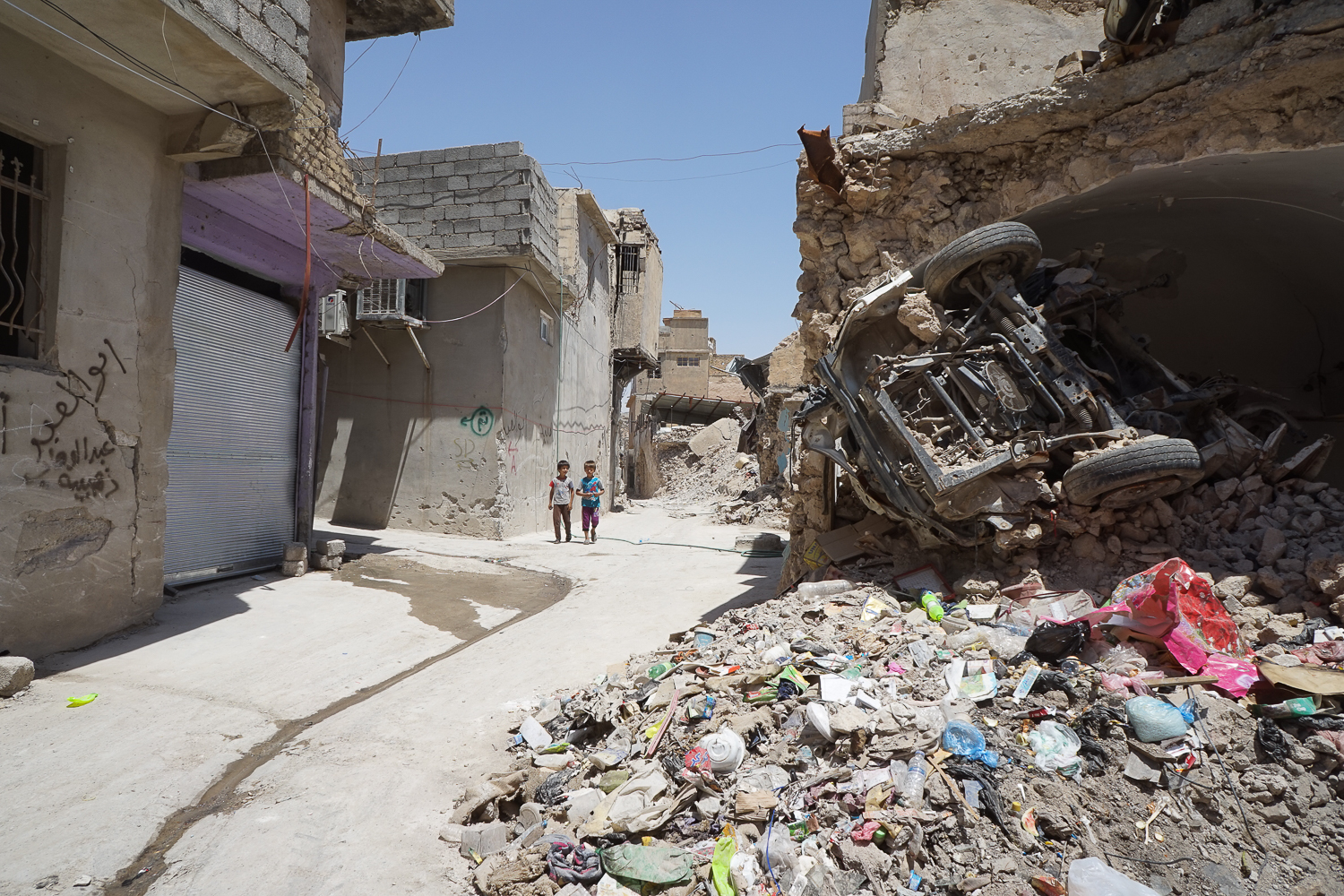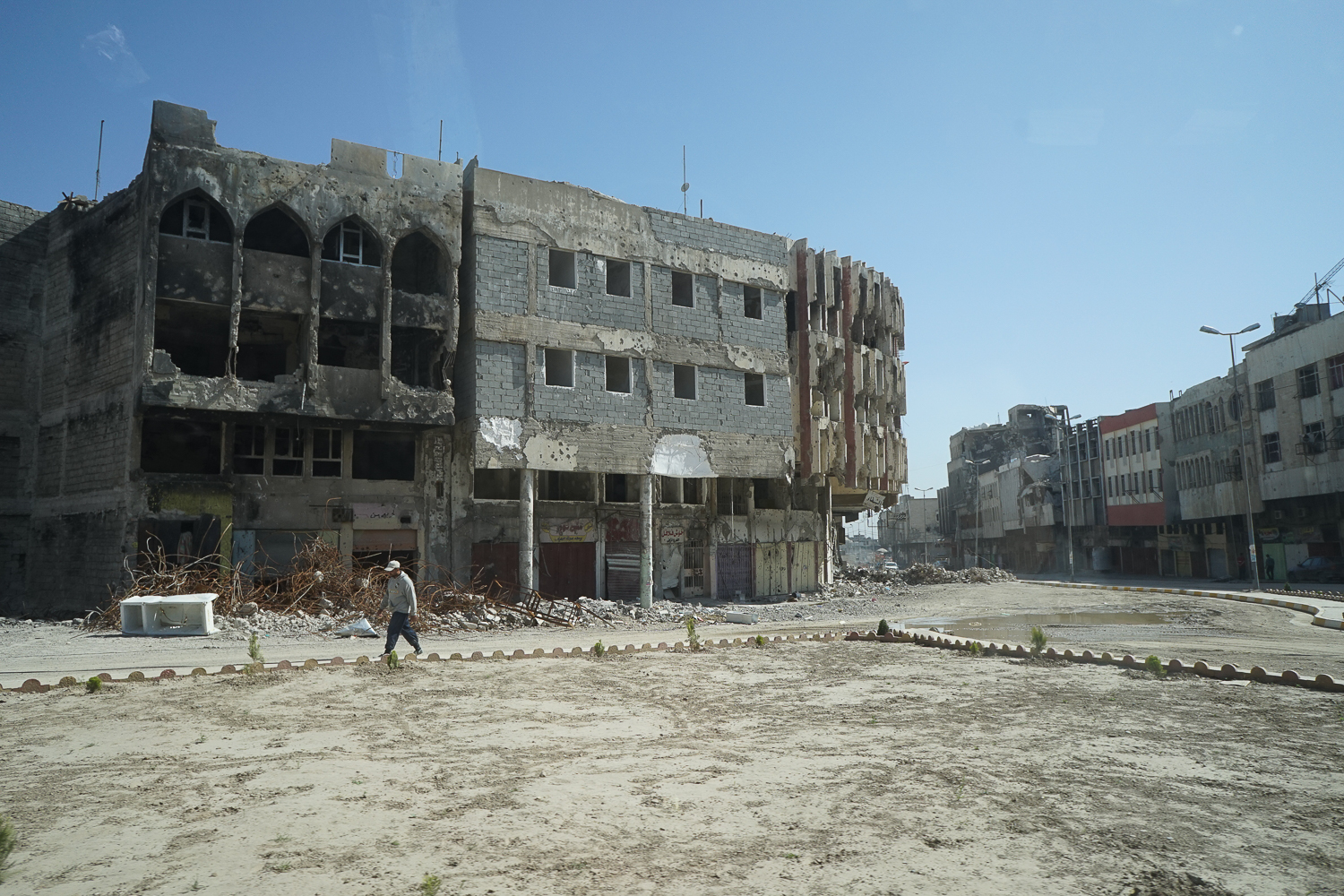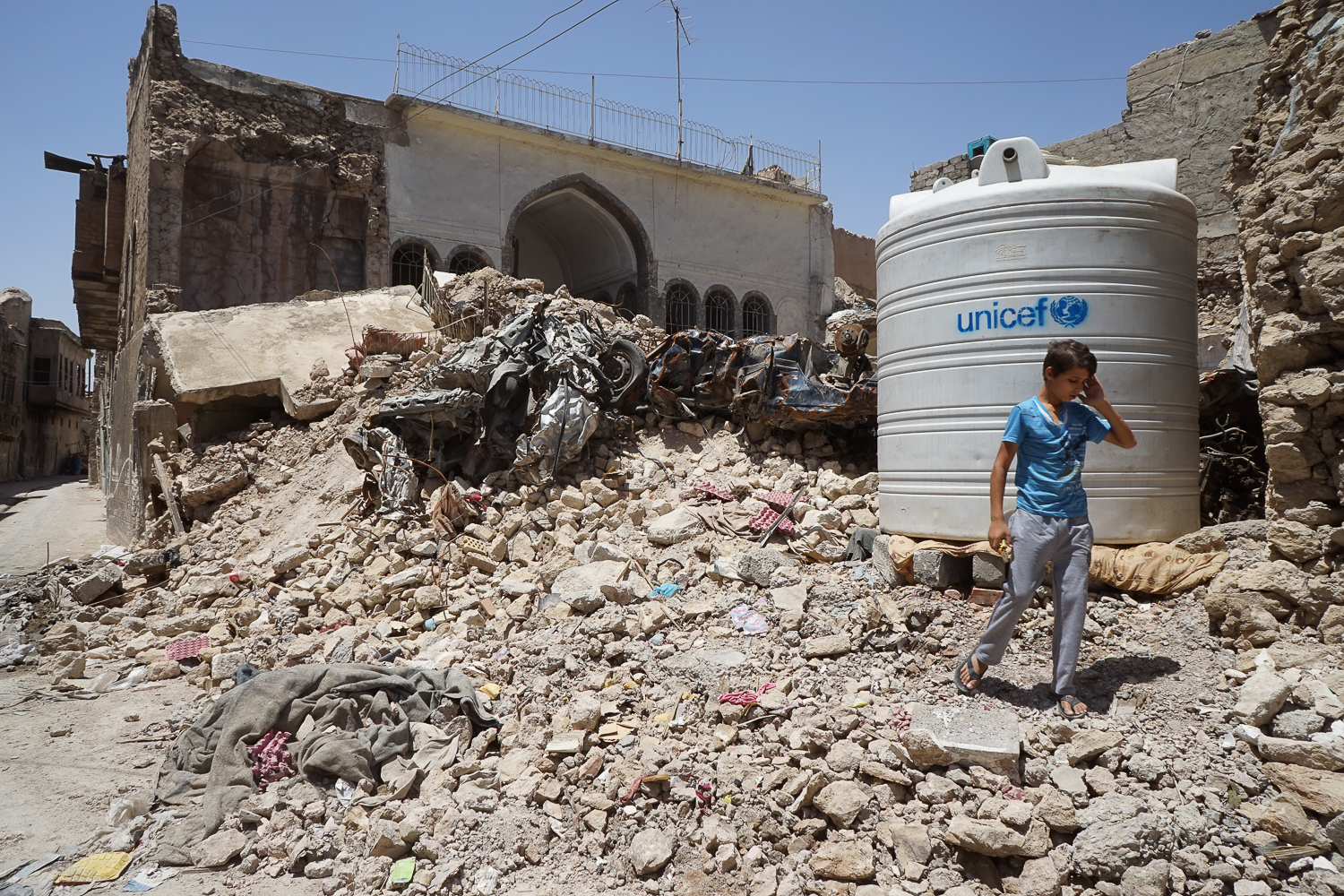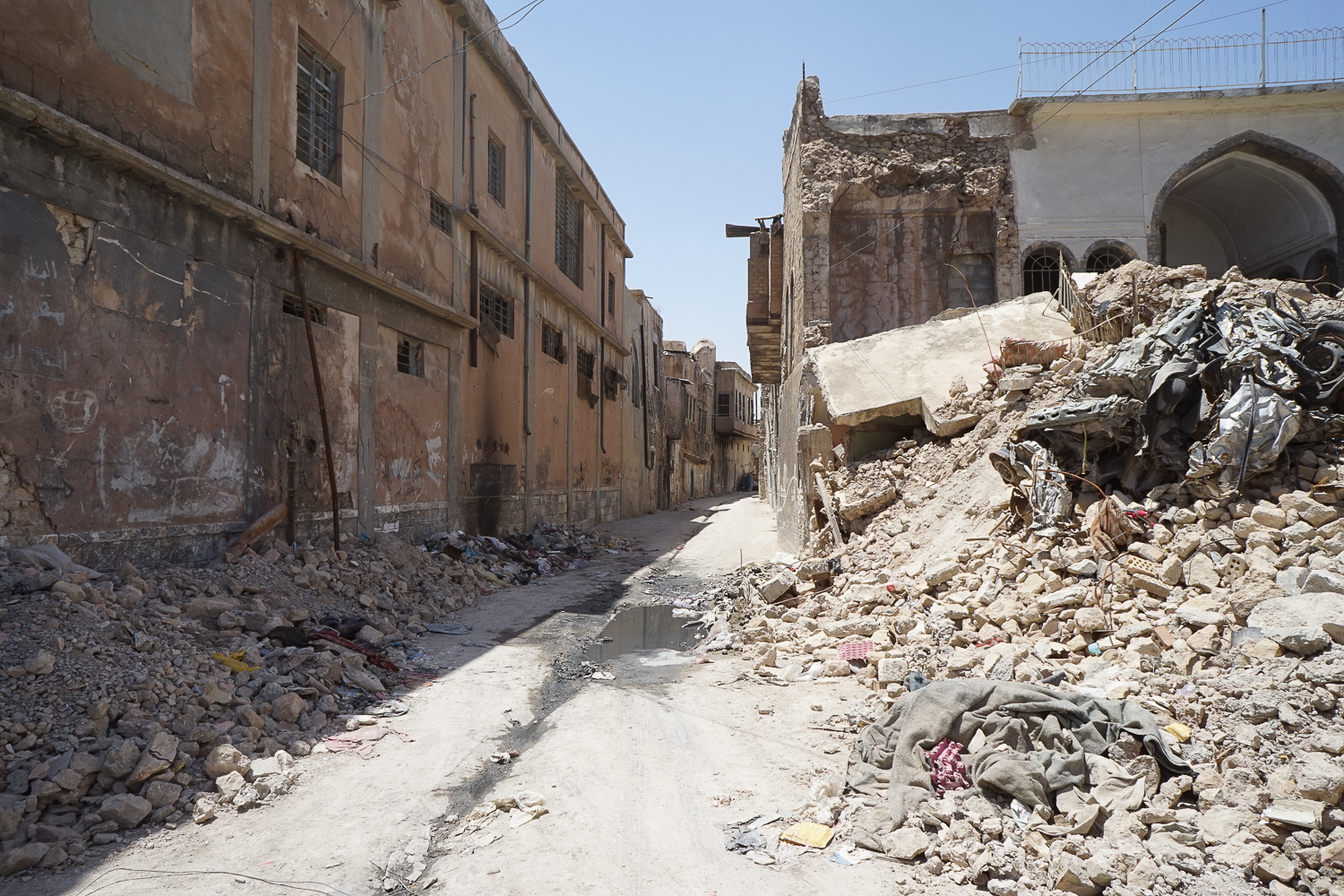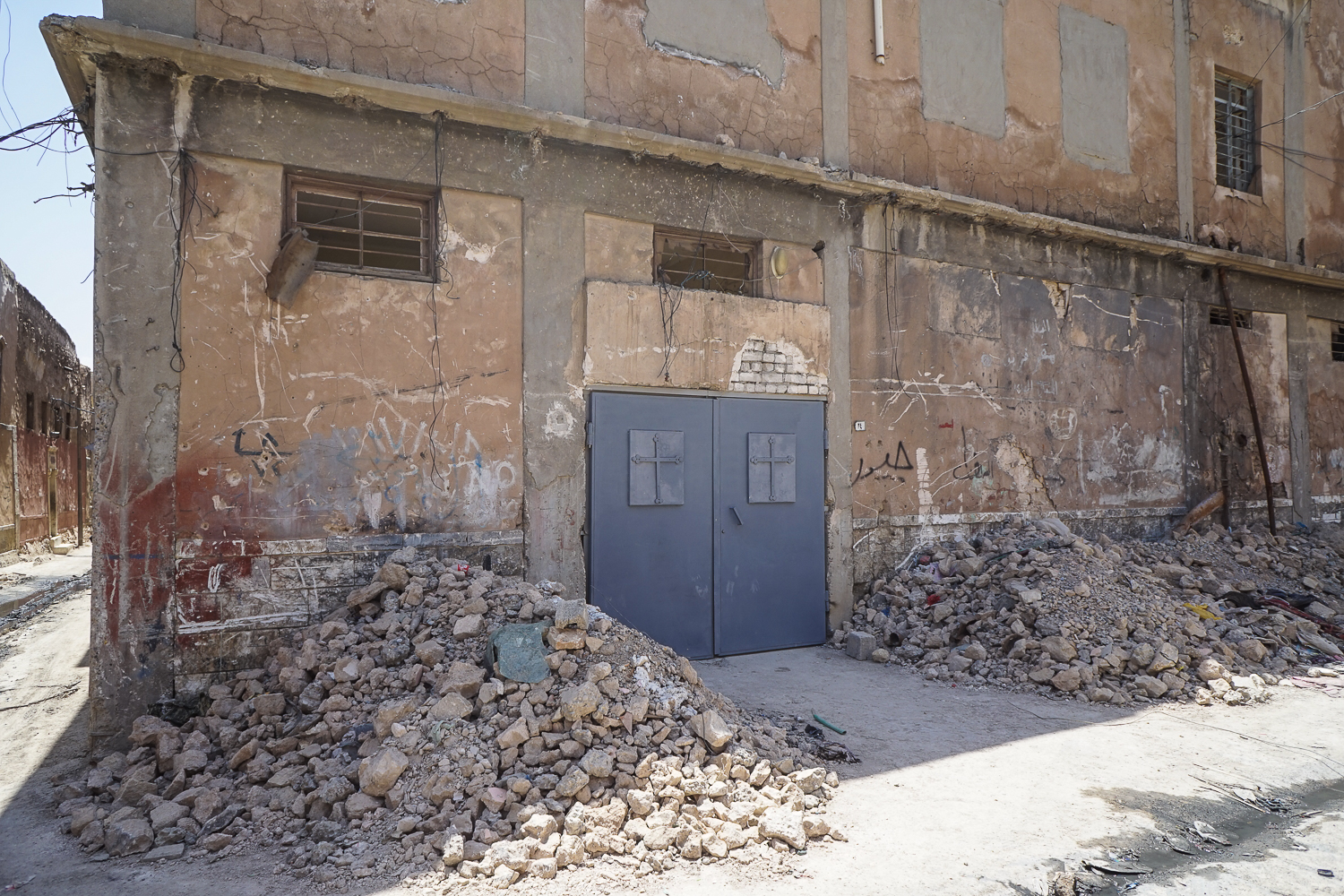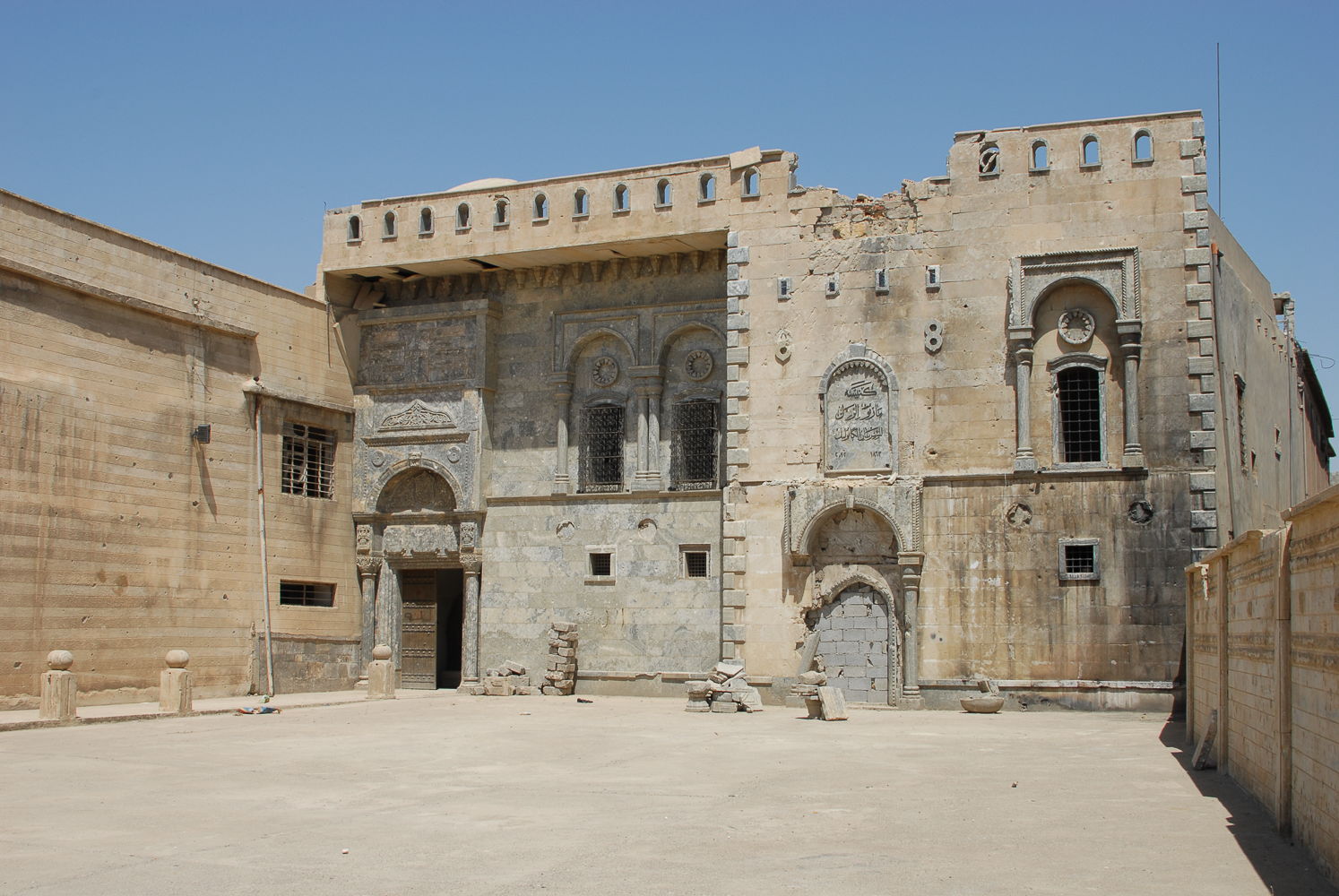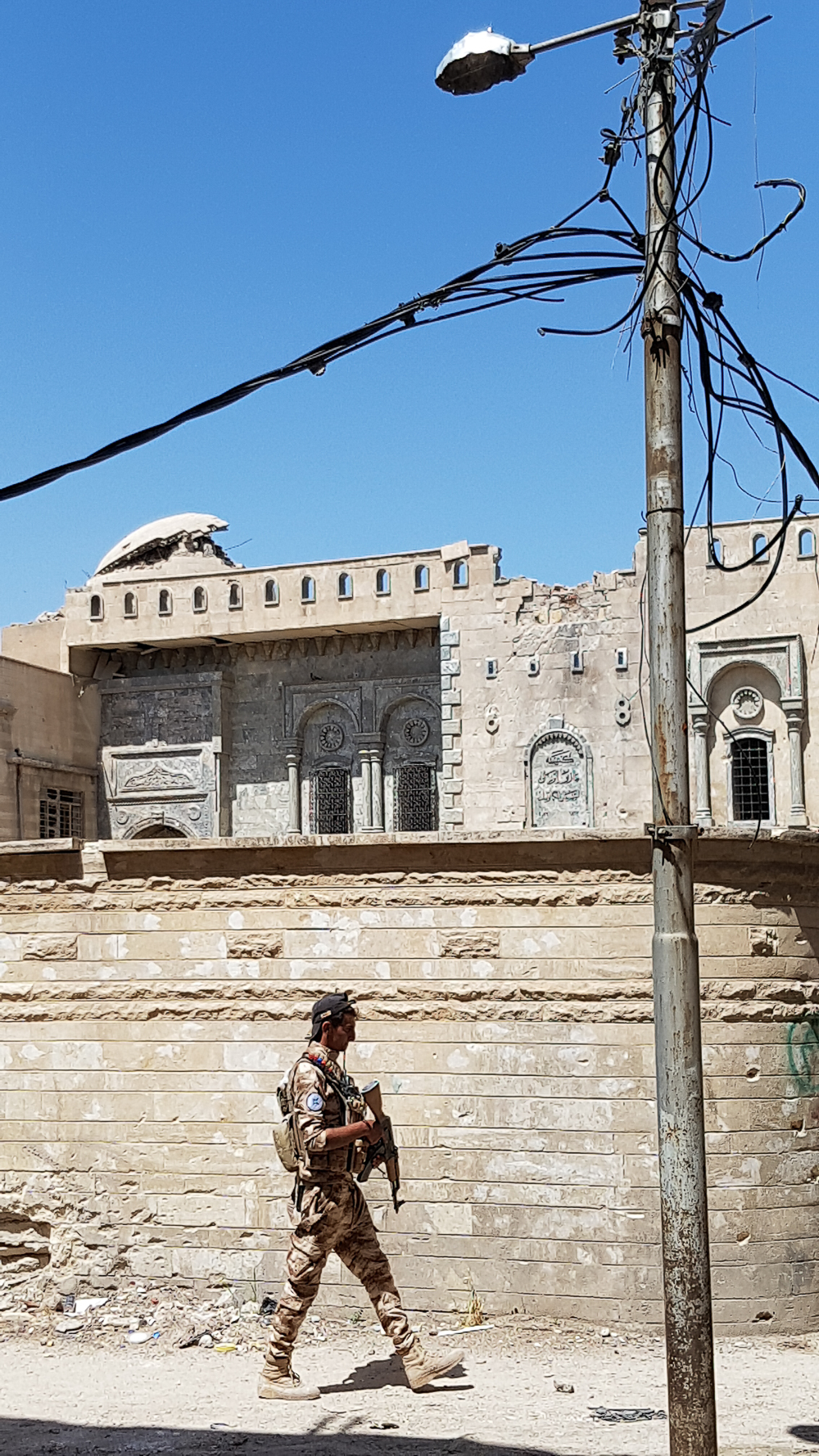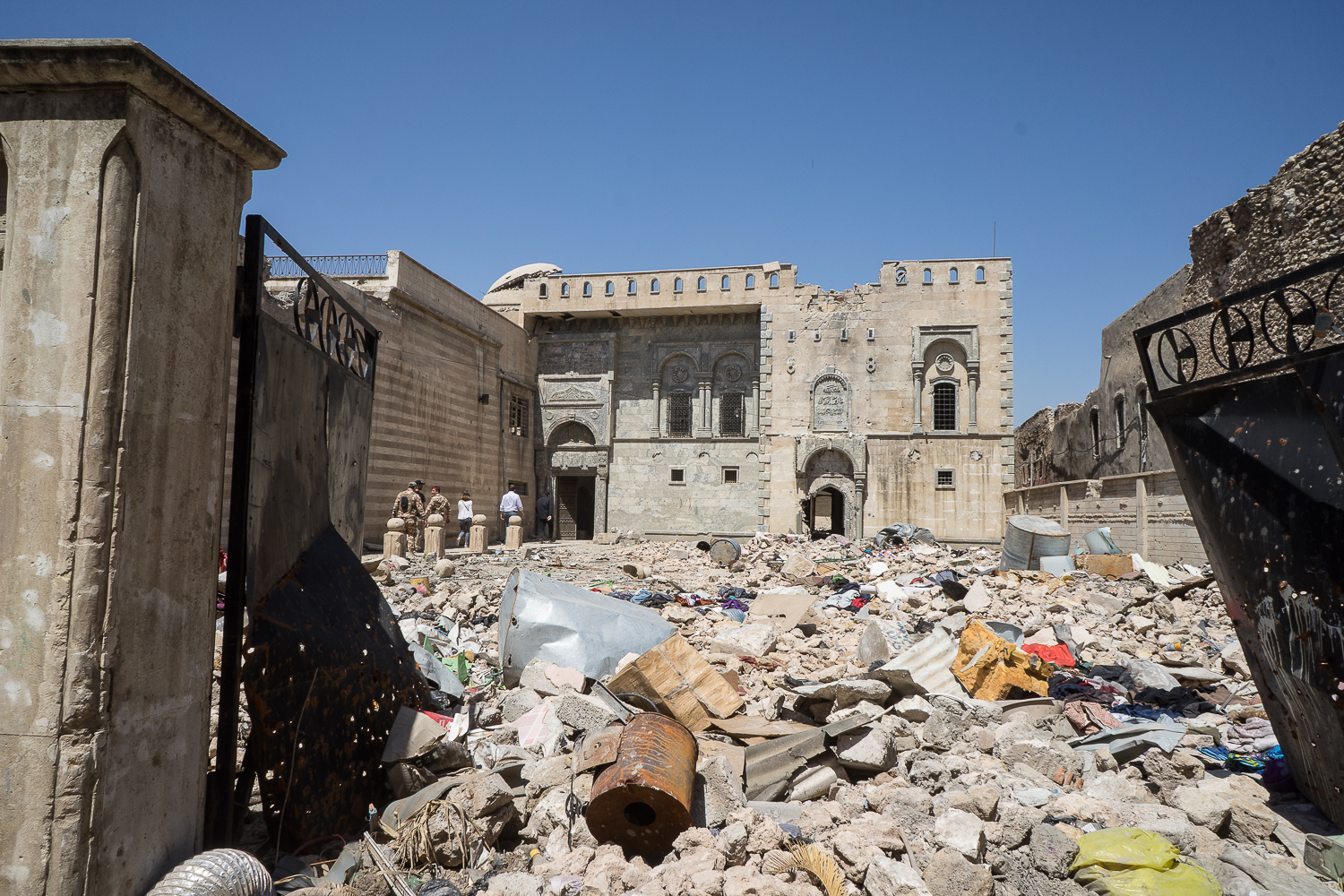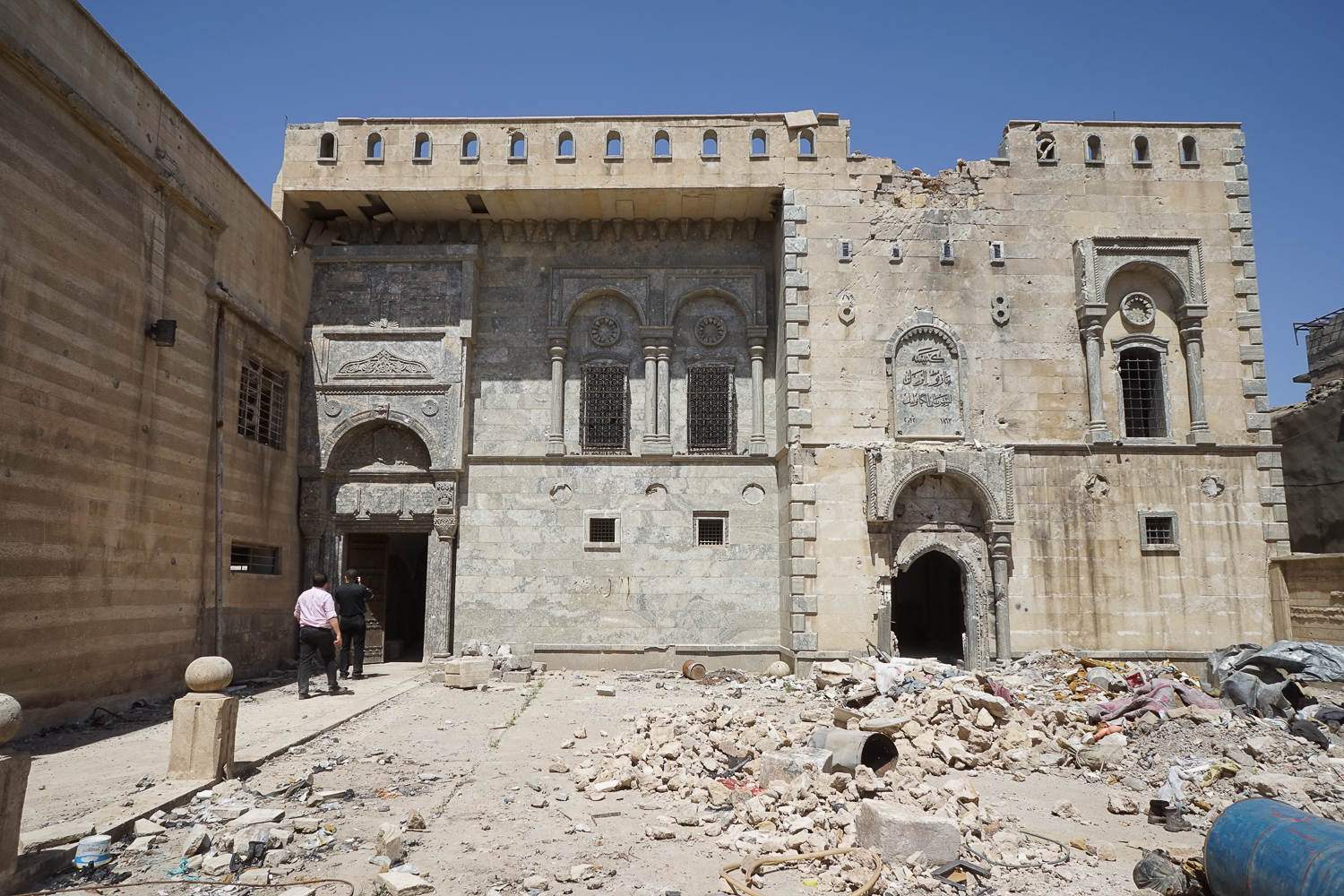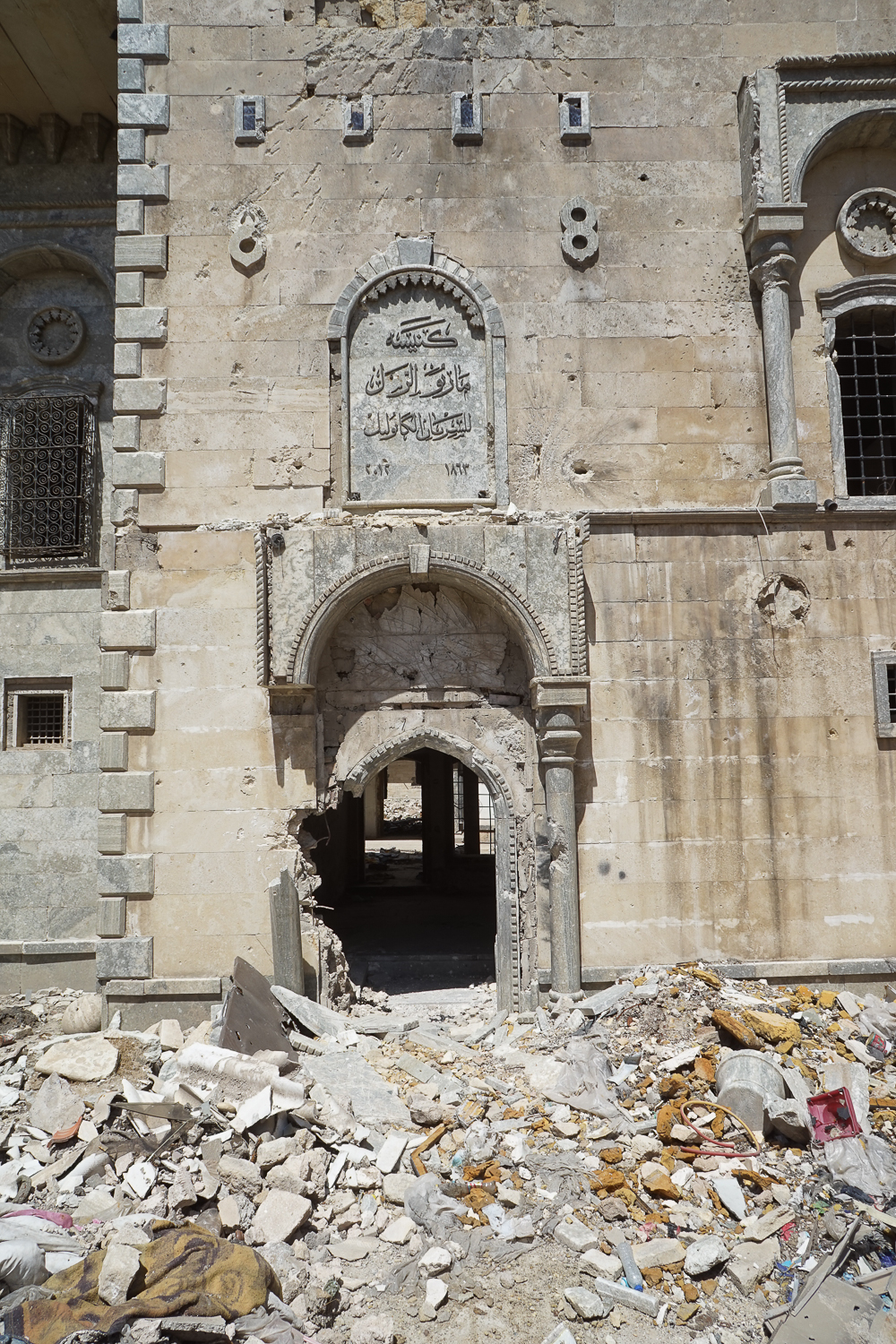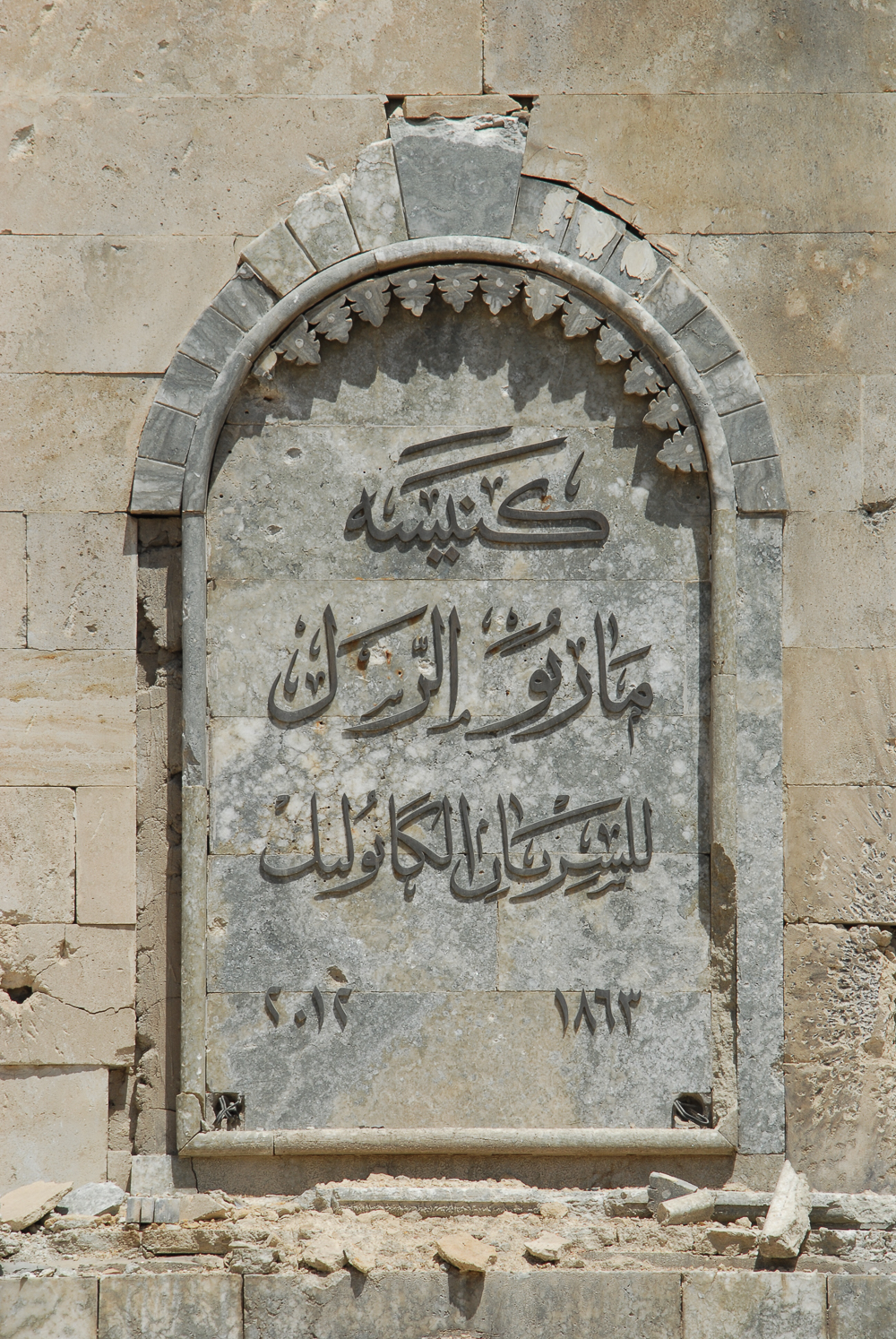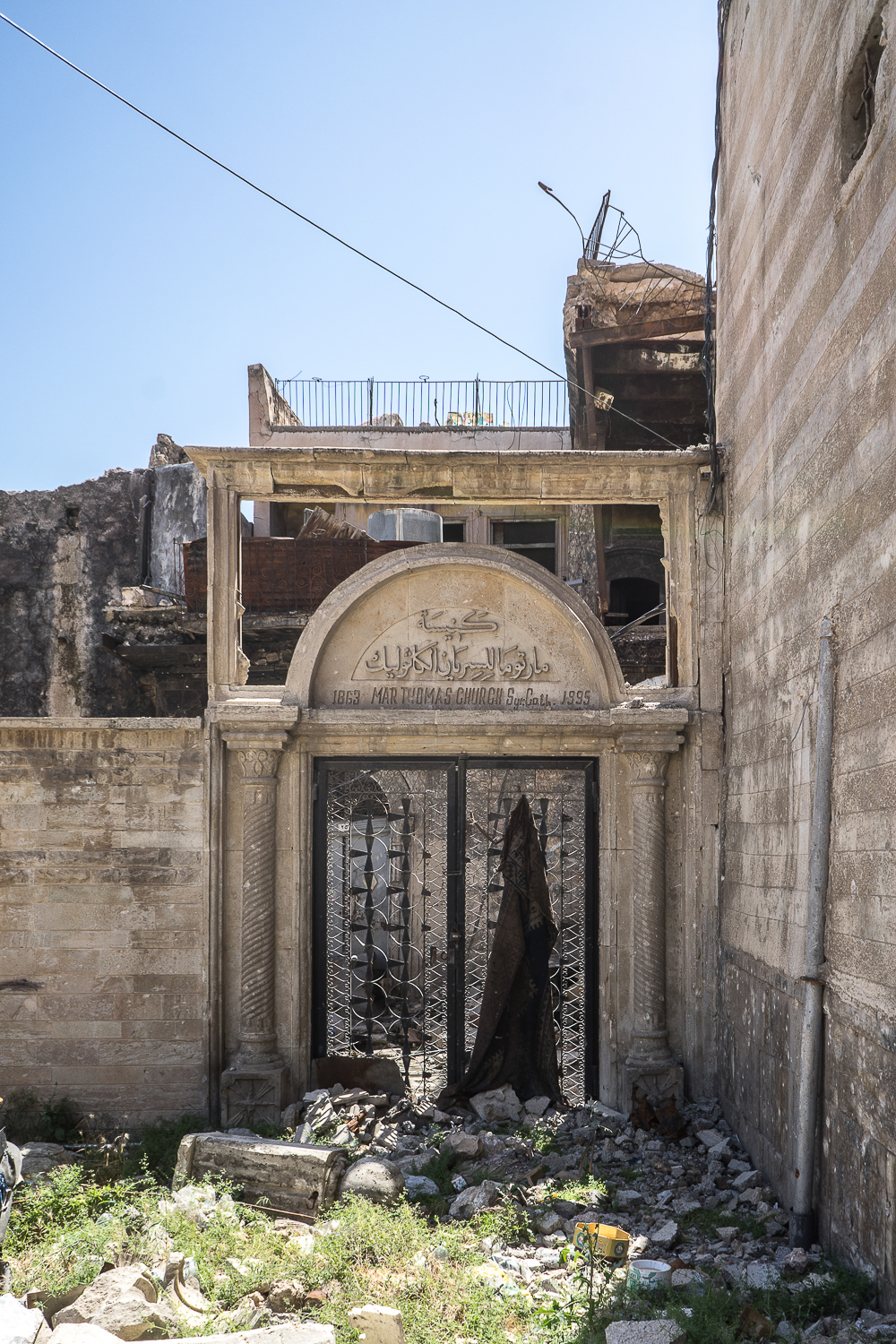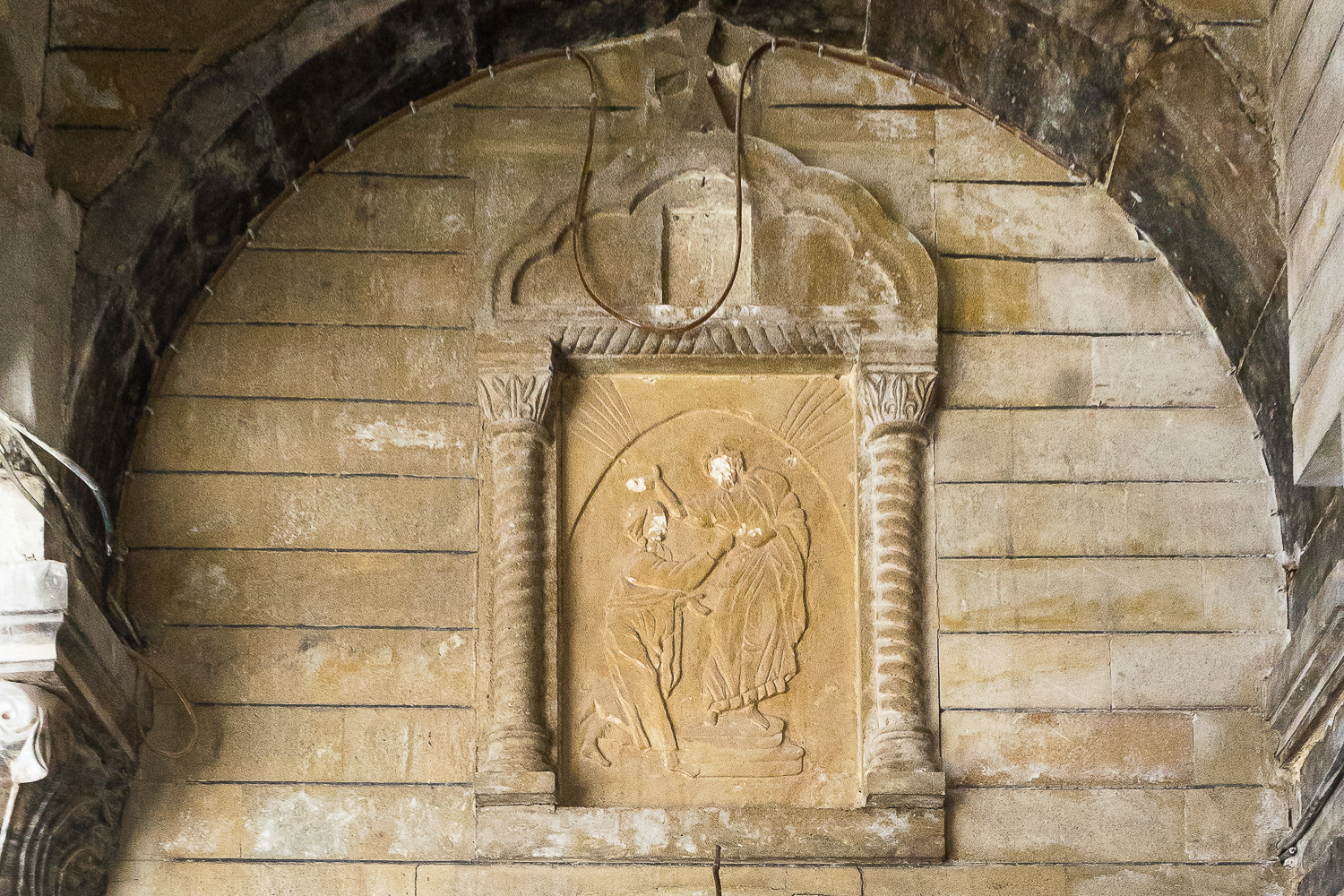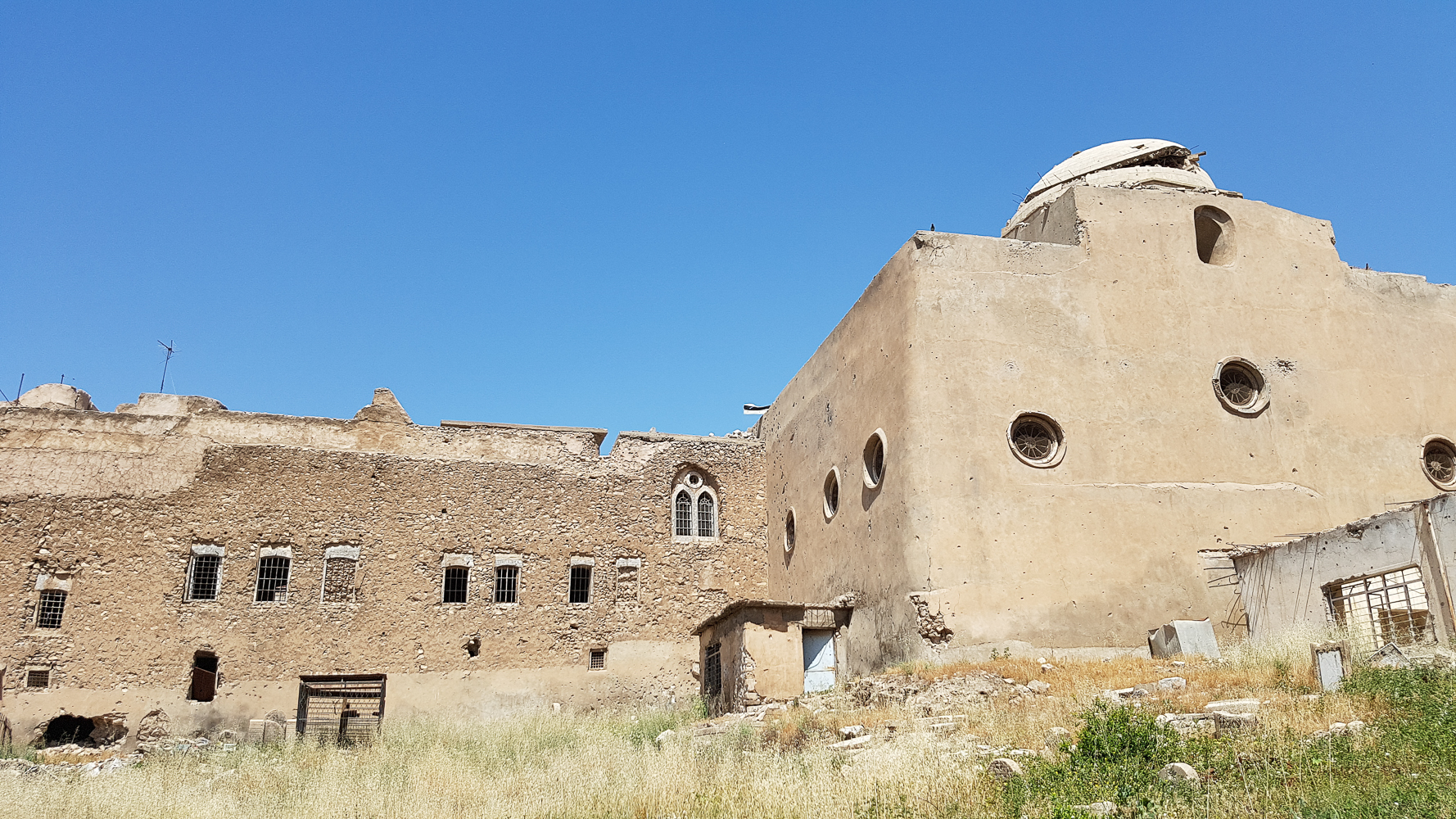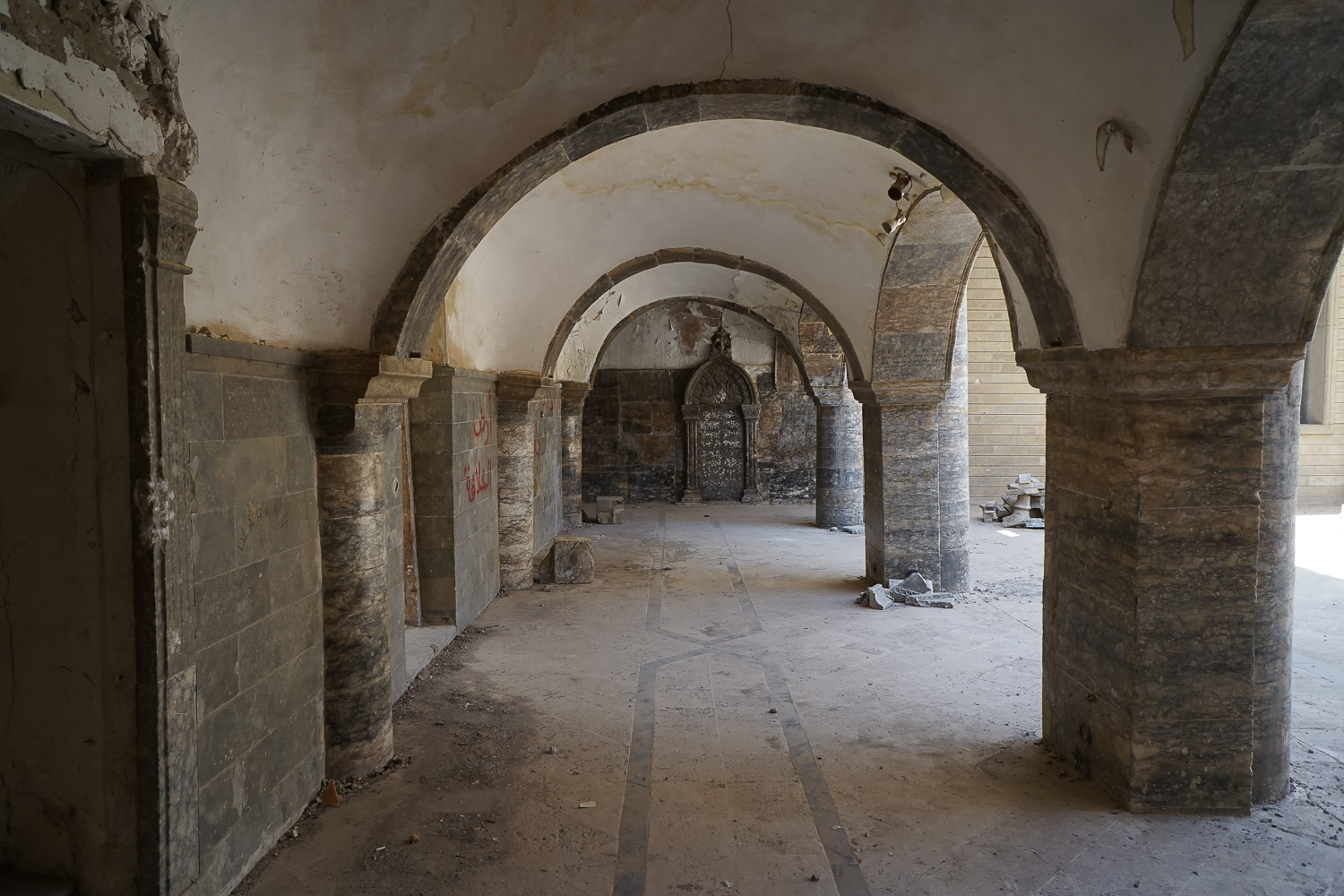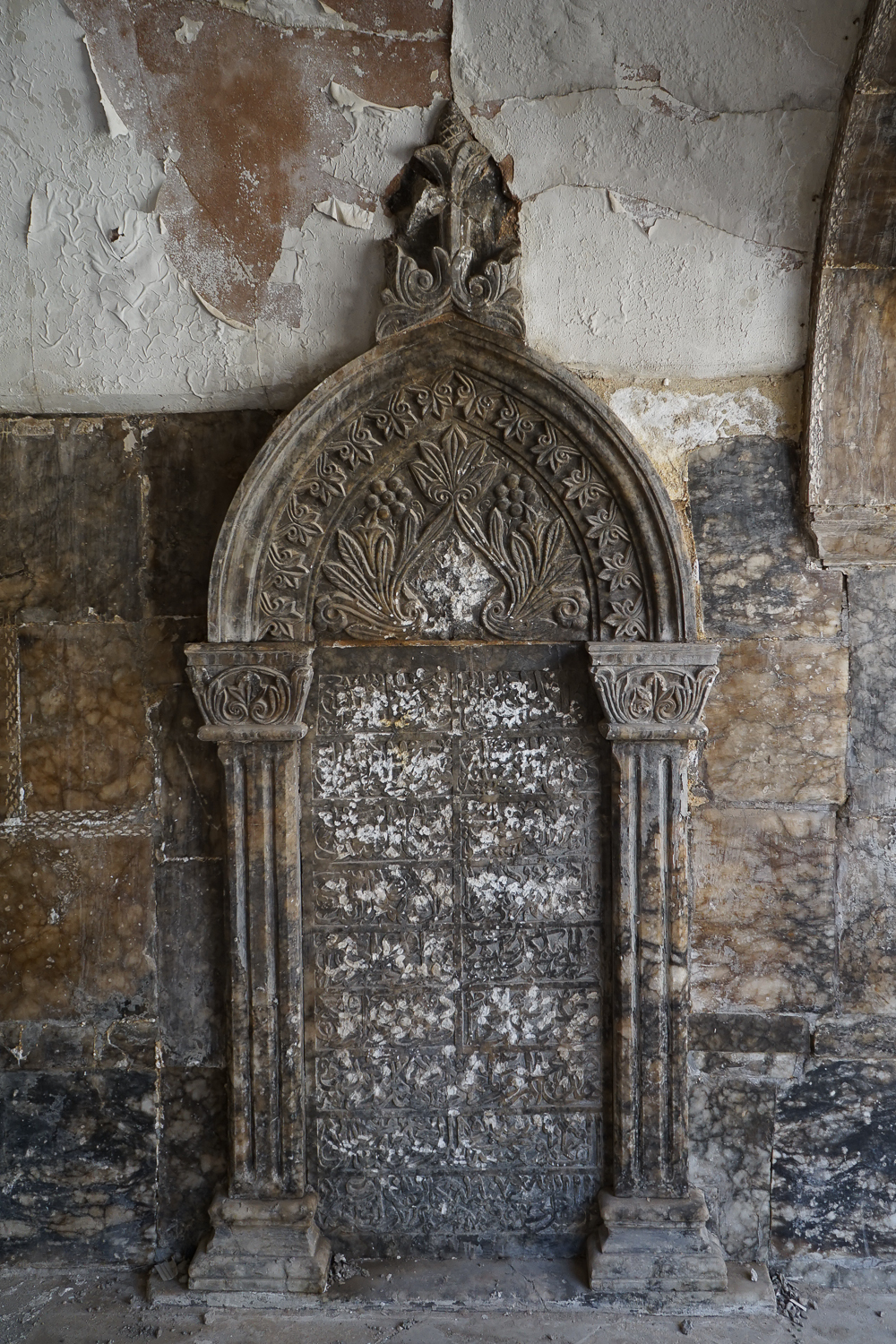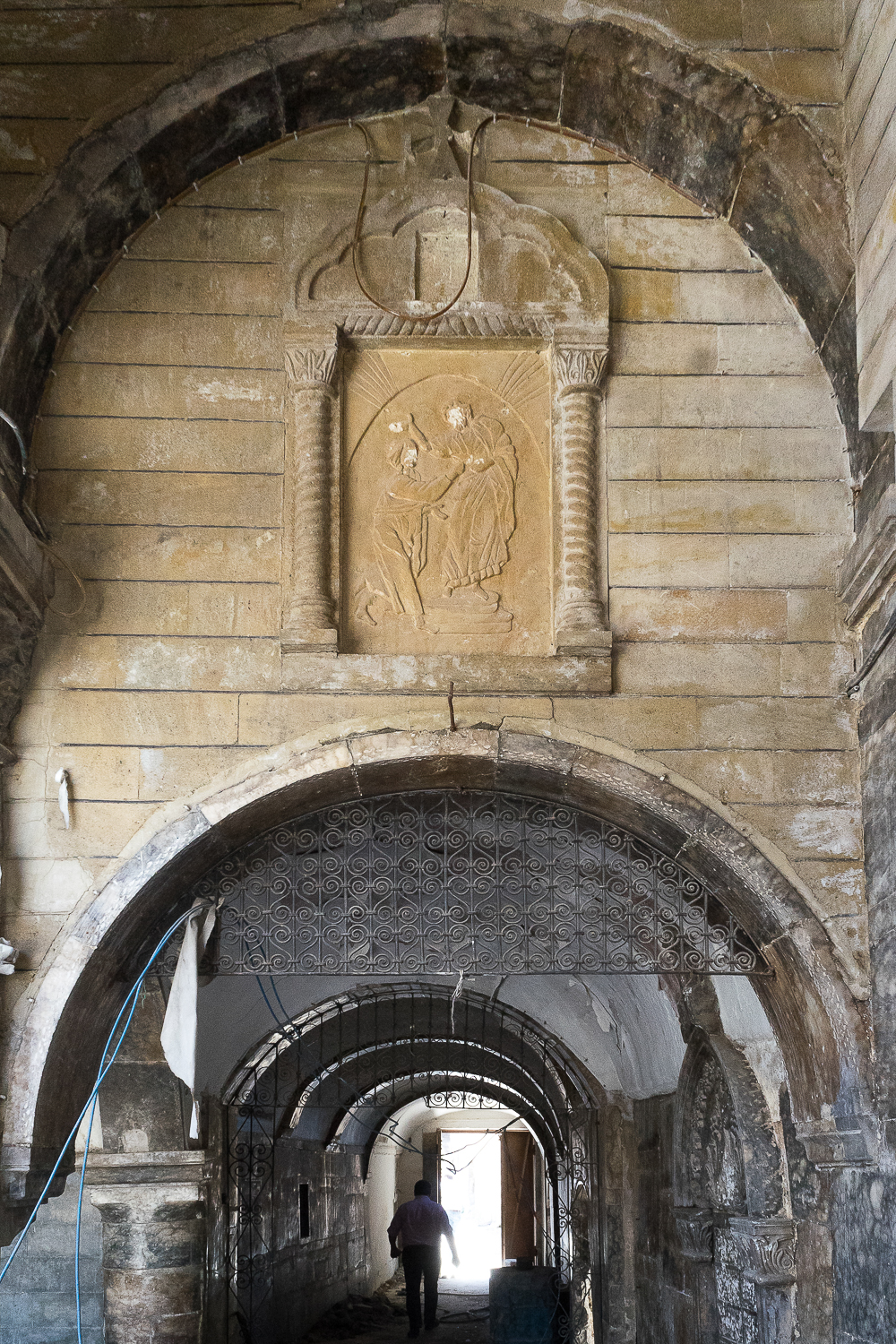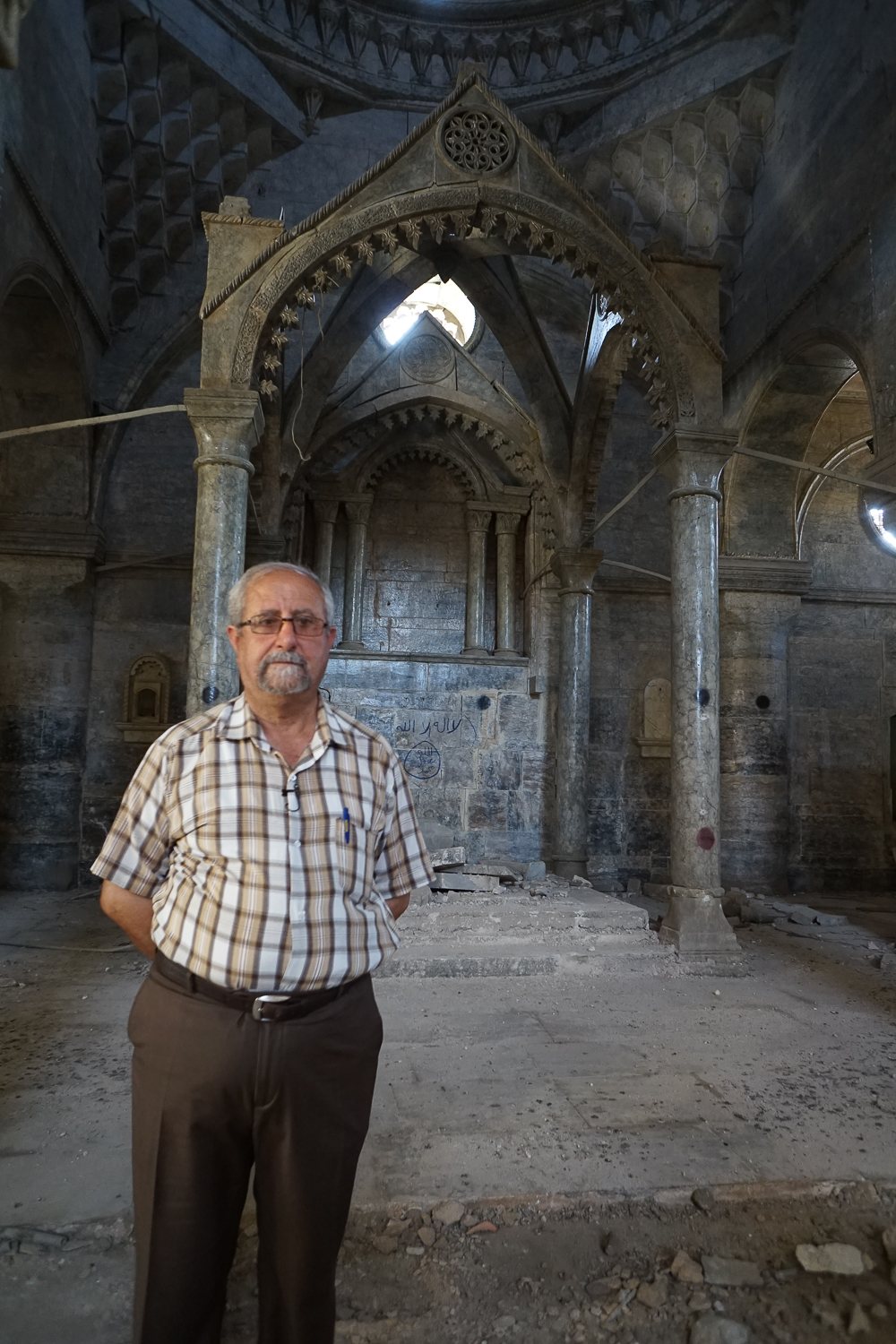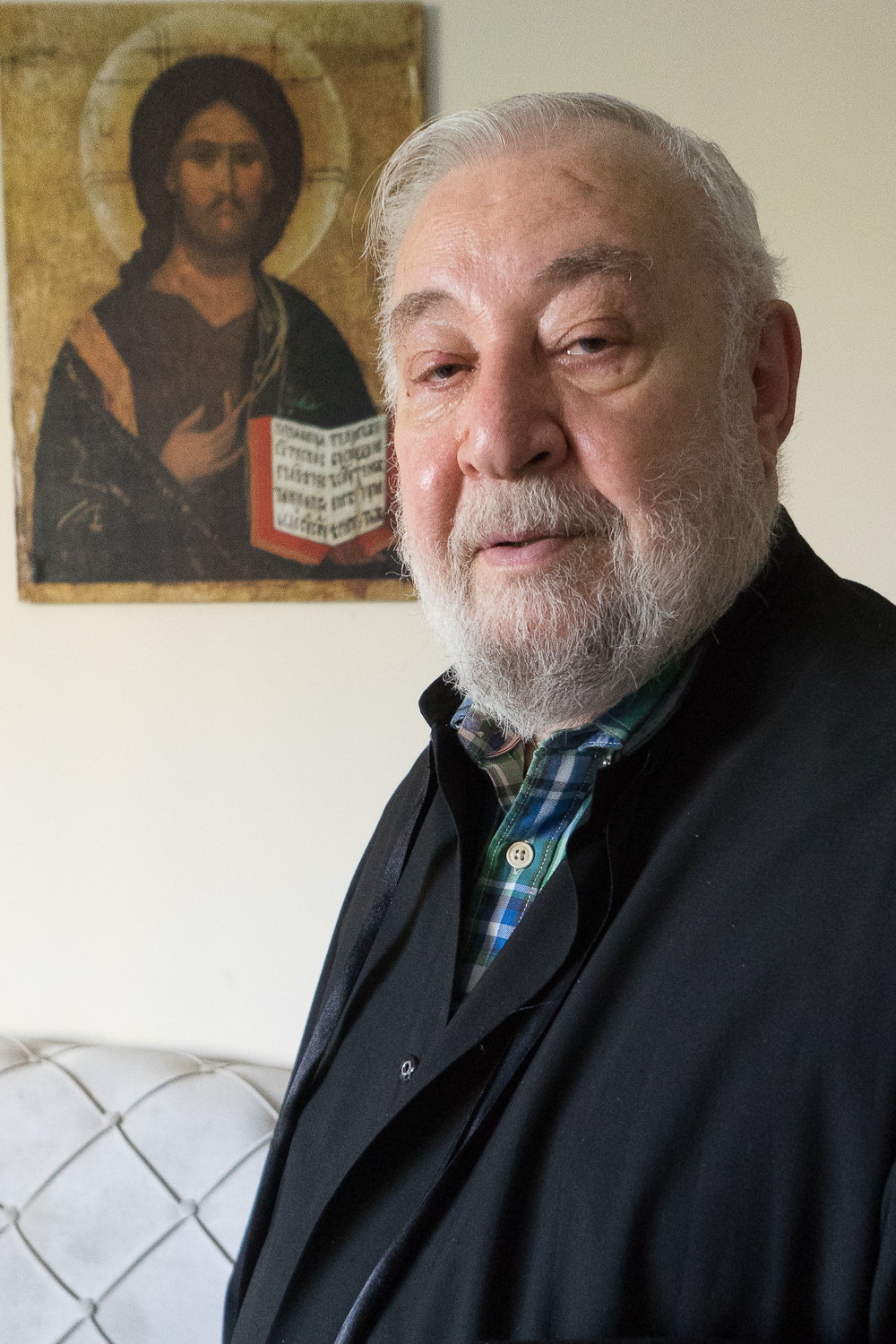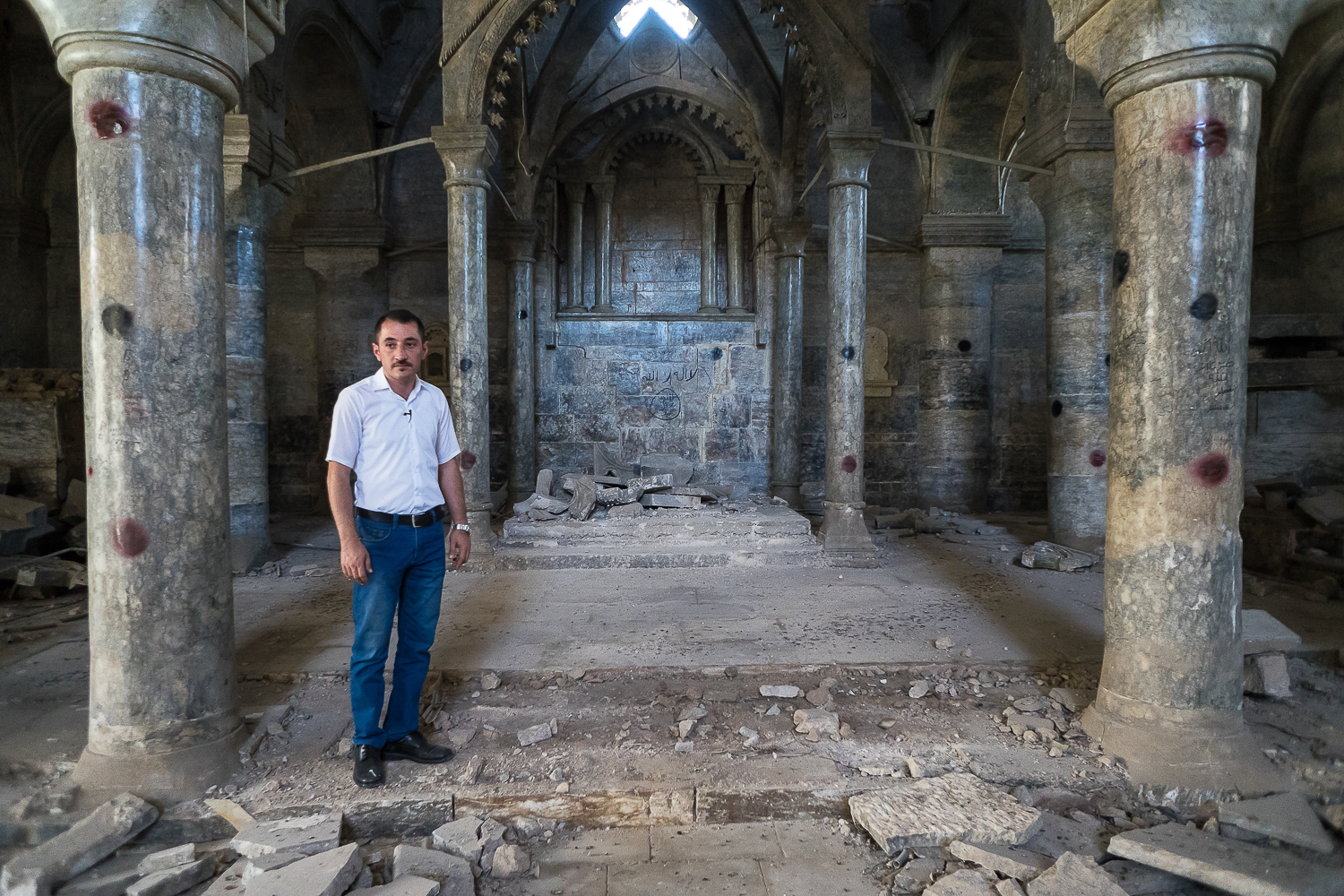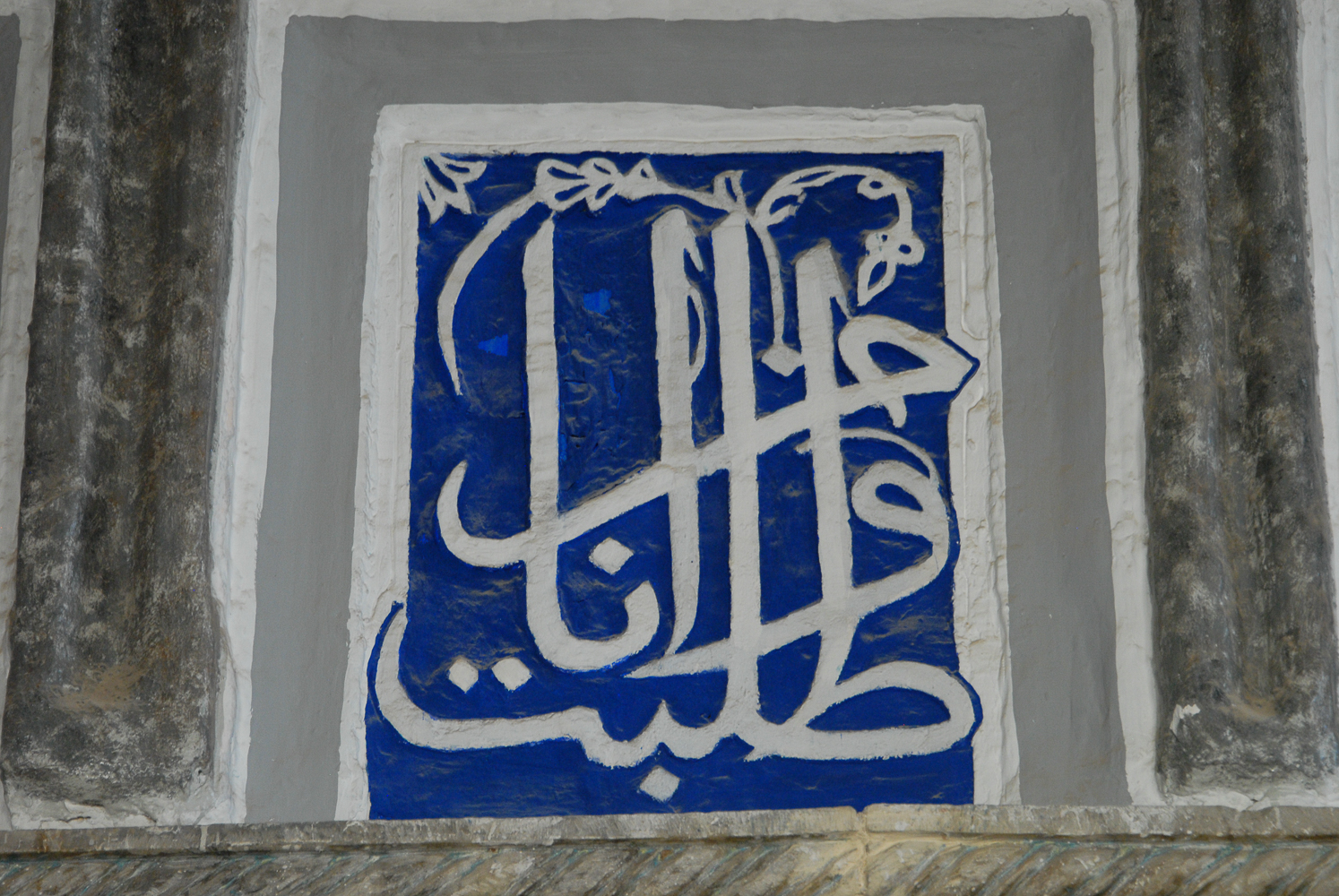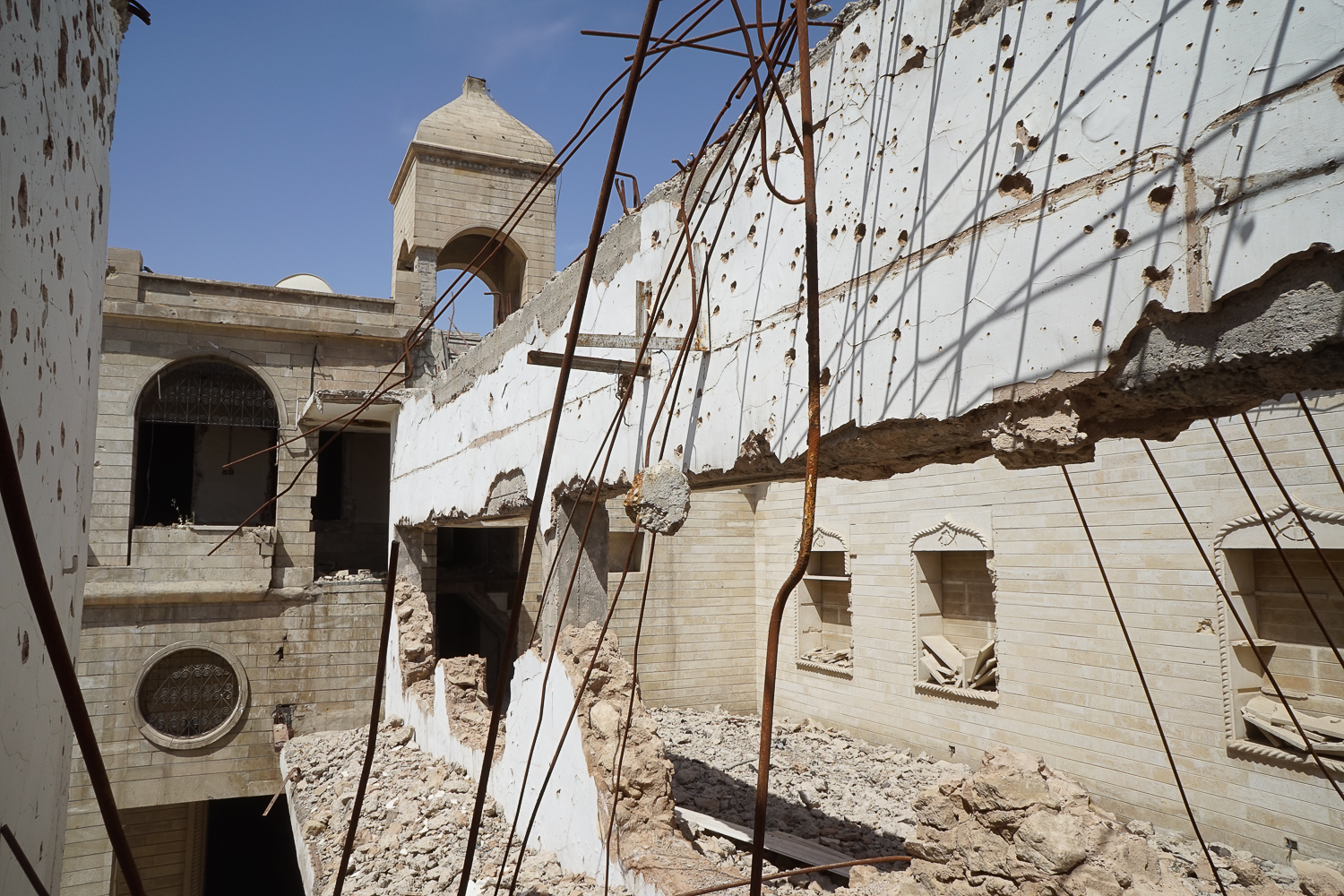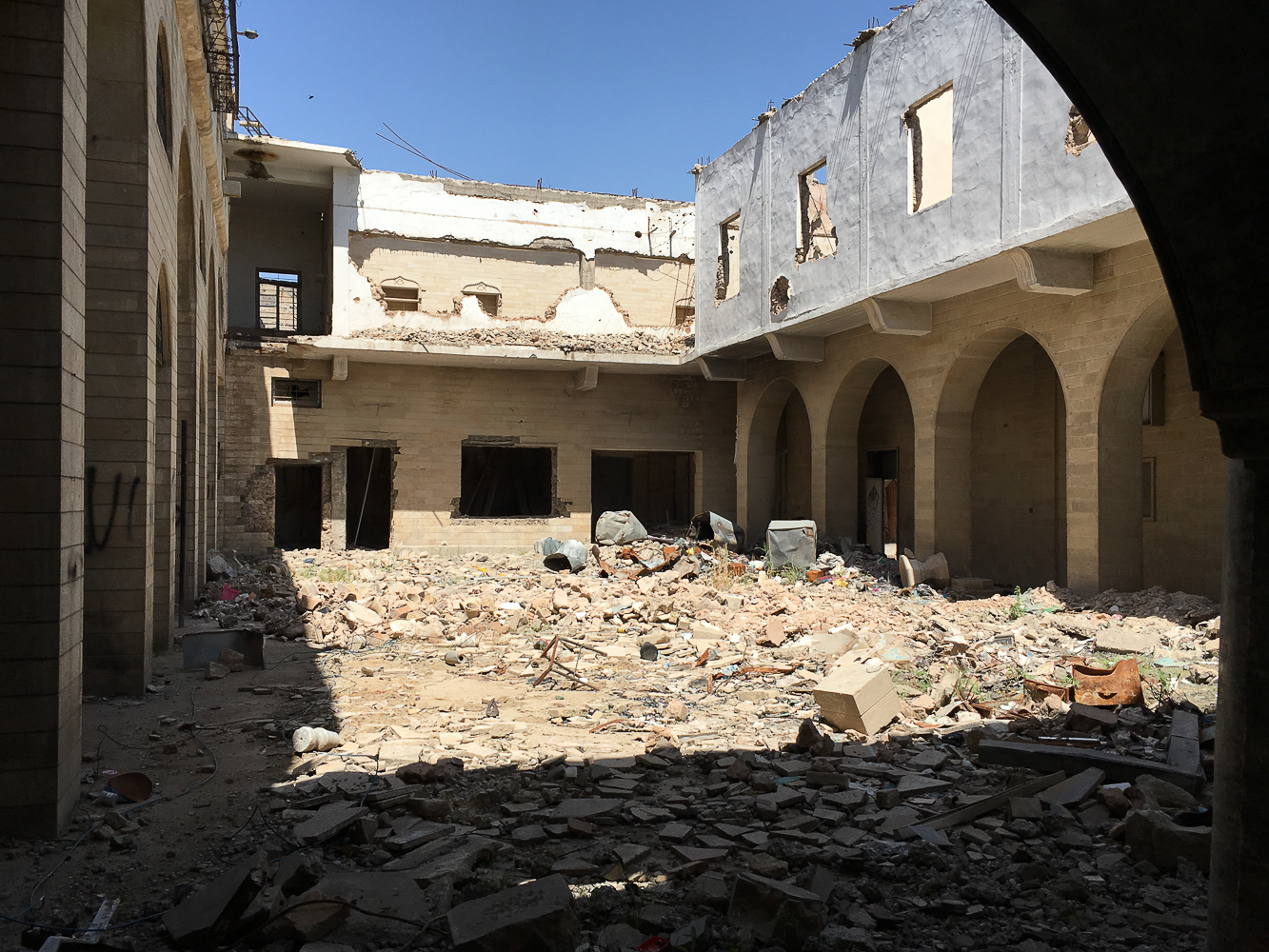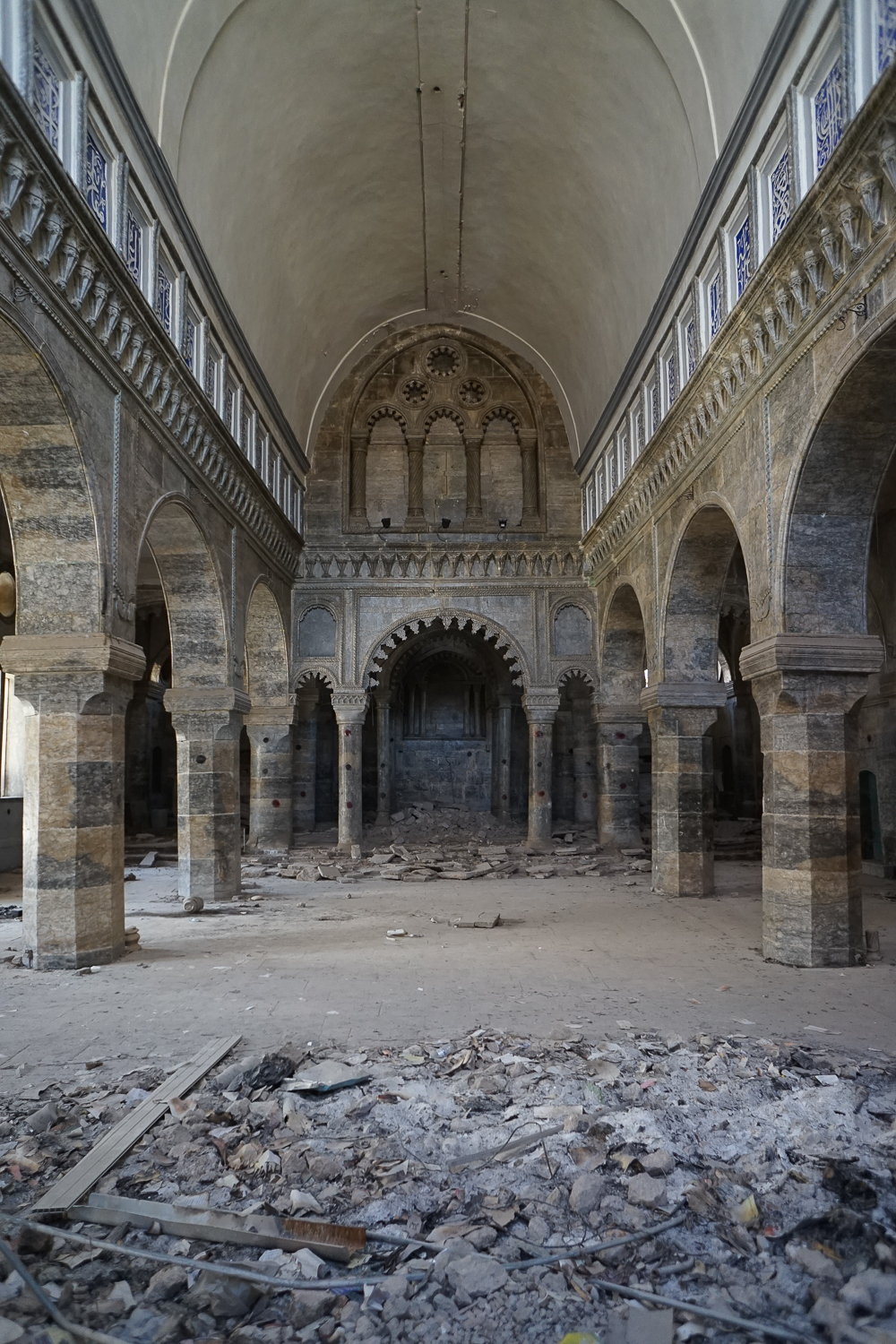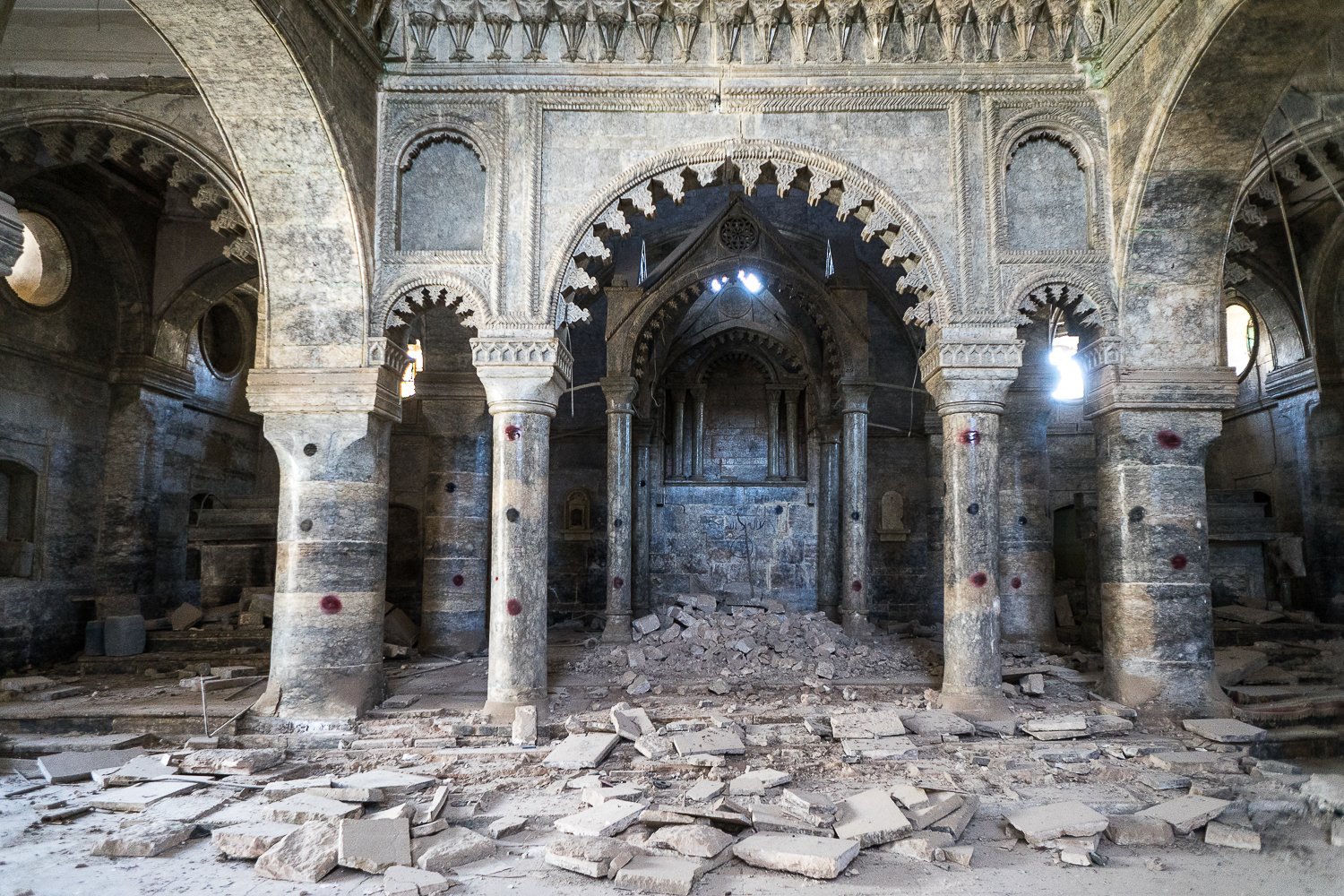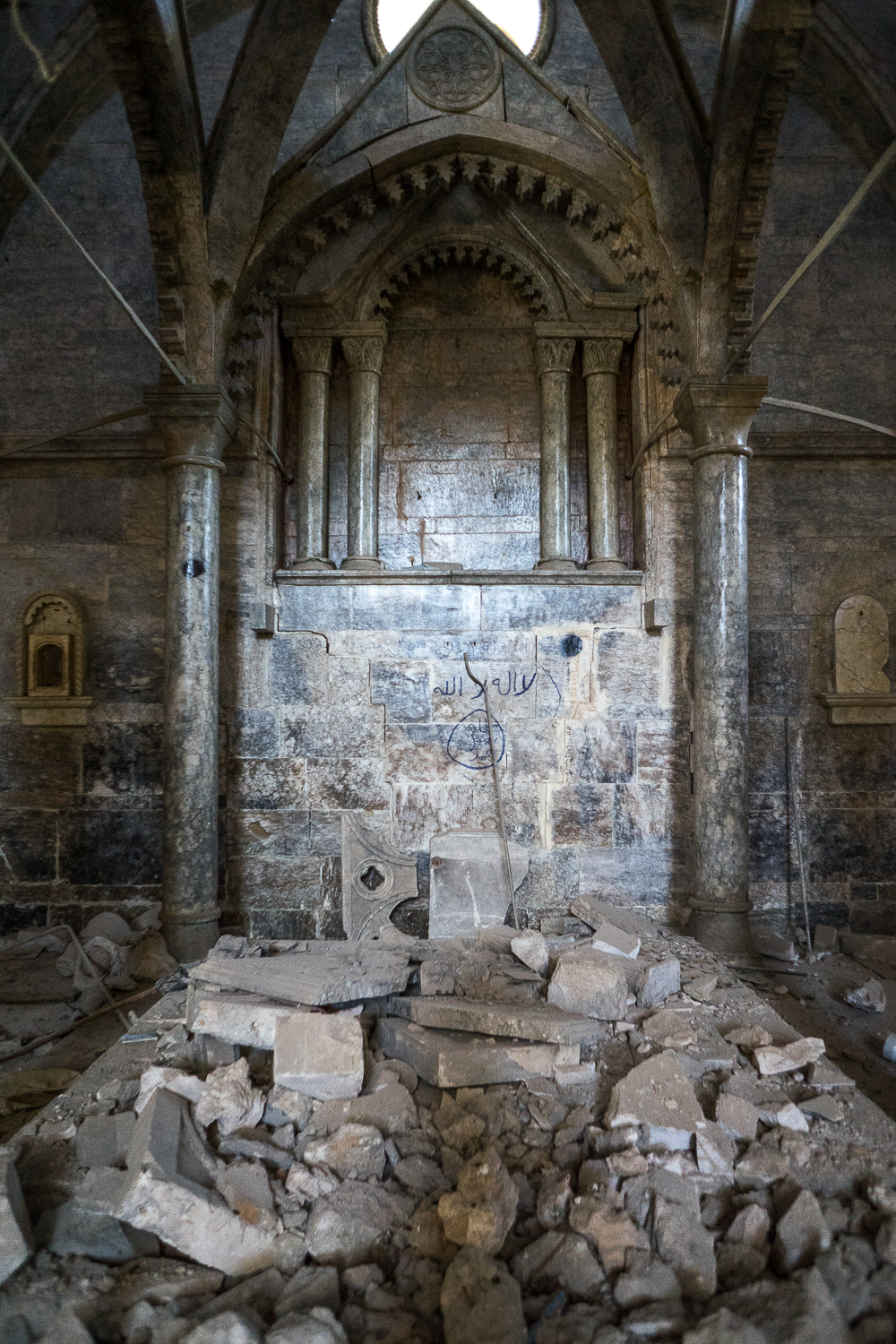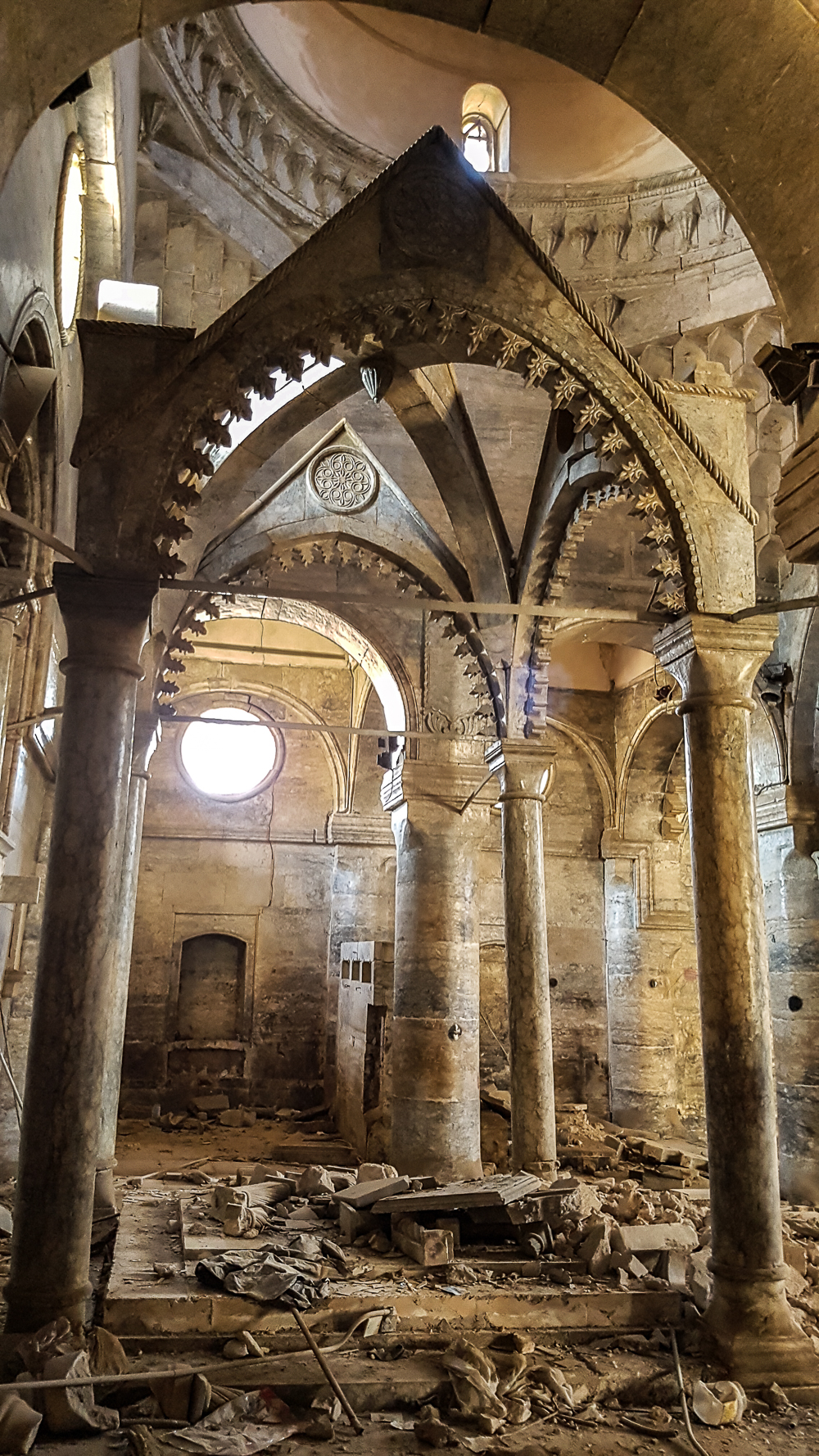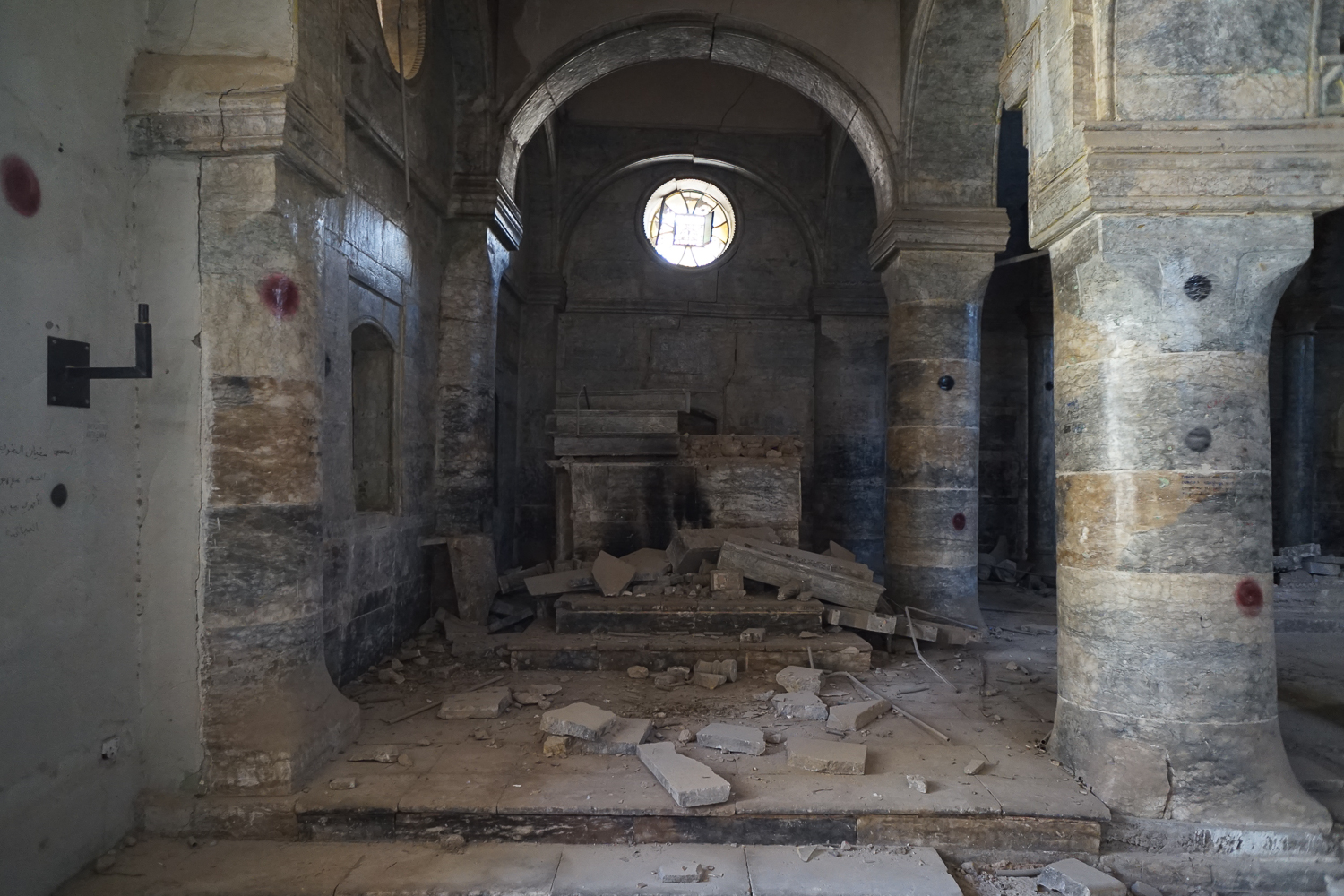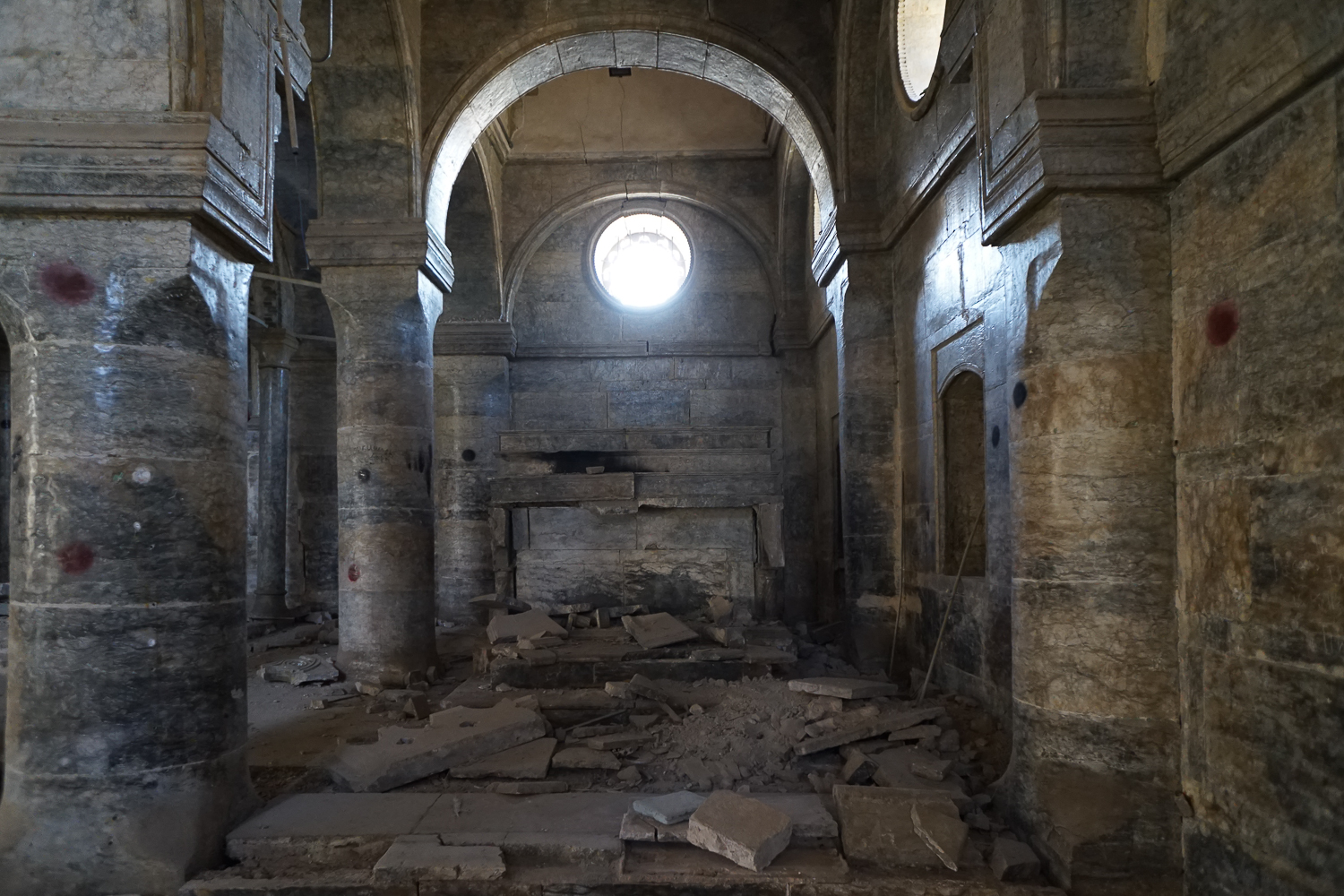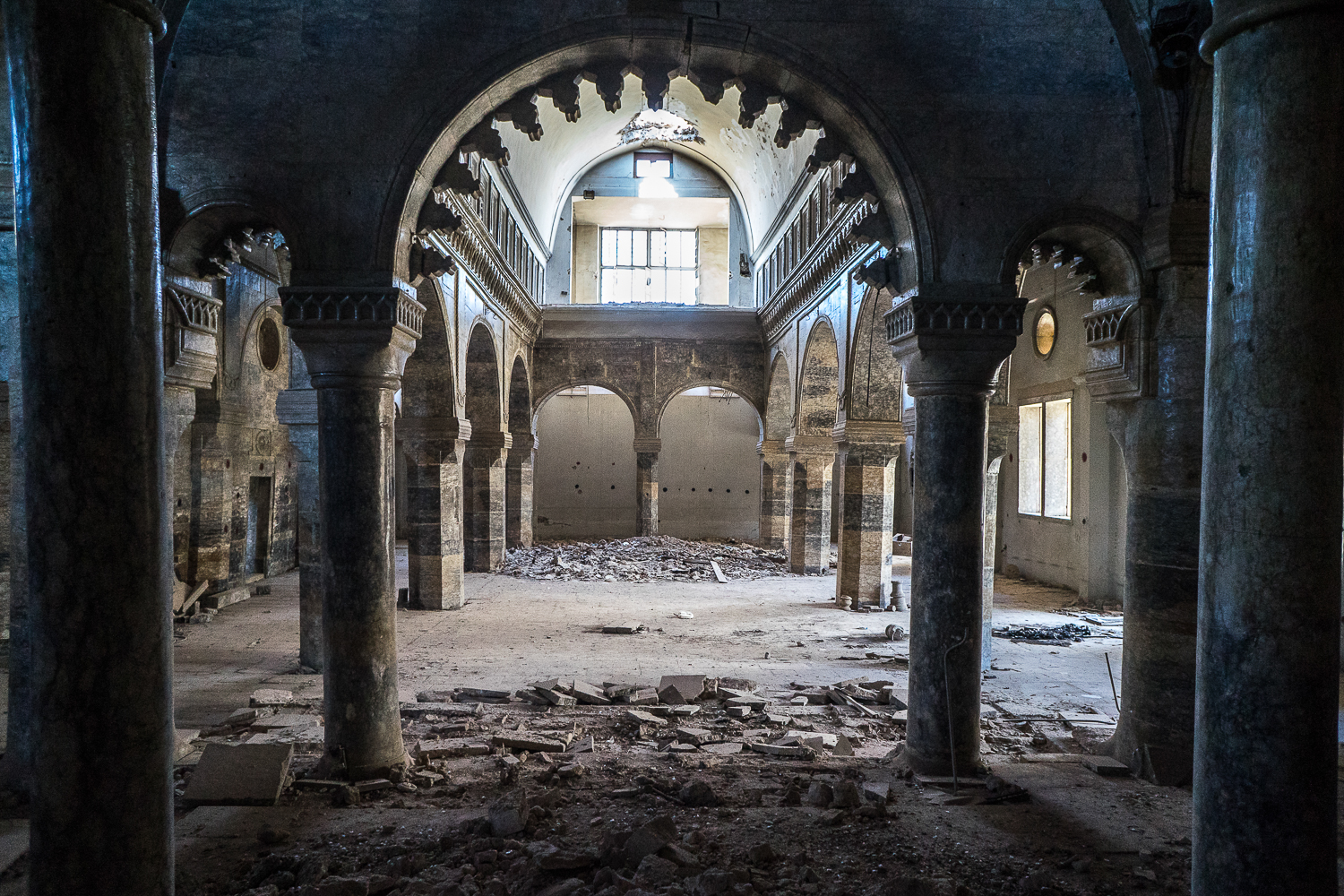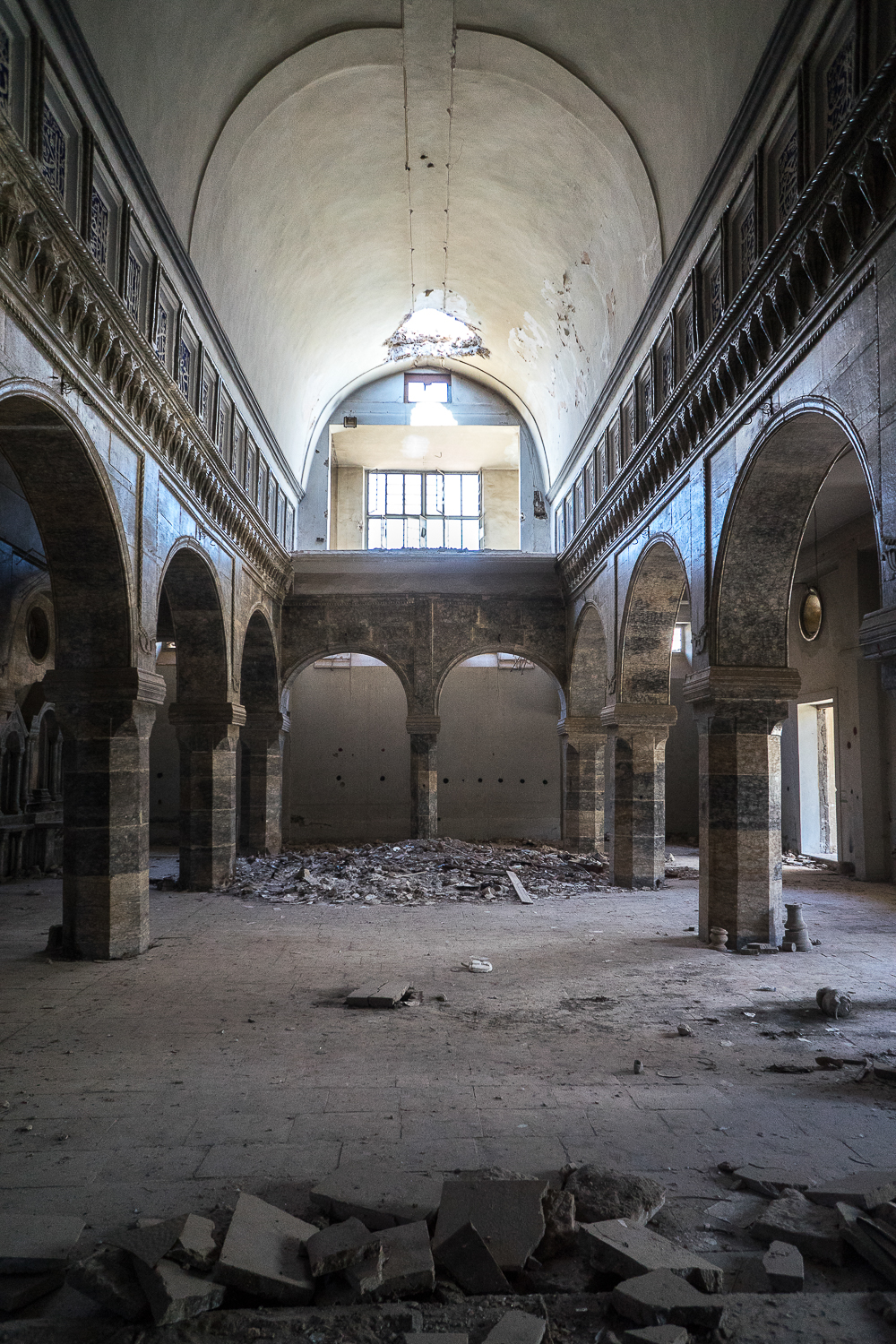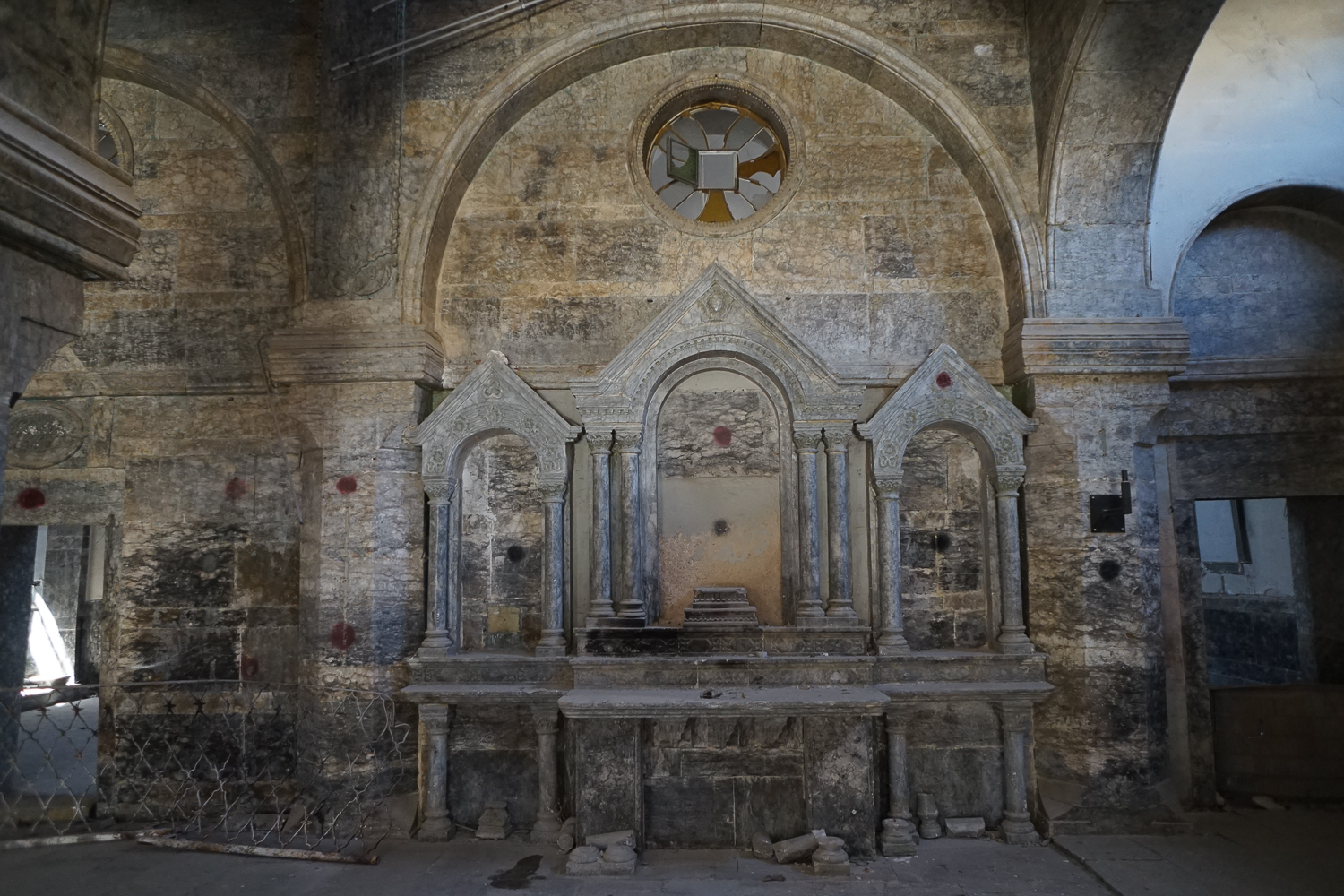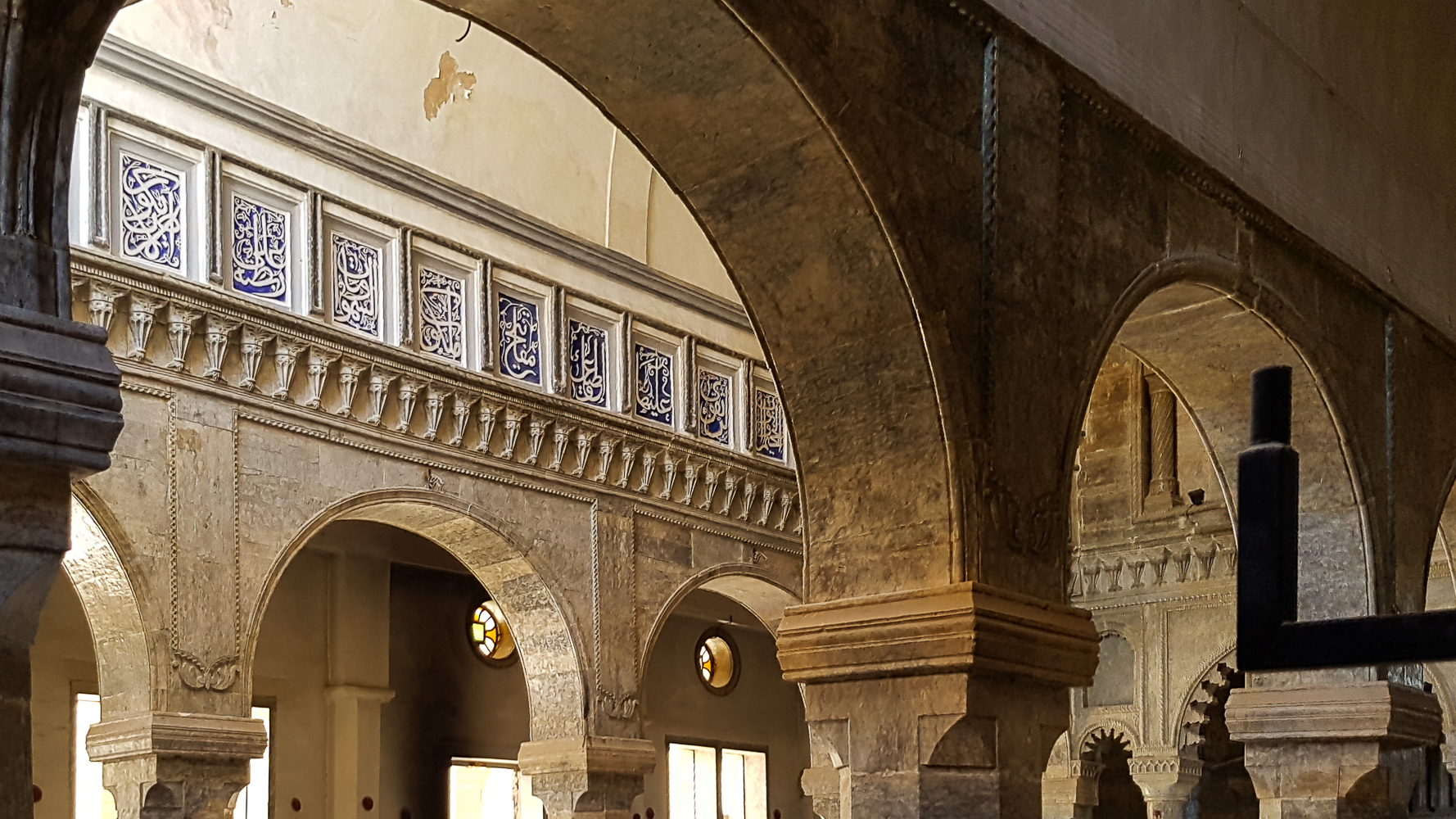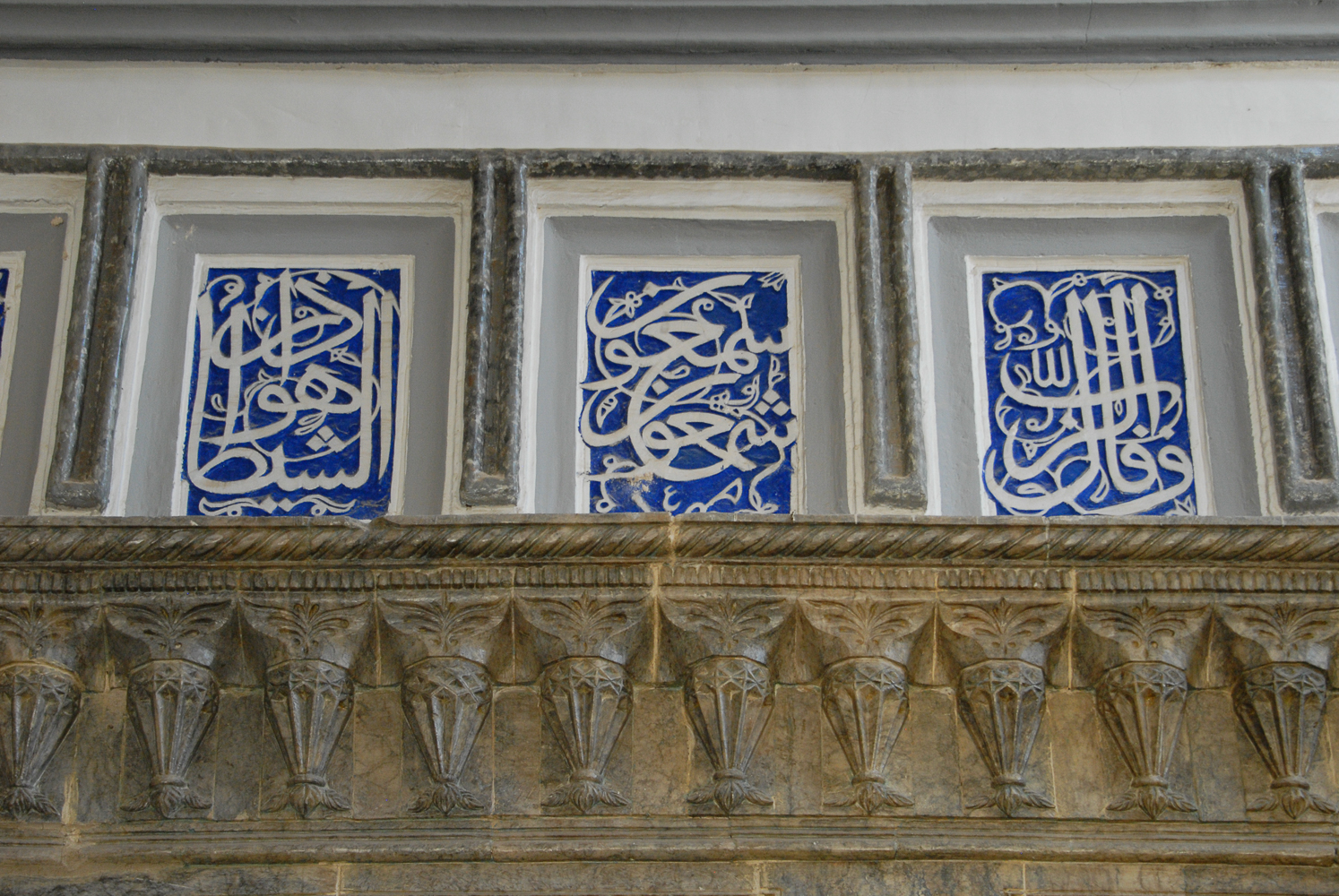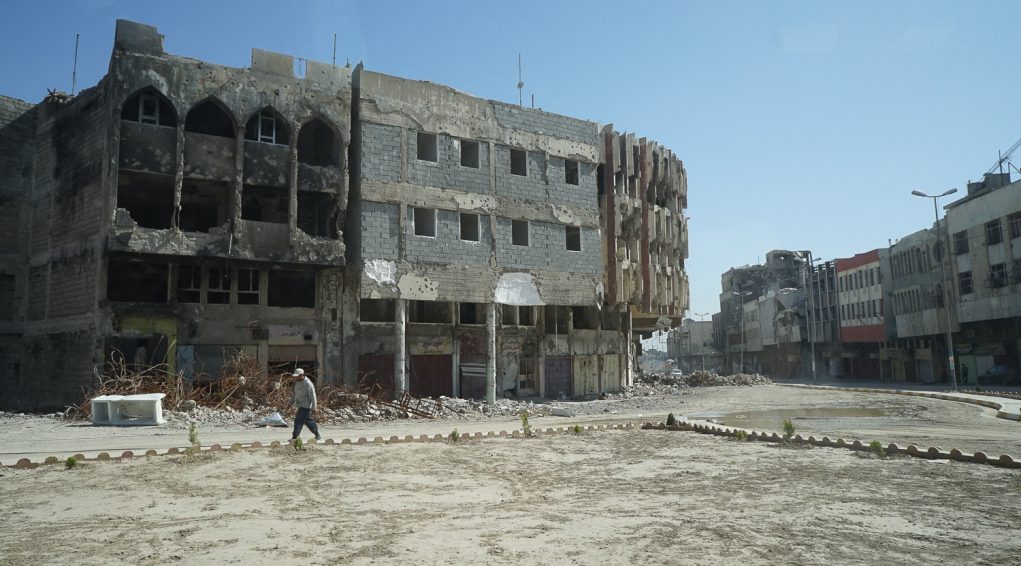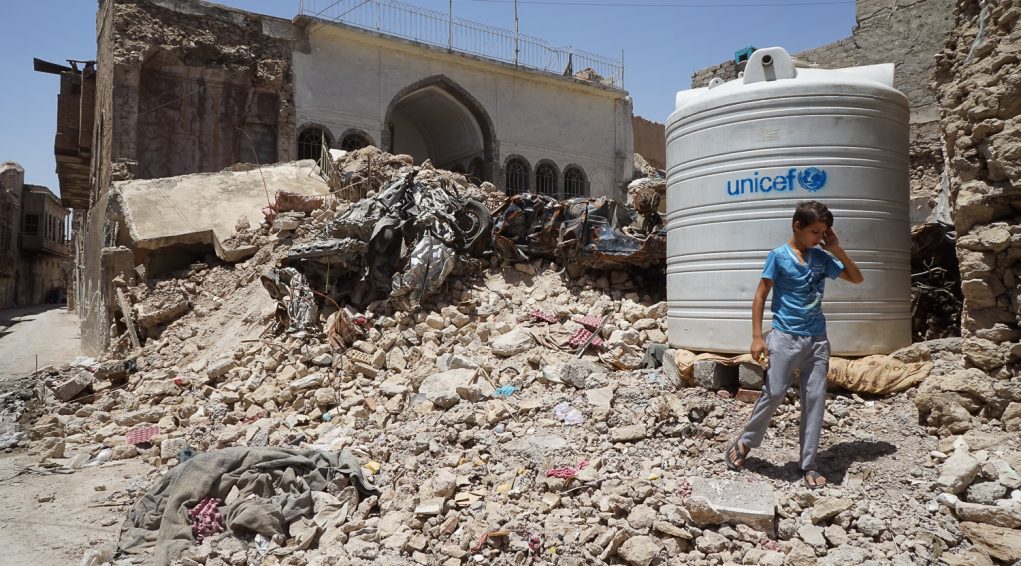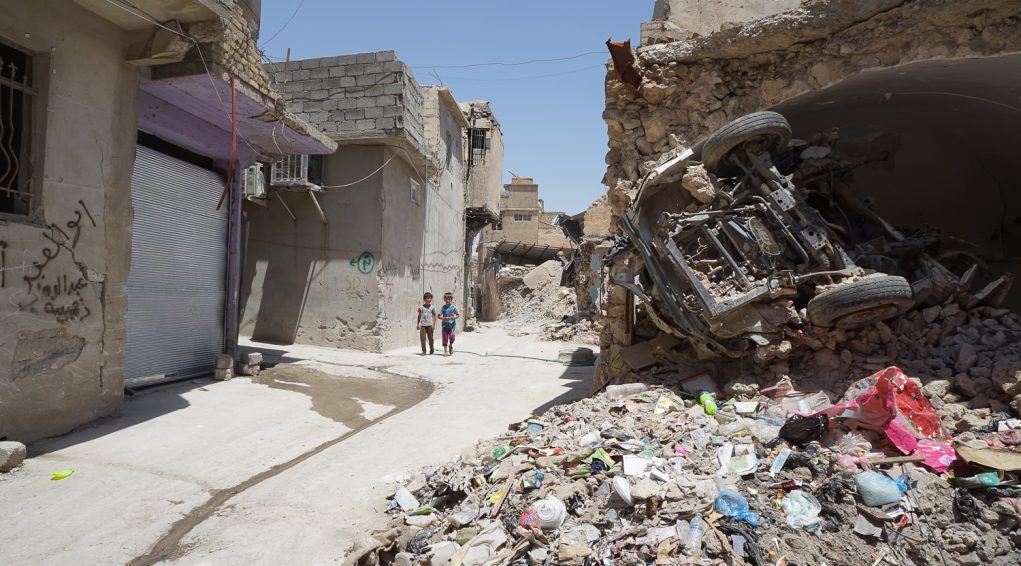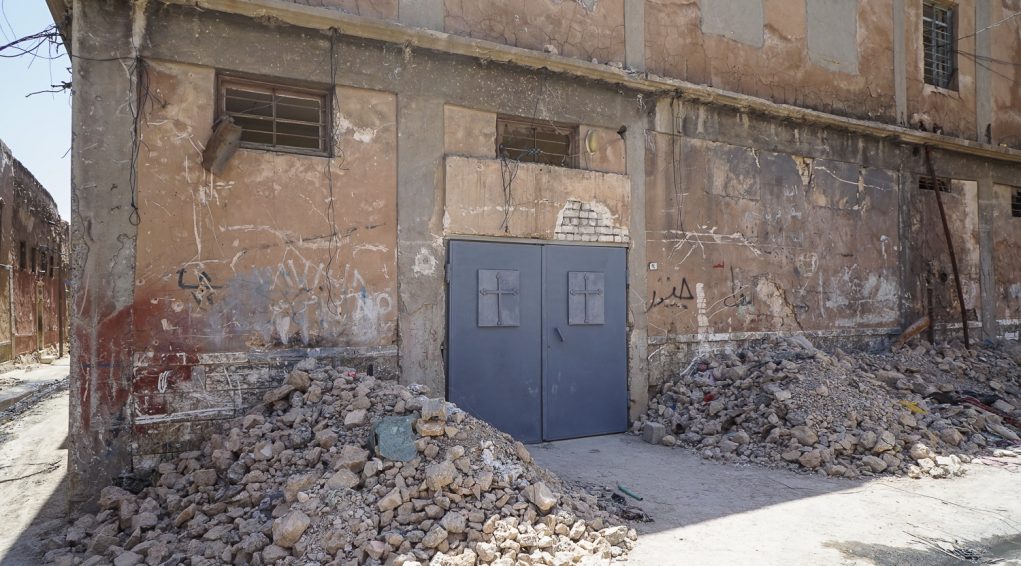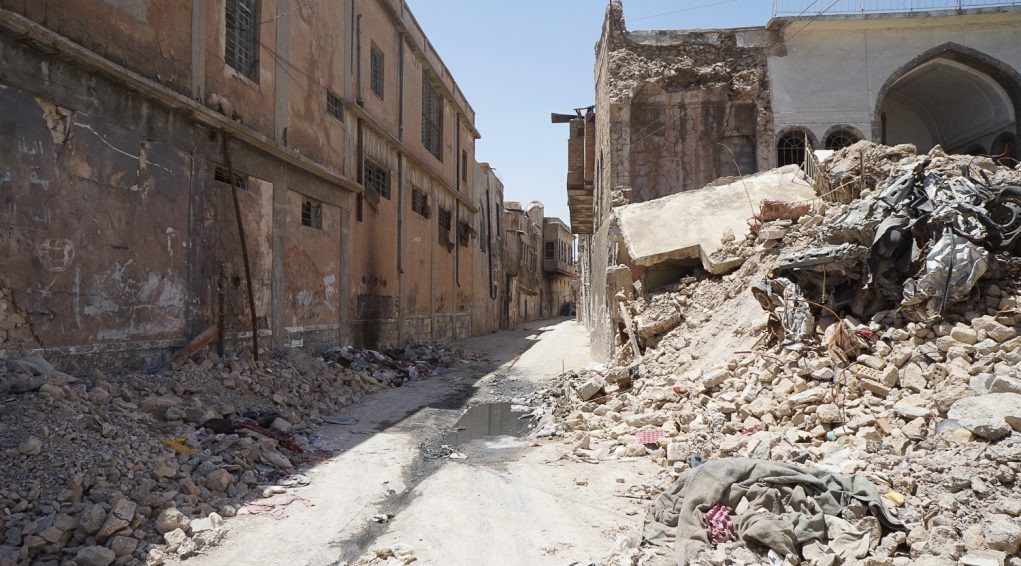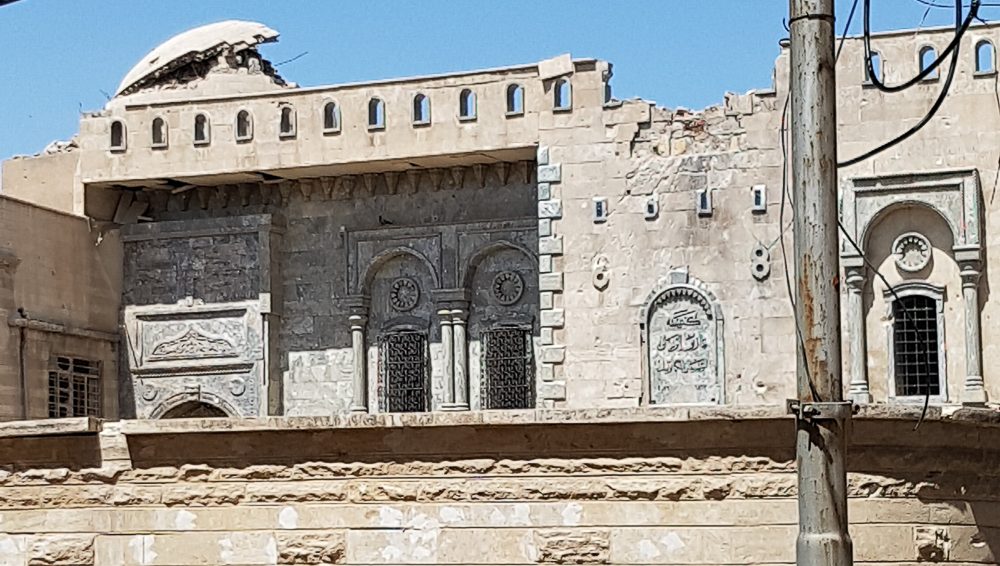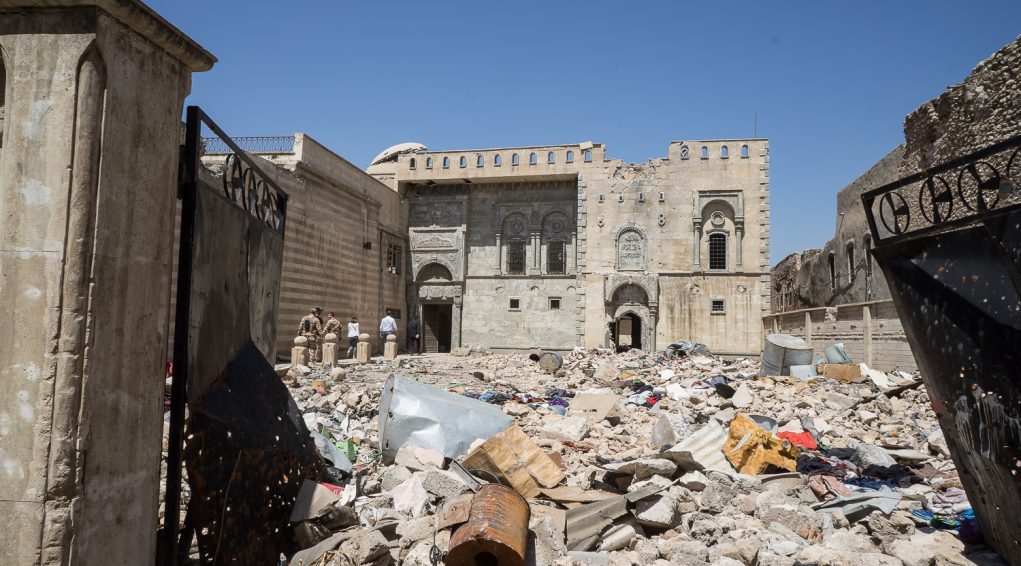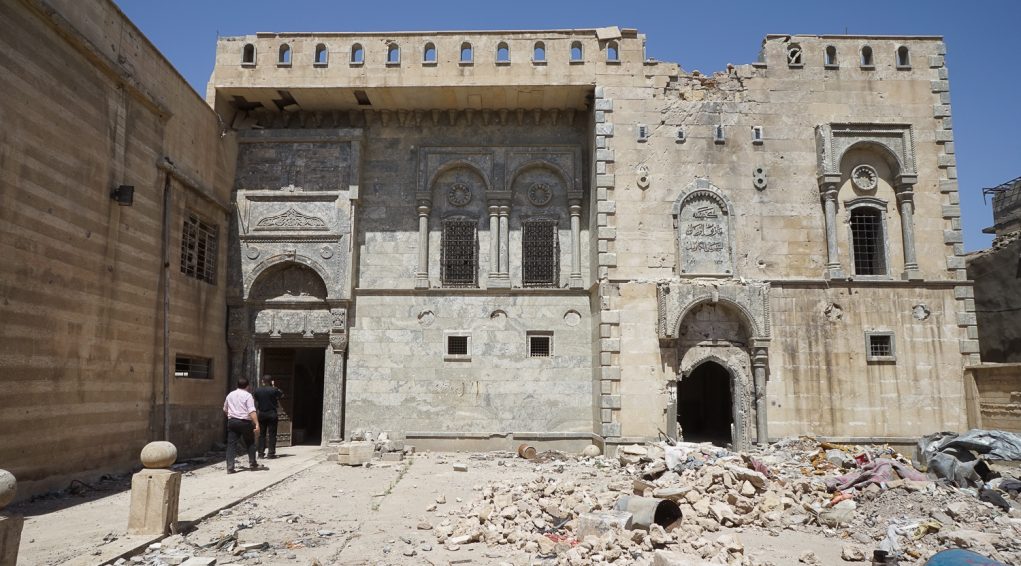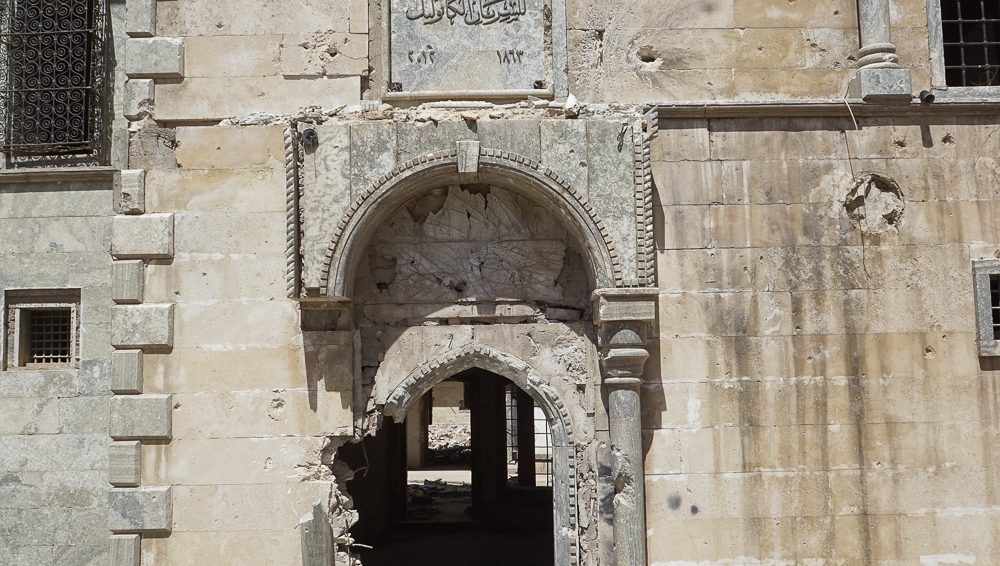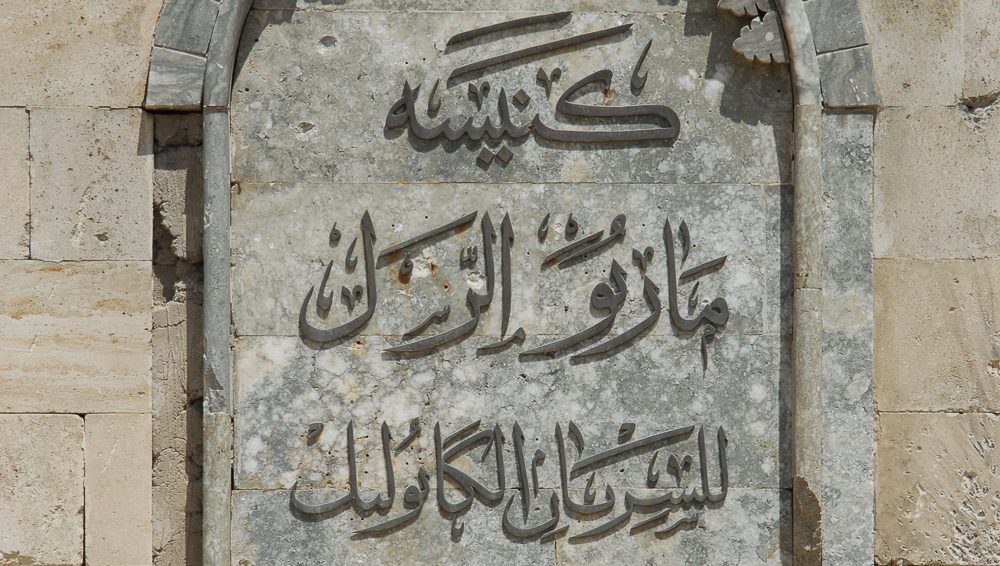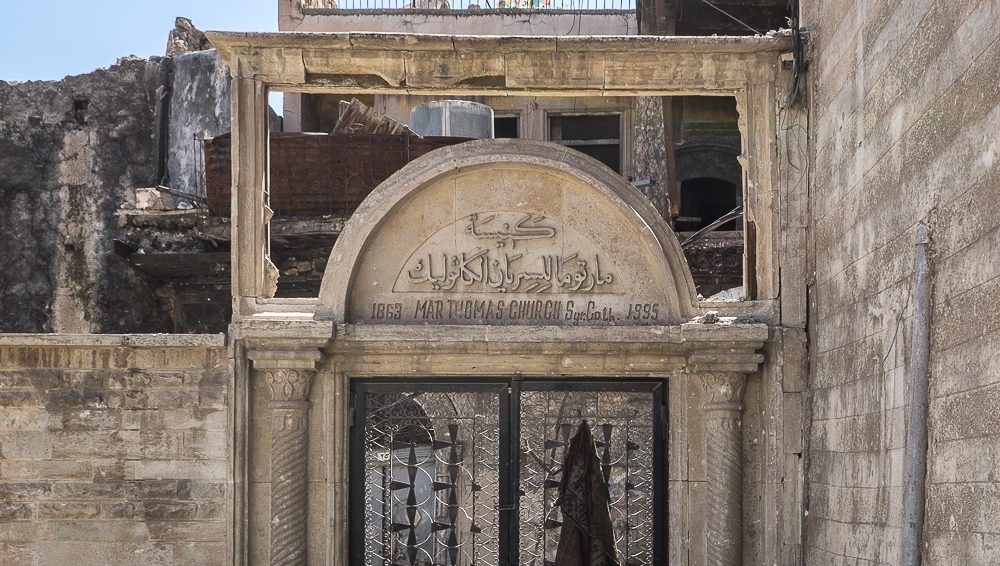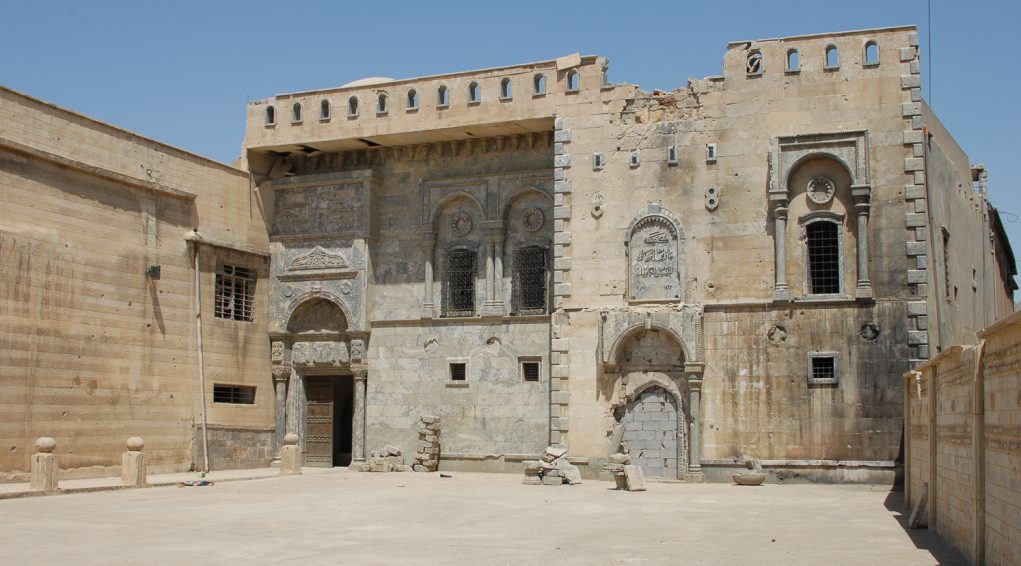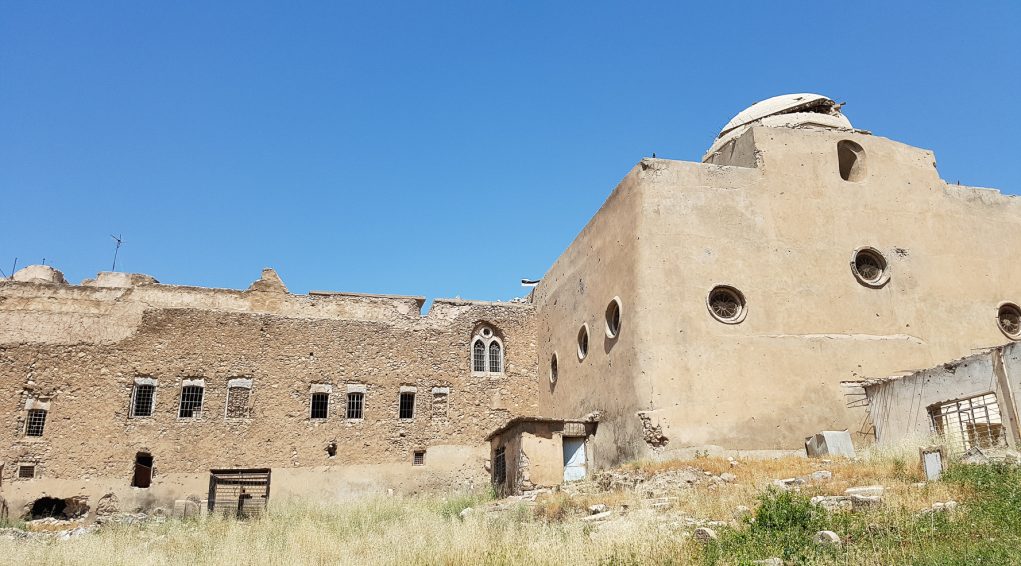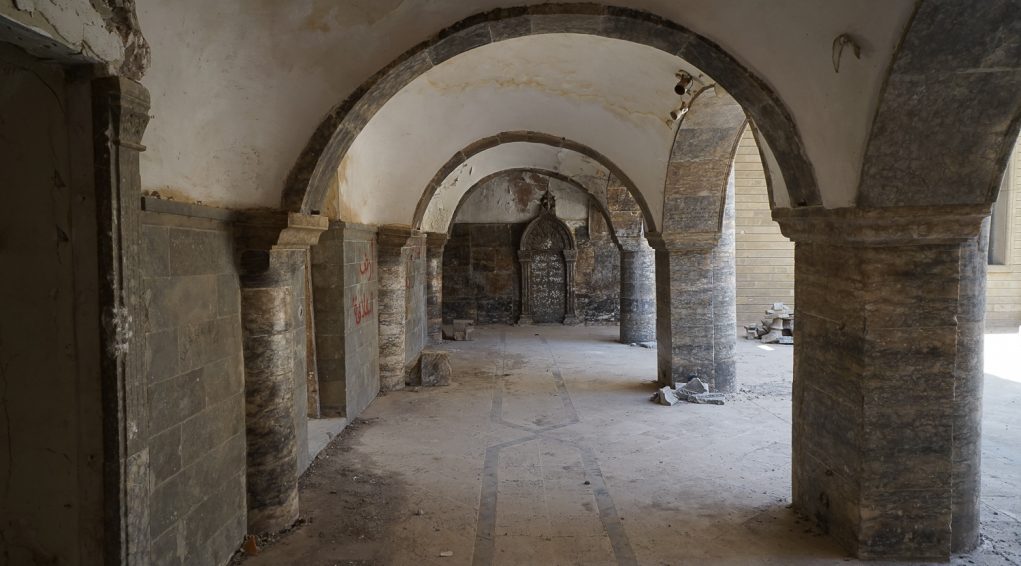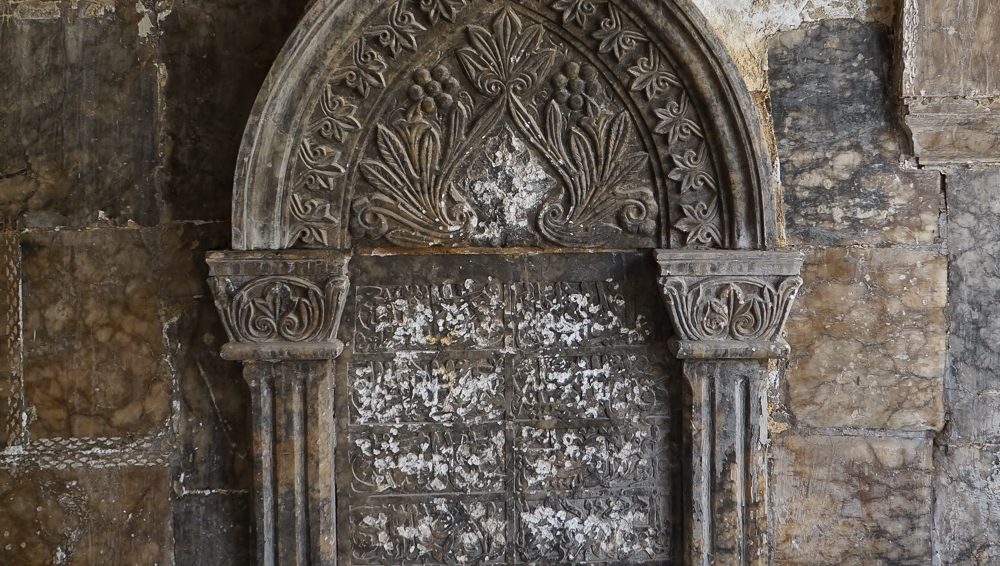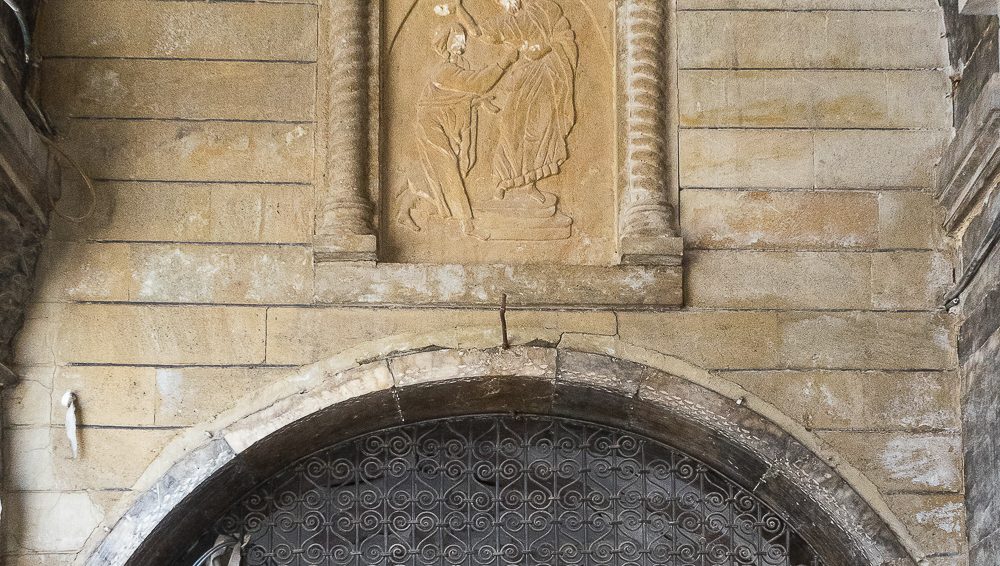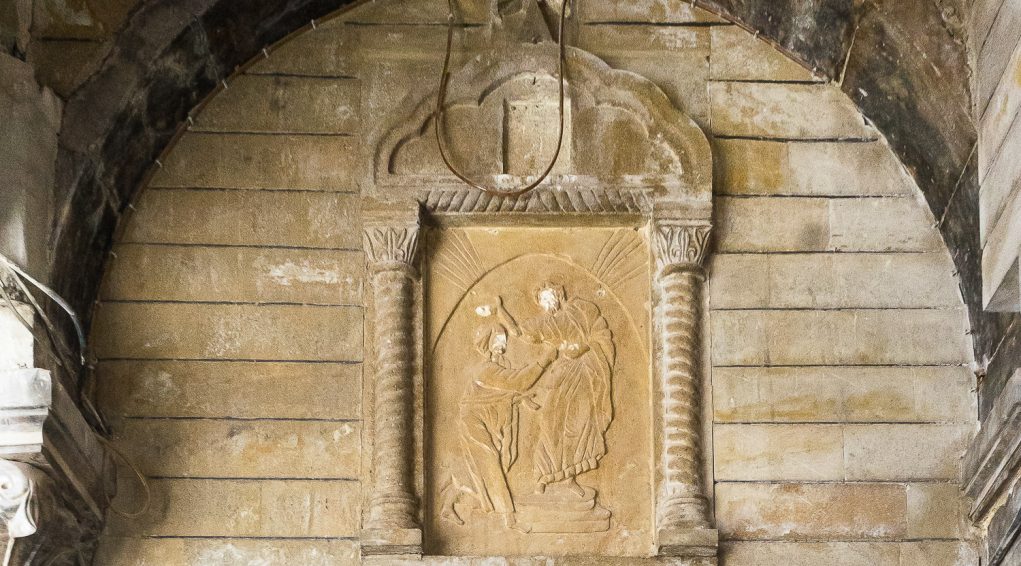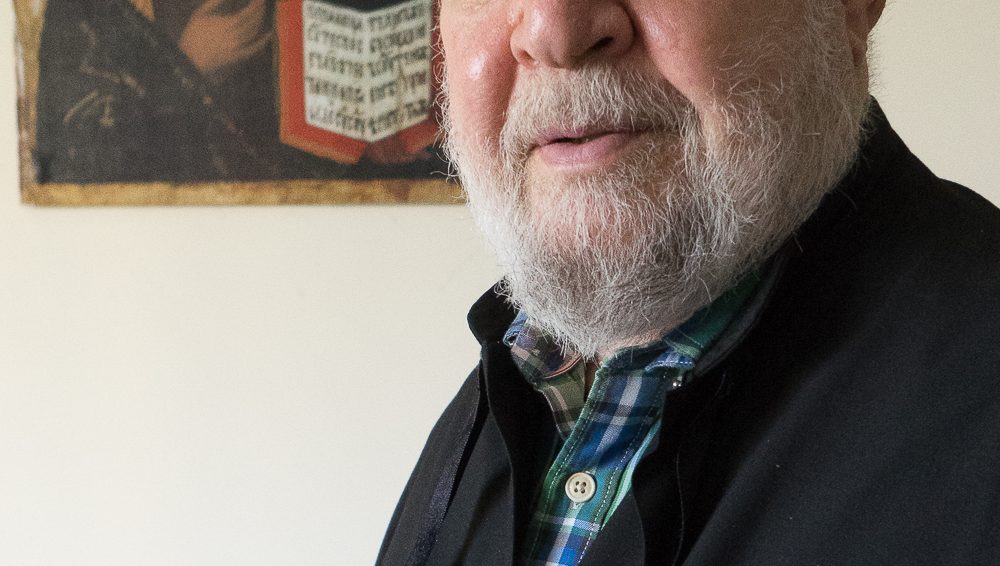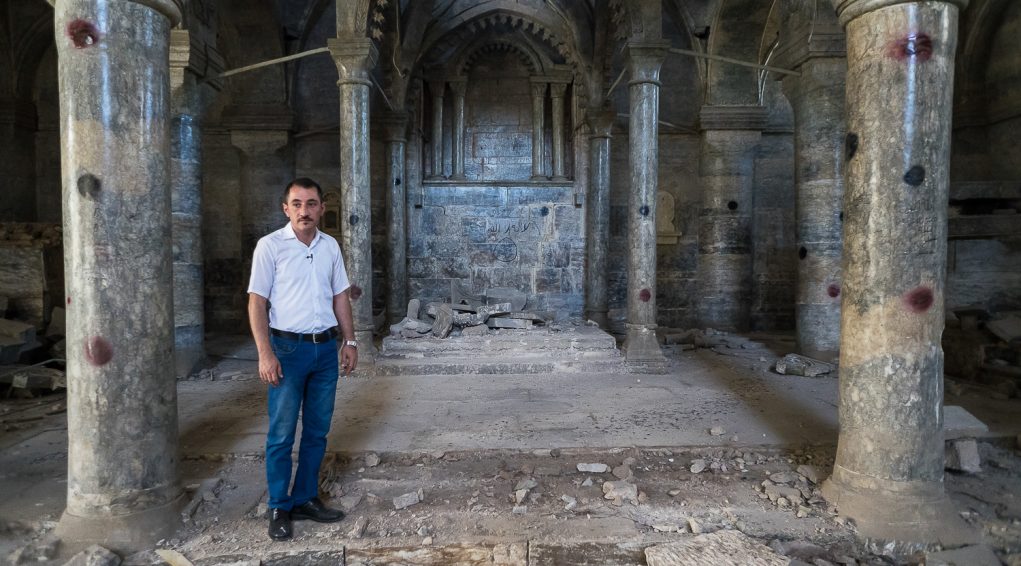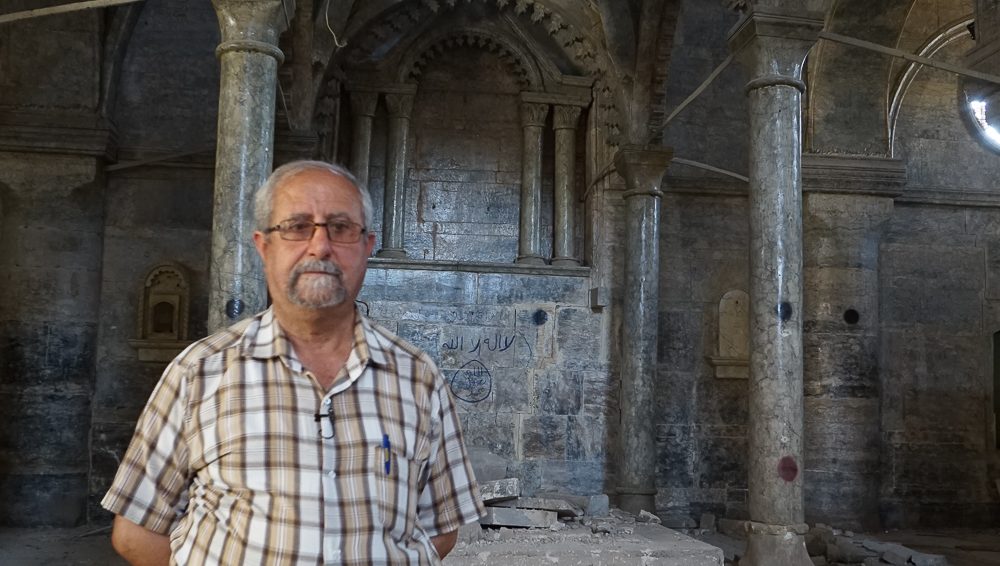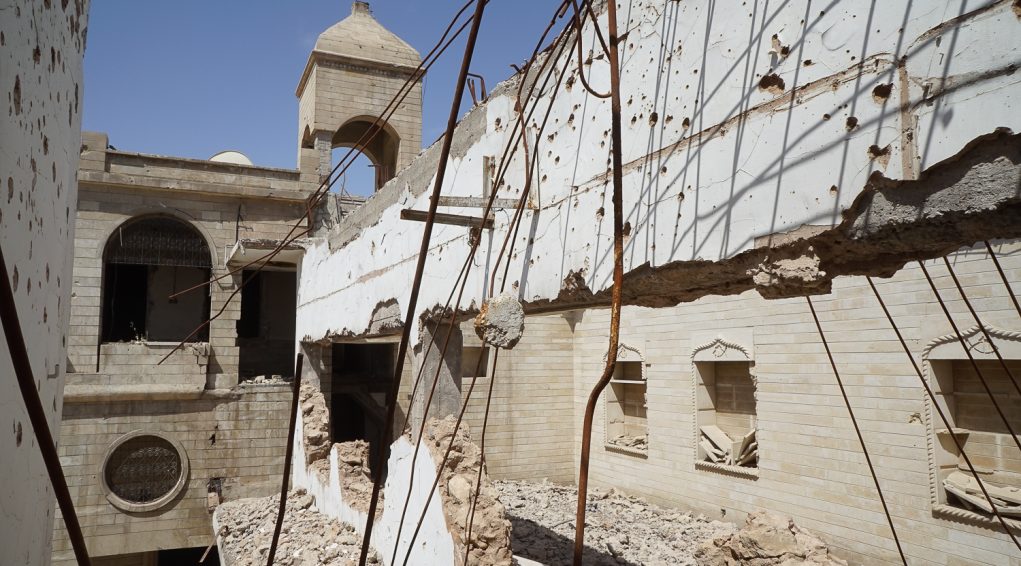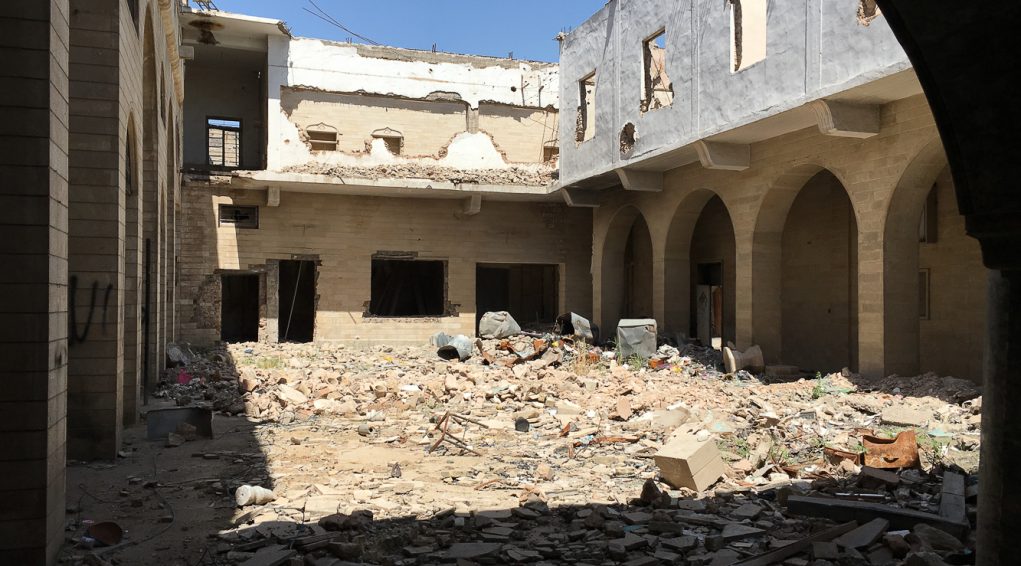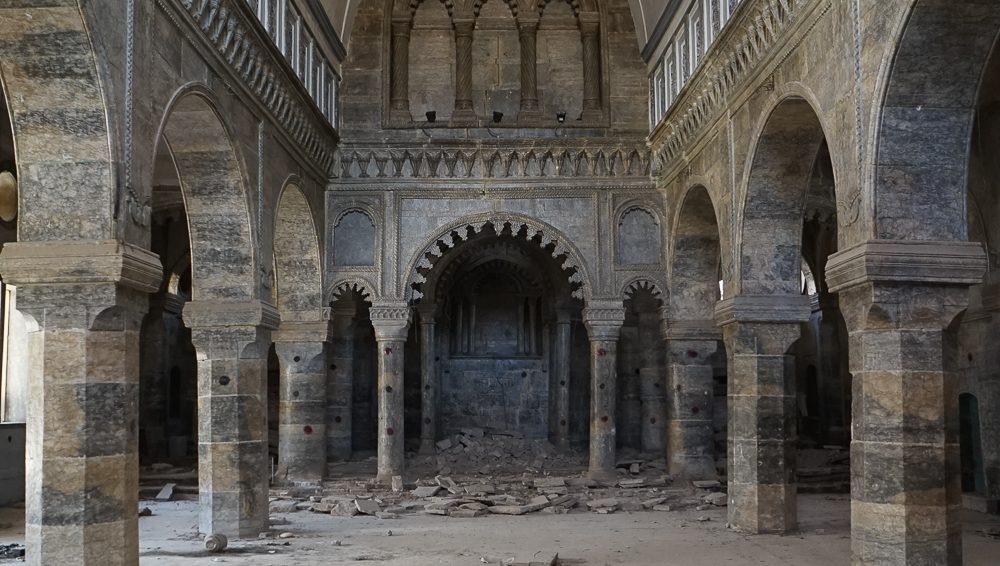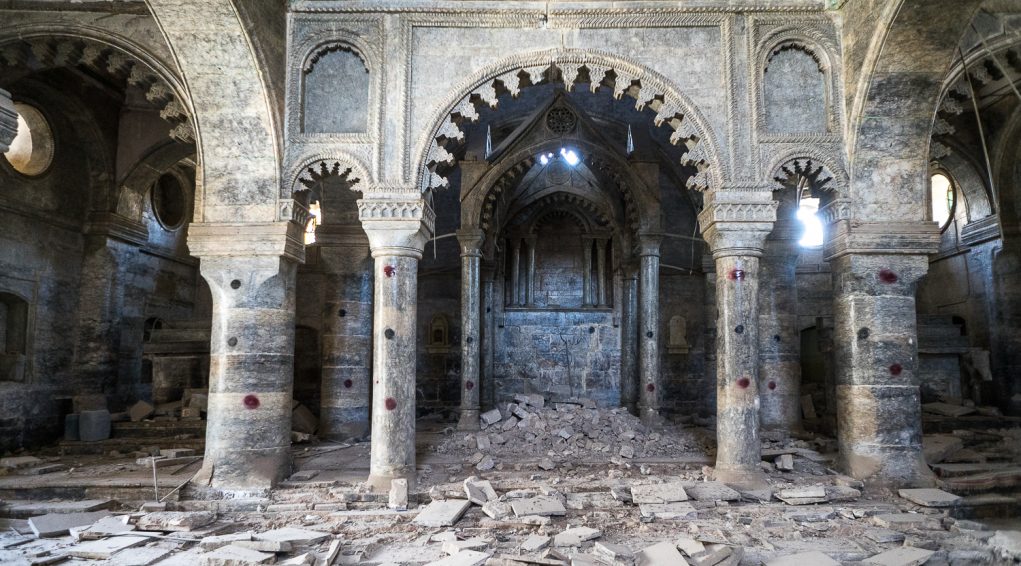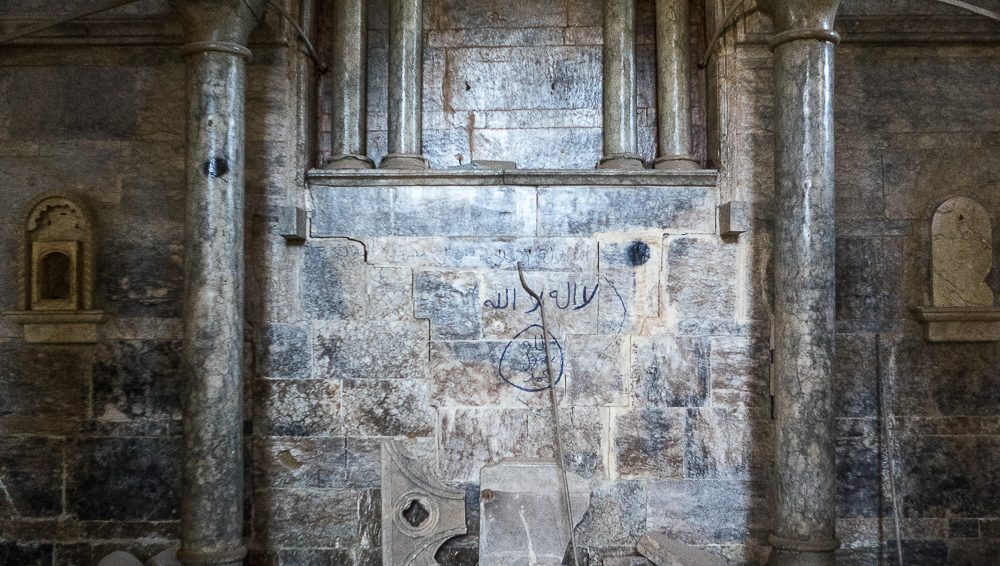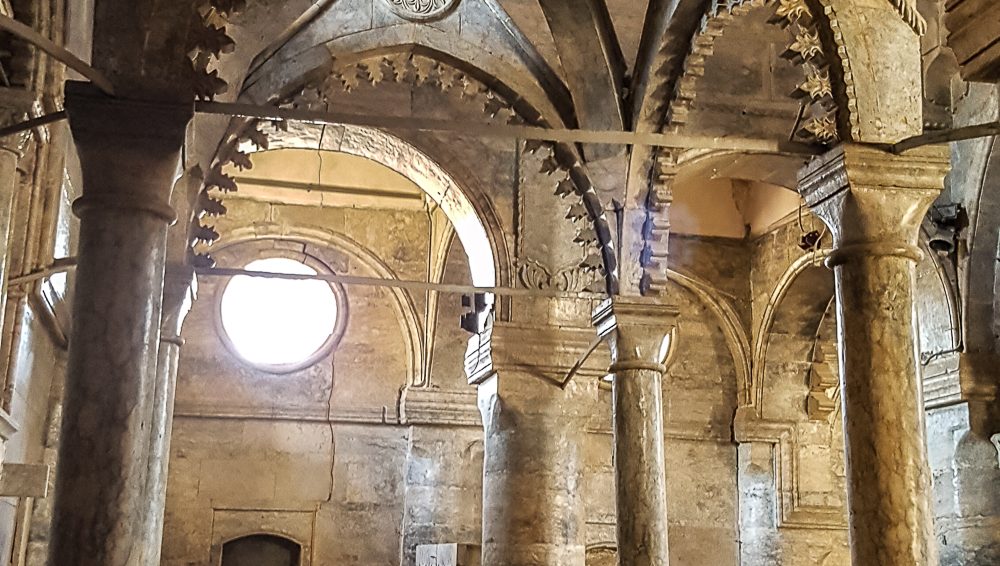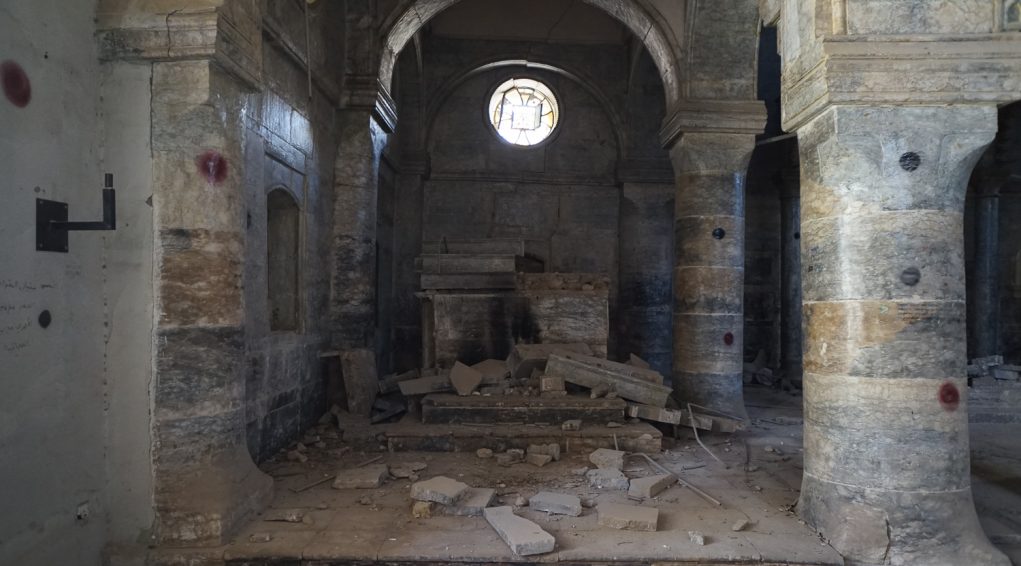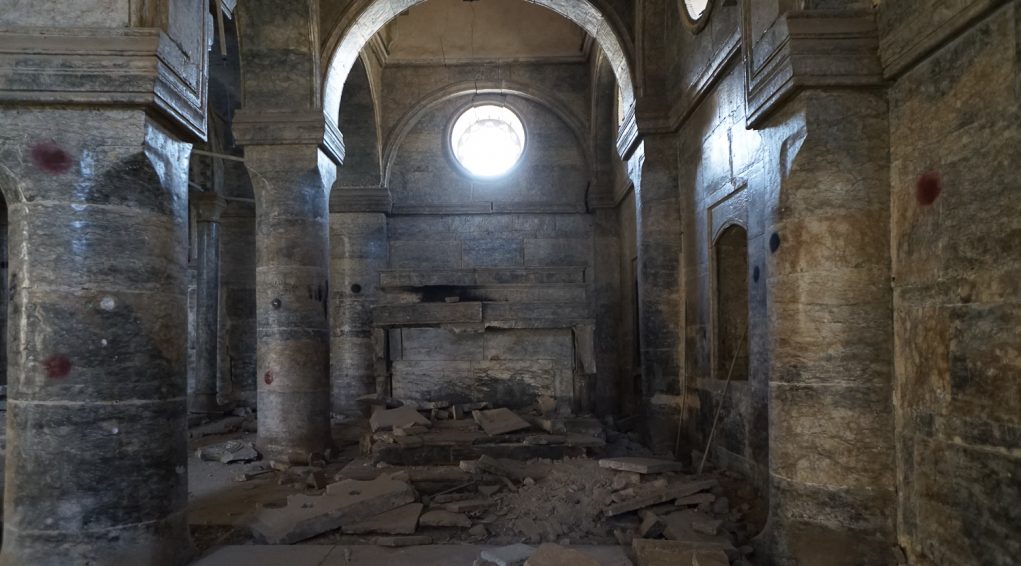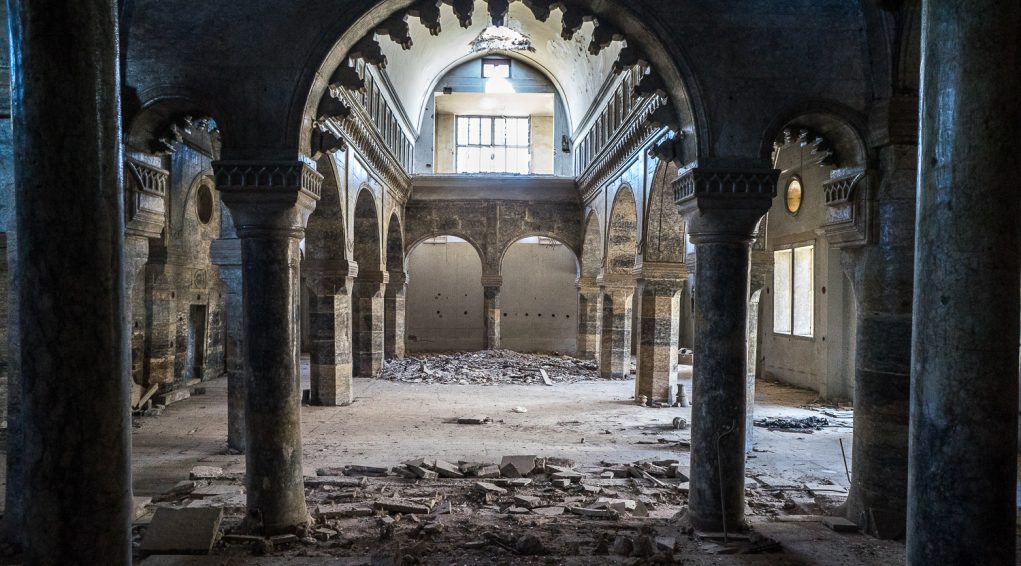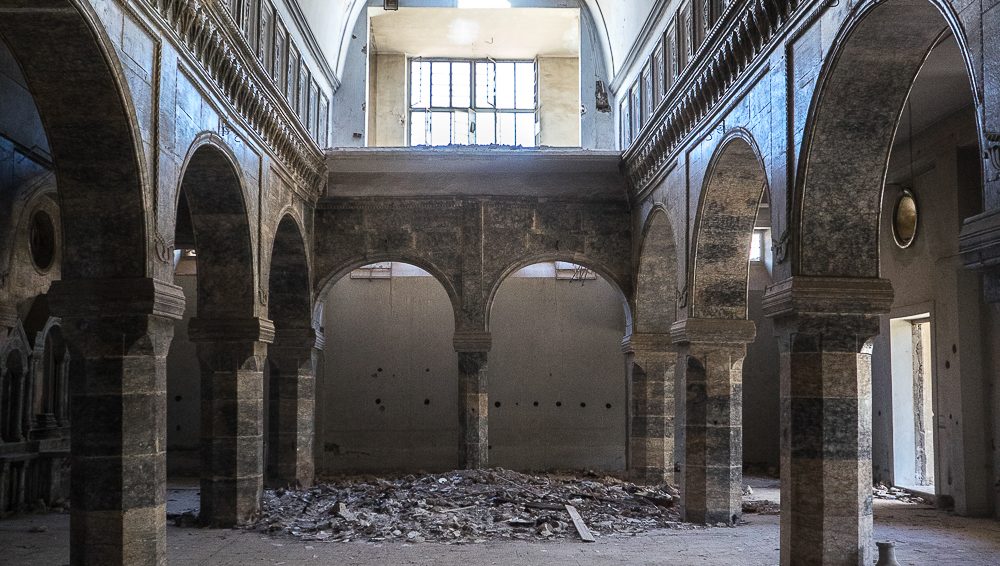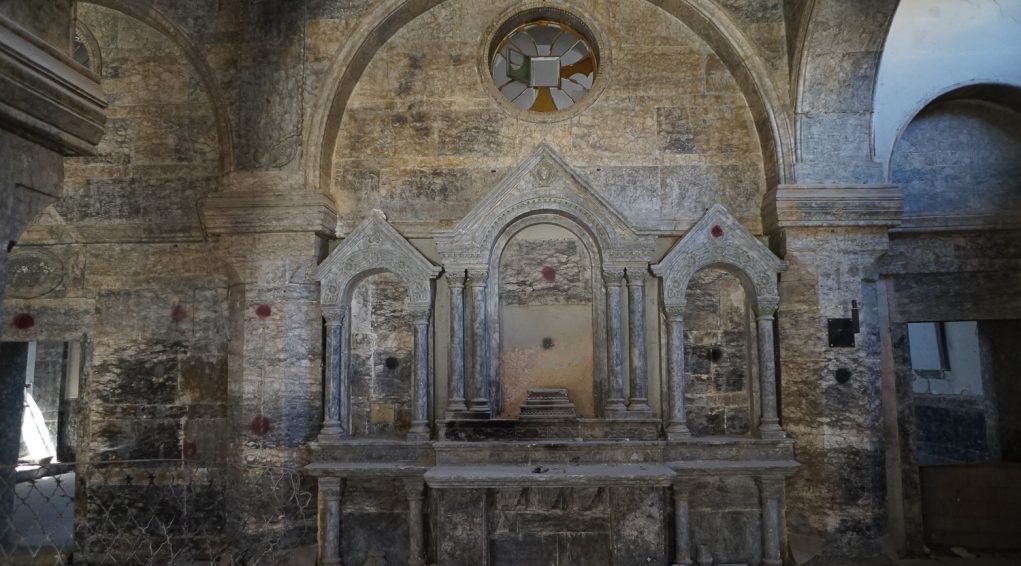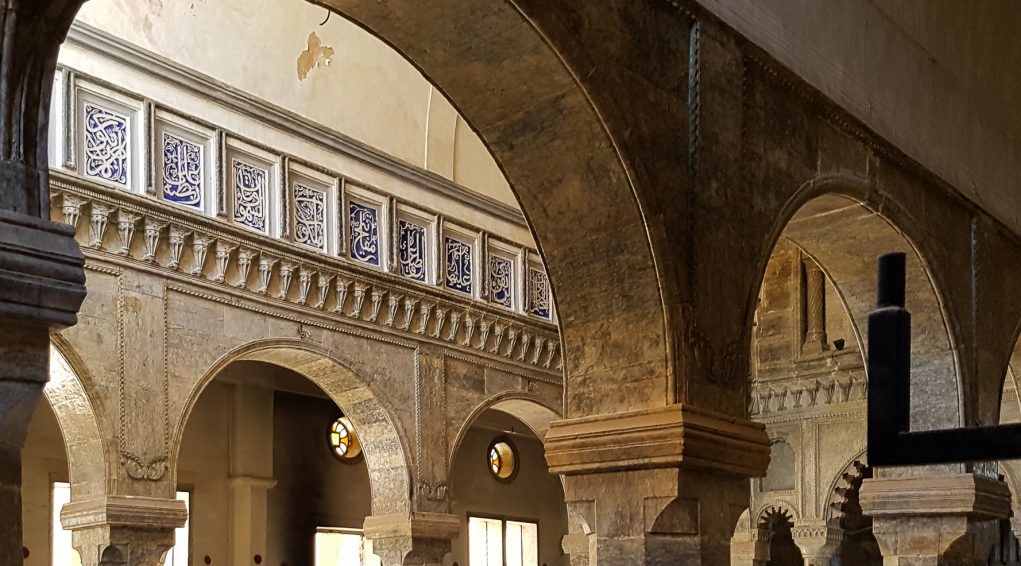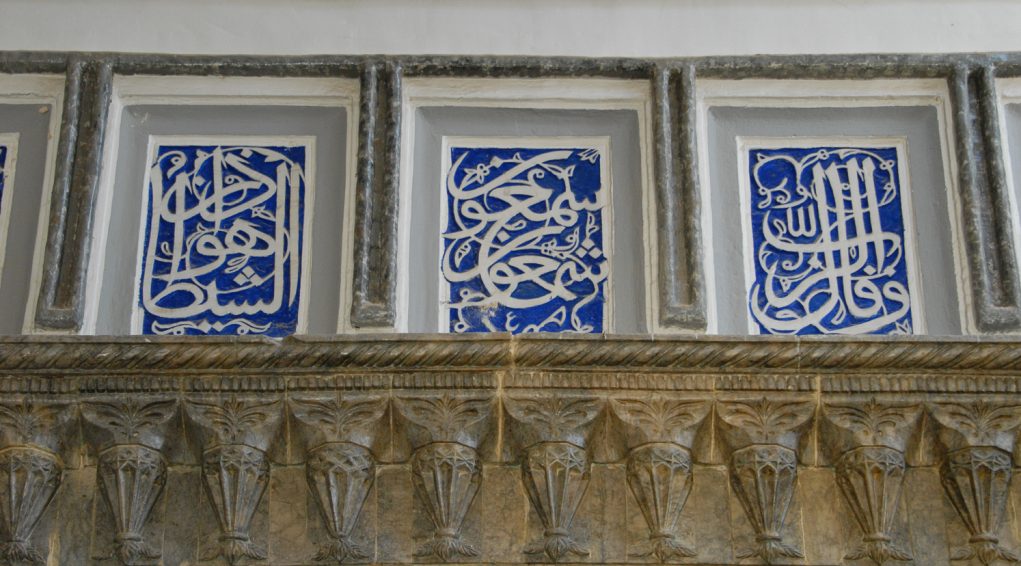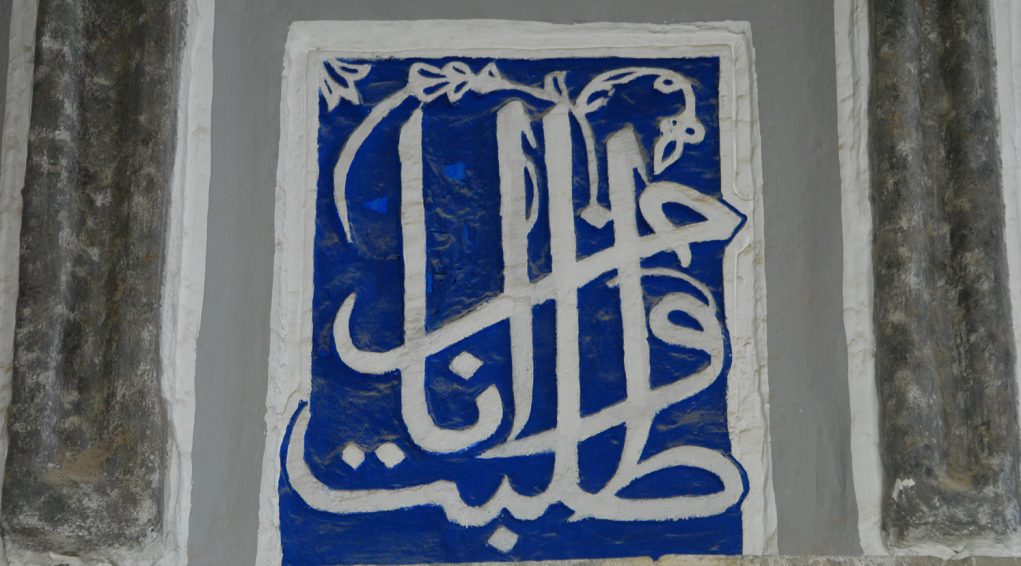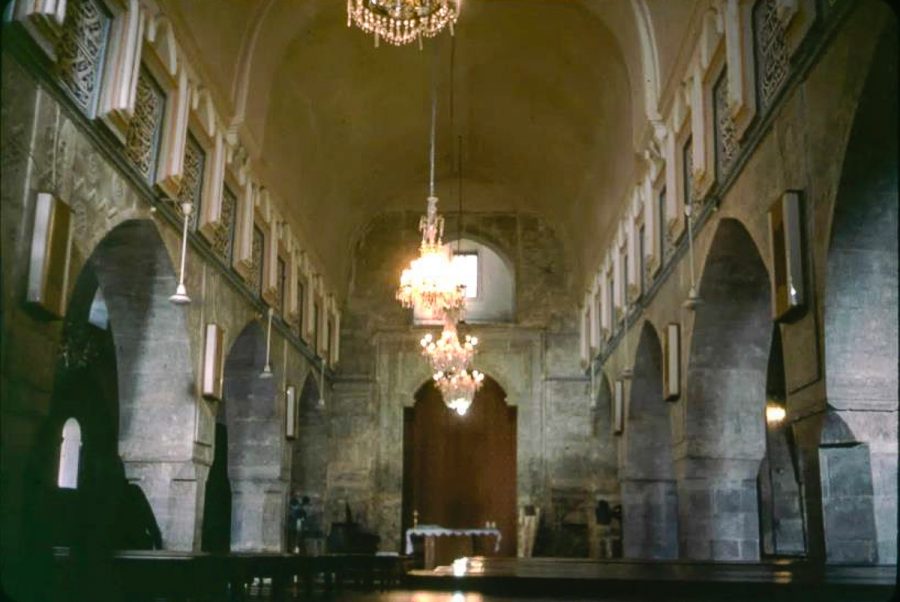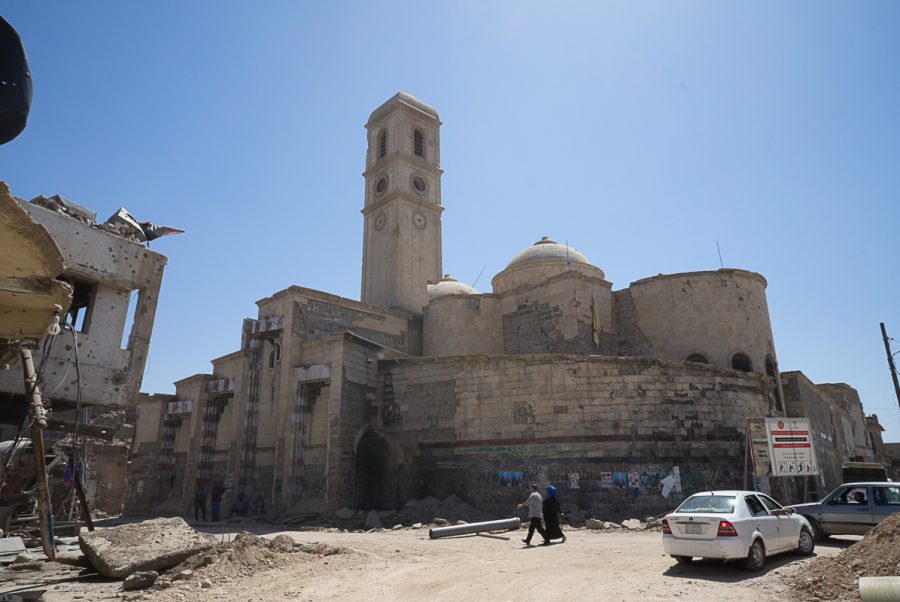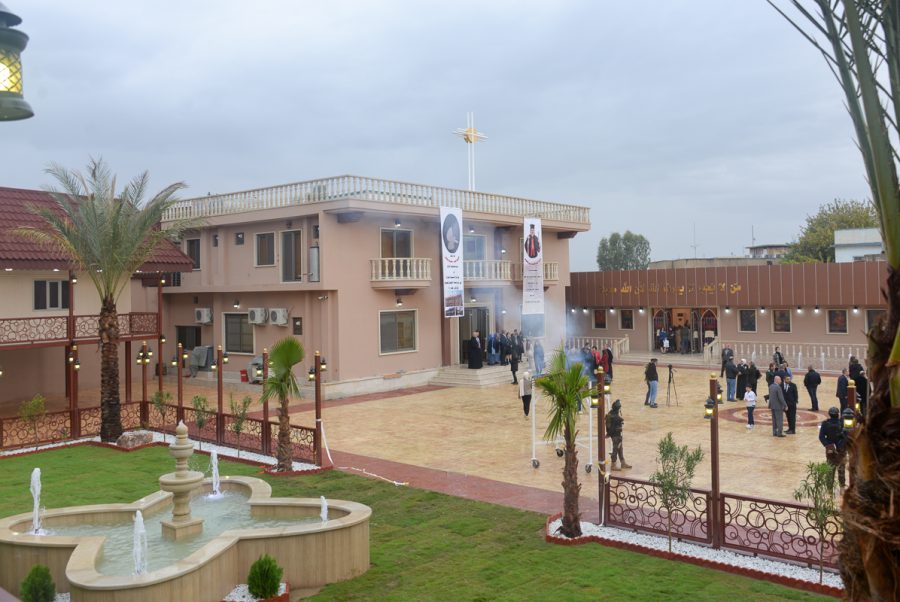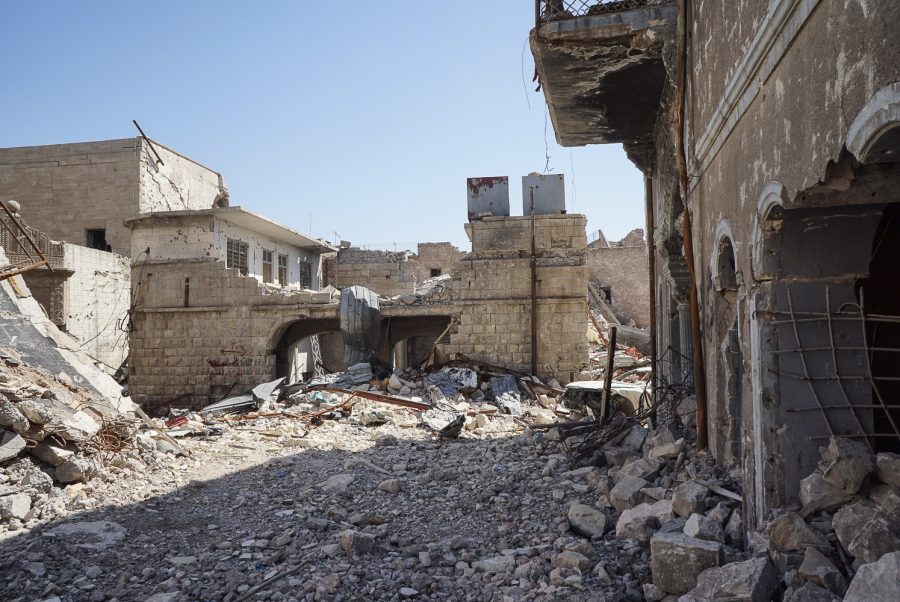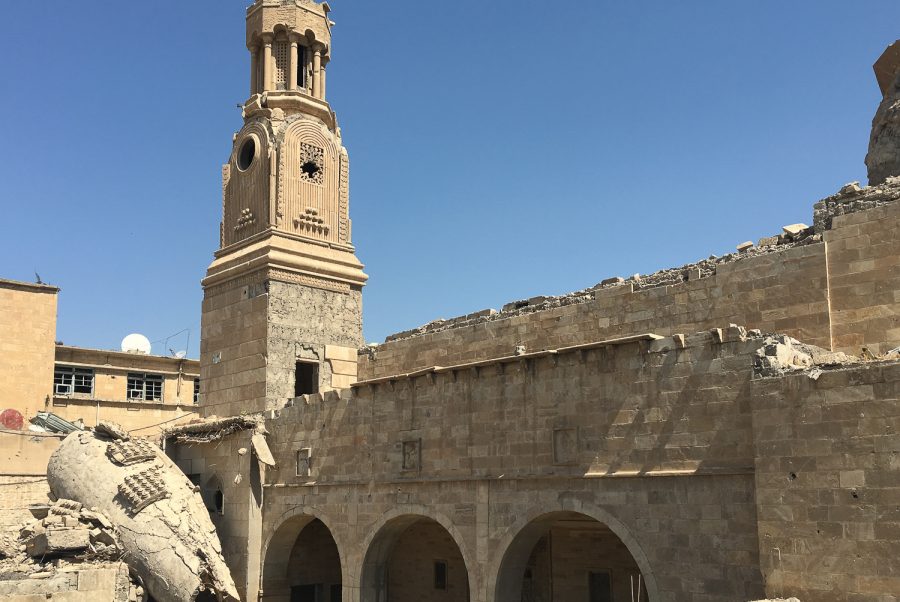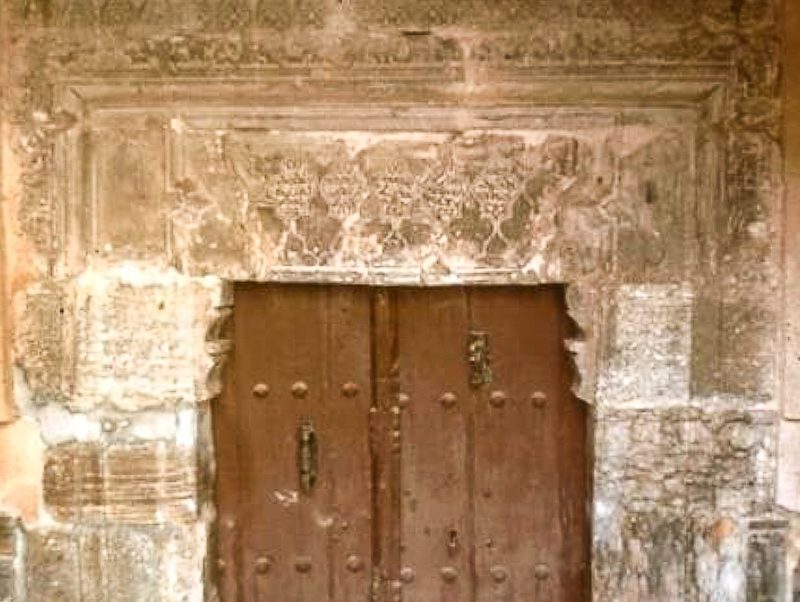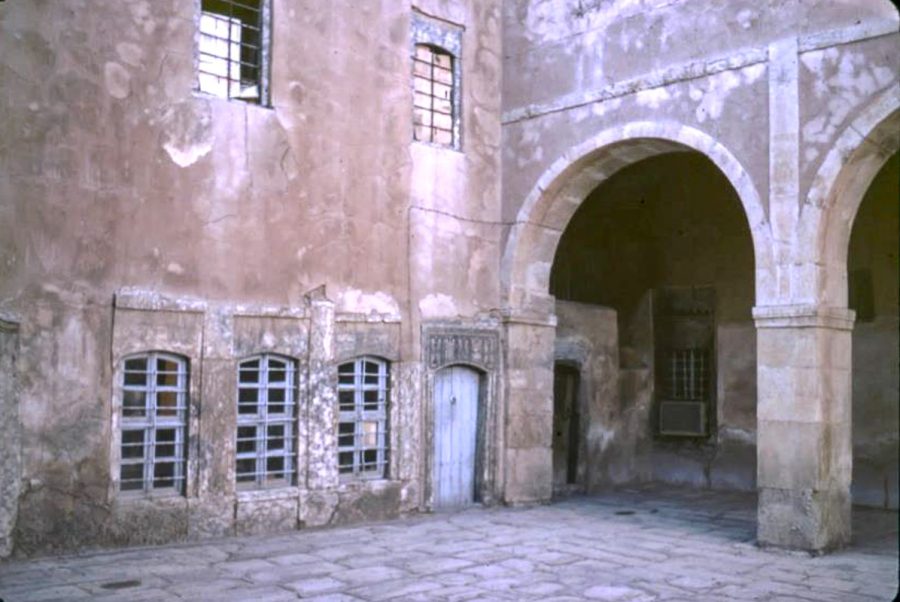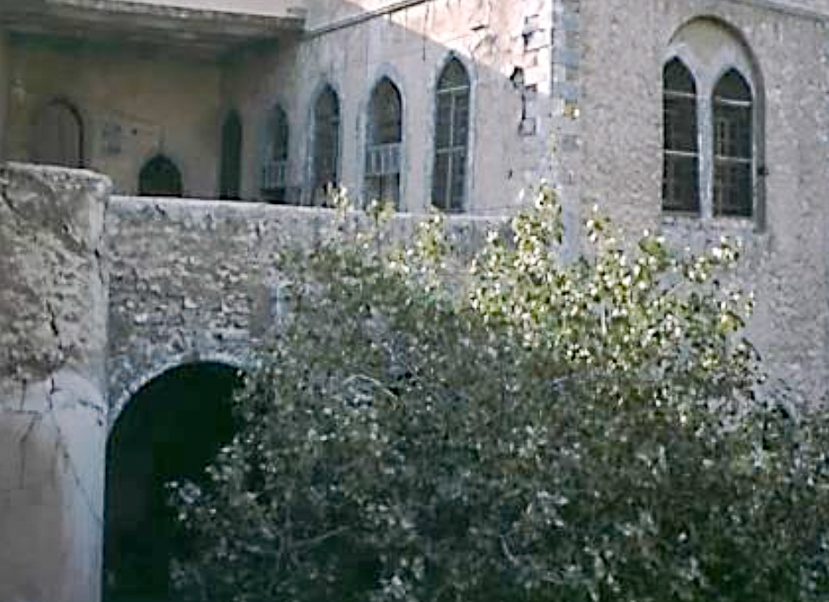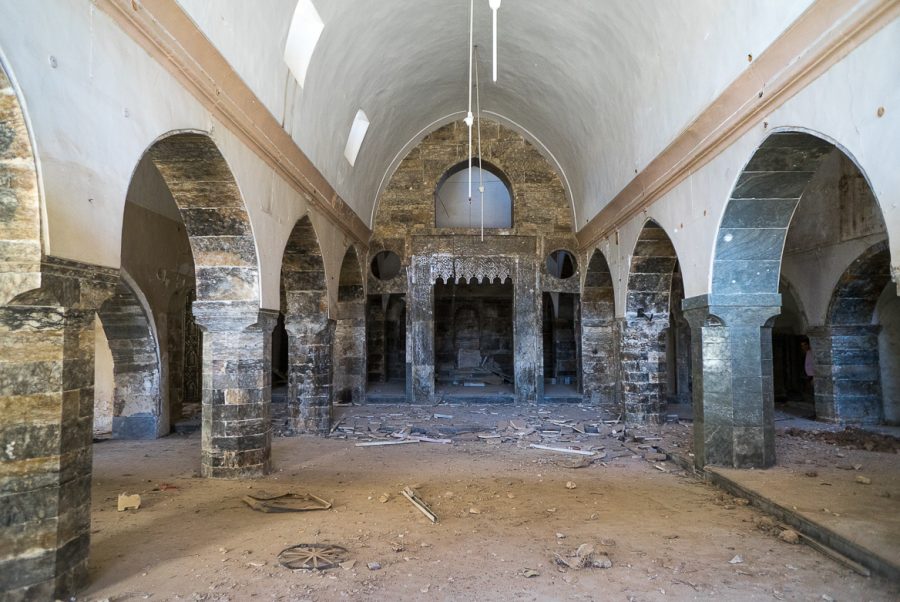The Mar Touma Syriac-Catholic Church in Mosul
The Mar Touma Syriac-Catholic church is located at 36°20’28.71″N 43° 7’31.04″E and 235 metres’ altitude,in the old city of Mosul, formerly designated by the Ottoman city walls, on the western bank of the Tigris, opposite ancient Nineveh.
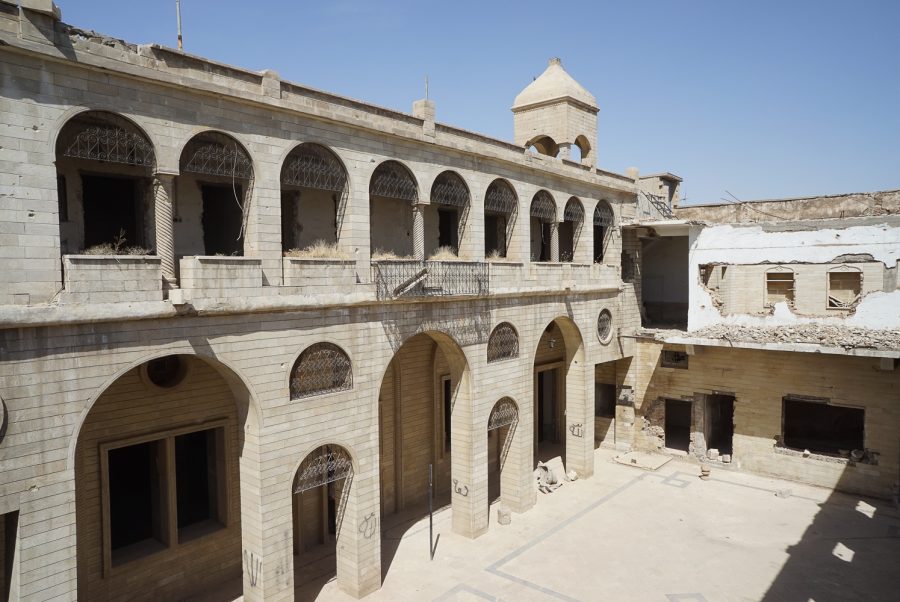
Built in just three years and consecrated on the feast day of the Annunciation, on 25th March 1863, the Mar Touma Syriac-Catholic church is characteristicsof Syriac sacred architecture.
The focus of intense pastoral activity, it was the living place for the community of priests of Christ the King created in 1962. Its founders wanted to lead a consecrated life a community, in poverty, working to support young people. They founded the famous review La Pensée Chrétienne, the Centre for Biblical Studies, as well as a museum and library.
ISIS clearly intended to blow up the Mar Touma Syriac-Catholic church and had marked out with black and red circles the places where the explosives should be positioned on the pillars in the nave and the sanctuary. Fortunately, it would appear that they ran out of either time or resources and did not put their plan into action.
Since the liberation of Mosul at the end of June 2017, the Mar Touma Syriac-Catholic church has been cleaned and partially renovated.
| Pic : The Mar Touma Syriac-Catholic church in Mosul. June 2018 © Pascal Maguesyan / MESOPOTAMIA |
Location
The Mar Touma Syriac-Catholic church is located at 36°20’28.71″N 43° 7’31.04″E and 235 metres’ altitude, in the old city of Mosul, formerly designated by the Ottoman city walls, on the western bank of the Tigris, opposite ancient Nineveh, 400 kilometres to the north of Baghdad.
Origins of the Syriac-Catholic church
The Syriac tradition attributes the evangelization of Mesopotamia to the apostle Thomas and his disciples Addai and Mari, however, “it seems that the introduction of Christianity in fact goes back only to the beginning of the 2nd century and that it was conducted under the influence of Judaeo-Christian missionaries from Palestine.[1]” This Mesopotamian Christianity started organizing itself in Seleucia-Ctesiphon, on the banks of the Tigris river, 30 km south from Baghdad, where the tradition reports that Saint Thomas made a halt on his way towards India. And it is right here, on a hill of the Koghe district, that the first patriarchal church of the Church of Mesopotamia was built and its catholicate was then established. This Syriac-language-based primitive Christianity still nowadays form the shared foundation of the local Iraqi churches and of their communities, which perpetuate this Christianity’s heritage and handover.
This shared foundation gradually broke up into a plurality of churches from the Council of Nicea in the 4th century up until the 20th century for geopolitical, rather than Christological reasons.
Indeed, the first ecumenical Council of Nicea in 325, convened by the Roman Emperor Constantine I, was held without the Persian bishops, except from Jacob of Nisibis, as “it was out of the question to the other bishops, in times of never-ending or nearly never-ending war, to go and sit in an assembly held in an enemy country, convened – and even more presided – by the Roman Emperor.[2]” It should be said that from the Constantine’s conversion to Christianity on, the Sassanian Emperor Shapur II turned from tolerance to mistrust regarding the Persian Christians. This mistrust even turned to hostility: “The aim of the persecution was not to annihilate the Christians but to force them to abjure their faith, once their hierarchy had been wiped out.[3]”
A century later, in 431, the Council of Ephesus sentenced the Patriarch of Constantinople Nestorius, who professed the two distinct natures of Christ (hypostasy): one divine, son of God, and one human, son of Mary. This Christological thesis was considered as heretic and Nestorius was removed from office. Due to geopolitical rivalries between the Roman Empire and the Persian Sassanian Empire, the Church of the East turned to Nestorianism from the second half of the 5th century on, and it spread throughout Mesopotamia, Persia and up to India.
Twenty years later, in 451, the Council of Chalcedon came up with a new Christological controversy. The Syriac, Egyptian, Ethiopian and Armenian Churches were blamed for professing a monophysite theory, i-e that within the person of Jesus Christ, the human nature was absorbed into the divine nature. Christ only has one divine nature.
In the 6th century, Saint Jacob Baradaeus, a Syriac monk, reorganised the Syriac church. After his episcopal ordination, he travelled to all the Syriac regions to ordain numerous bishops, priests and deacons. It was in his honour that the Syriac church was known as “Jacobite”. This (Orthodox) church split in the 18th century, in 1783, which gave birth to the Syriac-Catholic church in communion with Rome.
_______
[1] In “Vie et mort des chrétiens d’Orient. Des origines à nos jours”, Jean-Pierre Valogne, Fayard, March 1994, p.737
[2] In “Histoire de l’Église de l’Orient”, Raymond le Coz, Éditions du Cerf, September 1995, p. 31.
[3] In “Histoire de l’Église de l’Orient”, Raymond le Coz, Éditions du Cerf, September 1995, p. 32.
Fragments of Christian history in Mosul
Mosul[1] “remains a Christian metropolis,”[2] as attested by its history, and its ancient and modern heritage, which persists despite the recent catastrophic events.
Although the first archdiocese is attested to in 554[3], it is also important to take into account the Paleo-Christian apostolic tradition. “Three churches are proud to be founded on houses where apostles are said to have stayed. The Sham’ûn al-Safa’ church, [built during the Atabeg period in the 12th – 13th centuries] is said to be built where Saint Peter stayed during his visit to Babylonia and the Mar Theodoros church is connected to the visit of the apostle Bartholomew. As for the apostle Saint Thomas, the house where he was shown hospitality on his journey to India, became a church.”[4] The church in question is the Syriac-Orthodox church Mar Touma.
The first church attested to in Nineveh (modern-day Mosul-East) dates back to the year 570. It is mentioned in the “Chronicle of Seert”. It is the Isha’ya church. This confirms a pre-existing Christian community. In the 7th century the Syriac-Orthodox Mar Touma church was also known of. From the 7th century onwards, the Mar Gabriel monastery was the seat of one of the Church of the East’s most important schools of theology and liturgy. The al-Tāhirā Chaldean church was built on the site of this monastery in the 18th century.[5]
Over the centuries, through successive councils and conflicts, a multitude of churches of different denominations, including the Armenian and Latin churches, were formed.
Of these various fragments of history, the Muslim conquest must be cited as one of the most important. Mosul fell in 641 and the Christian members of its population became dhimmis, with (limited) rights and (stringent) obligations based on their religious identity. This status remained in force up until the 19th century and was abolished in the Ottoman Empire in 1855. Despite this abolition, Christians (and Jews) still remain defined by their dhimmi status which governs denominational relations in public life and attitudes in almost all Muslim countries. It is still legally enforced (in Iran).
In the 7th and 13th centuries, at the height of the Seljuq period, the Atabeg dynasties imposed their rule throughout Iraqi Mesopotamia and made Mosul a centre of power. At this time, Syriac-Orthodox Christians persecuted in Tikrit fled to the Nineveh plain and Mosul, where they established their community and founded the Mar Ahûdêmmêh (Hûdéni) church. “At the end of the 20th century due to below-ground flooding throughout the neighbourhood, the Mar Hûdéni church located well below ground level was flooded and had to be abandoned. A new church was built right on top of the old one. Thankfully, the royal door in the Atabeg style, described by Father Fiey as a “jewel of 13th century Christian sculpture”, was transported to the new church and given pride of place.”[6]
Following on from the Atabeg, the Mongol Houlagou Khan, took Mosul but spared the city from destruction and from the massacres committed in Baghdad in 1258, thanks to the “cunning governor of the city, Lû’lû, of Armenian origin.”[7] The following century was nonetheless a tragic one. “Christian persecutions peaked under Tamerlan, whose armies ravaged the Middle East in the first years of the 14th century and exterminated the Christian populations. No other eastern Christian church underwent anything close to this type of eradication, the community in Iraq is well placed to claim the first prize in martyrdom.”[8]
In 1516, Mosul fell into the hands of the Ottoman Turks for the first time, but it was not until the following century that they established a dominant presence in Iraqi Mesopotamia that was to last for four centuries after the conquest of Baghdad in 1638 by the Sultan Murad IV.
Mosul in the 16th century was a major centre of Christian influence. It was here that the schism of the Church of the East took place, with the election of Yohannan Sulaqa as the first patriarch of the Chaldean church Abbot of Rabban Hormizd Monastery in Alqosh, he took on the name Yohannan/John VIII and went to Rome to profess his Catholic faith. On 20th April 1553, Pope Julius III appointed him Patriarch of the Chaldean Catholic church “whose creation was thus officialised.”[9] After Diyarbakır (in the south-east of modern-day Turkey) and before Baghdad (in 1950), the seat of the Chaldean church was established in Mosul in 1830, with the election of Jean VIII Hormez as the metropolitan of Mosul.
In 1743, the Christians of Mosul played an active role in defending the city during the 42-day siege laid by the Persian Nâdir Shâh who had already looted and ransacked the plain of Nineveh. Victorious and grateful, the pasha of Mosul, Husayn Djalîlî “obtained a firman from Constantinople favourable to the churches of Mosul.”[10] In 1744, the two al-Tāhirā churches were built in Mosul, one for the Chaldeans, one for the Syriac-Catholics (the latter was restored and rebuilt). The churches damaged by bombs were also restored.
After the schism in the Syriac church (Orthodox Jacobite) in 1783 and the creation of the Syriac-Catholic church, there was a conflict between the Syriac-Othodox and Syriac-Catholic churches regarding ownership and use of the church buildings. This conflict was resolved in Mosul by building two new churches, al-Tahira and Mar Touma, in 1862 and publishing an Ottoman firman (decree) in 1879 dividing the assets and ownership of churches and monasteries between the two denominations. The first Syriac-Catholic bishop in the diocese of Mosul was Quorls Bchara Bhnam Akhtal (1760-1828).
The 17th century marked the opening of the Latin missions in Iraqi Mesopotamia. The Capuchin Friars open their first house in Mosul in 1636. The Dominicans of the Province of Rome arrived in 1750, followed by those from the Province of France in 1859. Under their impulsion, the large Latin church Our Lady of the Hour, was built “in the Byzantine style, between 1866 and 1873.”[11]This is the church to which the empress Eugénie de Montijot, wife of Napoleon III, donated the famous clock which was placed in the first clock tower ever built in Iraq. For almost three centuries, members of the Dominican mission for Mesopotamia, Kurdistan and Armenia, have been actors, experts and vital witnesses to the history of Christianity in Iraq.
A turning point came in 1915-1918 with the genocide of the Armenians, Assyrians and Chaldeans in the Ottoman Empire. Large numbers of survivors came to live in Iraqi Mesopotamia, specifically in Mosul where there were pre-existing Christian communities. During this period, in January 1916 over just two nights, 15,000 Armenian deportees living in Mosul and the surrounding area were exterminated, tied together in groups of ten and thrown into the Tigris river. Already, well before this carnage, on 10th June 1915, the German consul to Mosul, Holstein, telegraphed his Ambassador, reporting telling scenes: “614 Armenians (men, women and children) expulsed from Diarbekyr and transported to Mosul, were all killed en route, as they were transported by raft (on the Tigris). The kelek arrived empty yesterday. For a few days now the river has been carrying corpses and human limbs (…)”[12]
The fall of Saddam Hussein in 2003 and the rise of Islamic fundamentalism and associated criminal activity, had a considerable impact on the demographic collapse of Christian communities in Iraq, particularly in Mosul. On 1st August 2004, simultaneous attacks against five churches in Mosul and Baghdad triggered the mass exodus of the Christians of Mosul to protected areas in the Nineveh plain, Iraqi Kurdistan and overseas. The next few years in Mosul were truly harrowing. The targeted kidnapping and murders of Christians exacerbated the exodus. On 6th January 2008, Epiphany, and 9th January, criminal attacks targeted several Christian buildings in Mosul and Kirkuk.
It was in this climate of terror that Monsignor Paulos Faraj Rahho, the Chaldean archbishop of Mosul was kidnapped. “On 13th February 2008, as he welcomed a delegation from Pax Christi, in the church in Karemlash, right next to Mosul, the prelate revealed that he had been threatened by a terrorist group several days previously, “Your life or five hundred thousand dollars,” the terrorists told him. “My life is not worth that!” he replied. One month later, on 13th March, Monsignor Rahho was found dead at the entrance to the city.”[13]
From June 2014 to July 2017, Mosul fell into the hands of ISIS fighters. The houses of the 10,000 or so Christians still living in the city were marked with the sign Nazrani (Nazarean, i.e. disciples of Jesus). They were ordered to convert to Islam, pay the djizia (the tax on dhimmi) or die. They fled the city hastily and en masse but had to abandon their Christian heritage which was extensively looted, vandalised and desecrated. In addition to this targeted destruction, further damage was inflicted during the battle for Mosul. The bombing by the international coalition which pulverised the ISIS fighters in a deluge of fire, also reduced some of Mosul’s largest Christian (and Muslim) buildings to dust.
_______
[1] This chapter is largely based on the work of Brother Jean-Marie Mérigoux [1] o.p. who lived in Iraq for 14 years from 1969 to 1983 as part of the Dominican mission for Mesopotamia, Kurdistan and Armenia, based in Mosul. See, two books by Brother Jean-Marie Mérigoux, in particular: « Va à Ninive ! Un dialogue avec l’Irak », Éditions du Cerf, October 2000; and « Entretien sur l’Orient chrétien », Éditions La Thune, Marseille, July 2015.
[2] In “Entretien sur l’Orient chrétien”, Jean-Marie Mérigoux. Éditions La Thune, Marseille, 2015, p.88
[3] In “Assyrie chrétienne”, vol.II, Jean-Maurice Fiey. Beirut, 1965. P. 115-116. See also “Mossoul chrétienne” by Jean-Maurice Fiey.
[4] In “Entretien sur l’Orient chrétien”, Jean-Marie Mérigoux. Editions La Thune, Marseille, 2015, p. 89
[5] In “Entretien sur l’Orient chrétien”, Jean-Marie Mérigoux. Editions La Thune, Marseille, 2015, p. 92-93
[6] In “Entretien sur l’Orient chrétien”, Jean-Marie Mérigoux. Editions La Thune, Marseille, 2015, p. 94
[7] In “Entretien sur l’Orient chrétien”, Jean-Marie Mérigoux. Editions La Thune, Marseille, 2015, p. 95
[8] In “Vie et mort des chrétiens d’Orient”, Jean-Pierre Valogne, published by Fayard, 1994, p.740
[9] In “Histoire de l’Église de l’Orient”, Raymond le Coz, Éditions du Cerf, 1995, p. 328
[10] In “Entretien sur l’Orient chrétien”, Jean-Marie Mérigoux. Editions La Thune, Marseille, 2015, p. 97
[11] In “Entretien sur l’Orient chrétien”, Jean-Marie Mérigoux. Editions La Thune, Marseille, 2015, p. 102
[12] In “L’extermination des déportés arméniens ottomans dans les camps de concentration de Syrie-Mésopotamie”. Special edition of Revue d’Histoire Arménienne Contemporaine, Tome II, 1998. Raymond H.Kevorkian. p.15
[13] In “Chrétiens d’Orient : ombres et lumières”, by Pascal Maguesyan, Éditions Thaddée, September 2013, latest edition 2014, p. 260
History of the Mar Touma Syriac-Catholic church in Mosul
The first stone of the Mar Touma Syriac-Catholic church in Mosul was laid on 1st April 1860 at the time of the Patriarch Antoine I Semherie. The work took three years and finished before Christmas 1862 which was celebrated in the church. The church was officially consecrated on the feast day of the Annunciation, on 25th March 1863.
In the 1950s, the Mar Touma Syriac-Catholic church suffered a partial collapse due to the cemetery in the courtyard. Major maintenance work took place over the summer of 1959, overseen by Father Mikhael Sayegh. The left wing was rebuilt and an additional floor was added in the spring of 1960 to make space for bedrooms for the priests, a living room and dependences.
Further maintenance work and improvements took place from 1984-1987, under the supervision of Father Nomaan Awrida in the Chapel of the Virgin Mary, under the dome and bell tower. The ceiling was consolidated, new arches added and the facade on the courtyard side renovated.
In 1995, neighbouring houses were acquired and destroyed to make room to build a car park.
The Mar Touma church school was renovated.
A museum was also created, which became one of the most important monuments in Mosul, as well as a trace of Mosulite architecture.
The work to embellish the facade of the church and the museum took place over spring 2004.
The Mar Touma Syriac-Catholic church in Mosul, a hub of intense pastoral activity
The Mar Touma Syriac-Catholic church in Mosul was a hub of intense pastoral activity, particularly as of 1962 and up until the arrival of ISIS in 2014.
The Mar Touma Syriac-Catholic church in Mosul is where the community of priests of Christ the King was founded (18th September 1962). Four priests founded the community including Abouna Pios Affas, archpriest of the Mar Touma church from 1964 to 2014. The founders wanted to lead a consecrated life as a community, in poverty, working to support young people. “It was an entirely new idea. The bishop of Mosul was in agreement. Providentially, the community house was set up in the Mar Touma church where there were rooms available (…) It had a profound impact on the population.” [1]
In 1964, the community of priests of Christ the King also created the review La Pensée Chrétienne, the Centre of Biblical Studies, a museum and a library.
- Created in 1964, “the first edition of La Pensée Chrétienne ran to 16 pages, 2,550 copies were printed. For six years, up until 1971, the review developed offering more pages and more information. In 1971, the review was enriched with an editorial, opinion pieces and news on the lives of churches all around the world.”[2] Renowned for its much-criticised avant-garde editorial line in the spirit of Vatican 2, inspired by the French journal Témoignage Chrétien, the review La Pensée Chrétienne was handed over to the Dominicans in 1995.
- The Centre of Biblical Studies was launched in 1987 but was officialised in 1991. The curriculum took the form of a 4-year cycle, with courses delivered one day a week. The arrival of ISIS in 2014, forced the Centre of Biblical Studies to relocate to Ankawa. In June 2018, 52 students graduated from the centre.
- The museum was inaugurated on 13th September 1996 and underwent constant development up until the arrival of ISIS. Composed of several thematic pavilions, it was the first of its kind in Mosul to display manuscripts, ancient liturgical items, archive documents, oil paintings, embroidered fabrics, liturgical clothing, traditional costumes, furniture and household utensils. This museum progressively became a conservatory of Mosulite heritage. The objects on display include glasses, crosses, thuribles, cymbals, copper and glass vases, silver plates. There is also a richly engraved cross dating from 1774 and the golden reliquary of Mar Touma. The documents on display include charitable acts of association and accounting documents from 1871. The most important oil painting, representing Mar Touma, dated from 1850. There is also a pavilion created in 2005 on the 30th anniversary of the review La Pensée Chrétienne, as well as the gold model awarded by the UCIP (Catholic International Press Union) in 2007. Finally, there is a pavilion created in 2012, on the 50th jubilee of the ordination of the founders of the community of priests of Christ the King.
- A former school was reconverted into a library next to the church. It notably contains “120 manuscripts which spread across ten centuries”[3] in Syriac and Garshouni Arabic, but also more than 400 books in Arabic and Syriac. There is also a Latin and Arabic version of the Torah dating from 1671, originally from Rome. Part of the Museum of Mosul Heritage, this library was destroyed by ISIS. Most manuscripts were burned. Others were stolen. Some were saved from the disaster by brave local residents and are gradually being returned.
_______
[1]Abouna Pios Affas, co-founder of the community of priests of Christ the King, archpriest of the Mar Touma church from 1964 to 2014. Extracts of an interview in Ankawa on 2nd June 2018.
[2] Abouna Pios Affas, archpriest of the Mar Touma church from 1964 to 2014. Extracts of an interview in Ankawa on 2nd June 2018.
[3] Id.
Description of the Mar Touma Syriac-Catholic church in Mosul
The Mar Touma church is entered via the men’s and women’s doors under the gallery on the courtyard side.
The style of the church is characteristic of sacred Syriac architecture. Its triple-nave basilica structure with barrel vault is supported by eight freestanding octagonal pillars and embedded pillars.
The magnificent royal door in Mosul marble with sculpted bas-relief is a genuine masterpiece. Supported by cylindrical pillars, it is mounted with cornice with modillions, above which is a tympanum formed of arches on colonettes and acanthus-leaf rosettes.
The high altar in the sanctuary, destroyed by ISIS, was mounted with a very elegant marble canopy – “like Moses’ tent in the desert”[1] – the arches of which are also decorated with acanthus leaves. Above is a cupola supported by squinches forming a muqarnas (honeycomb). Behind this canopy, backed up against the wall of the sanctuary, the ornamental structure of the primitive altar remains.
In the sanctuary, the side altars were destroyed by ISIS, as well as the funeral altars in the right-hand side aisle of the church.
Inside, the building contains a unique decorative feature. Either side of the nave, along the length of the cornice which runs above the arches, are a series of beautiful sculpted calligraphy paintings in Arabic. They are inscribed with verses from the gospels, notably “You are Peter, and on this rock I will build my Church (…)”
During the battle for Mosul, a rocket ripped through the roof of the church and damaged the vault at the far end of the nave. For three years during the occupation by ISIS, the ceilings and walls of the dependencies of the Mar Touma church were demolished. The vandals recovered the iron, electrical wires and any other useful materials found.
A bas-relief under the gallery of the courtyard showing Saint Thomas touching Christ’s side, also had chisel damage inflicted.
ISIS intended to blow up the Mar Touma Syriac-Catholic church and had marked out with black and red circles the places where the explosives should be positioned on the pillars in the nave and the sanctuary. Fortunately, it would appear that they ran out of either time or resources and did not put their plan into action.
Since the liberation of Mosul at the end of June 2017, the Mar Touma Syriac-Catholic church has been cleaned and partially renovated.
A special service was held in the church on 3rd July 2018, which was attended by around one hundred people.
Even more encouraging, local residents have started to return manuscripts. As the following testimony demonstrates: “I met a man. A bible stolen by a child. He kept it for four years, he brought it back to us. Another young man passed by the church by the fire, he was given. He collected a large amount of files and books. He kept them. He gave them back. Not everyone is ISIS .[2]
_______
[1] Abouna Pios Affas, co-founder of the community of priests of Christ the King, archpriest of the Mar Touma church from 1964 to 2014. Extracts of an interview in Ankawa on 2nd June 2018.
[2]Source Abouna Pios Affas, co-founder of the community of priests of Christ the King, archpriest of the Mar Touma church from 1964 to 2014. Extracts from an interview in Ankawa on 2nd June 2018.
Monument's gallery
Monuments
Nearby
Help us preserve the monuments' memory
Family pictures, videos, records, share your documents to make the site live!
I contribute
